ZyXEL Communications NBG6617 AC1300 MU-MIMO Dual-Band Wireless Gigabit Router User Manual Book
ZyXEL Communications Corporation AC1300 MU-MIMO Dual-Band Wireless Gigabit Router Book
Contents
- 1. User Manual Part 1 (1-98).pdf
- 2. User Manual Part 2 (99-105).pdf
User Manual Part 1 (1-98).pdf

Quick Start Guide
www.zyxel.com
NBG6617
AC1300 MU-MIMO Dual-Band Wireless
Gigabit Router
Version 1.00
Edition 2, 06/2016
Copyright © 2016 ZyXEL Communications Corporation
User’s Guide
Default Login Details
LAN IP
Address http://192.168.1.1
(Router Mode)
http://192.168.1.2
(Access Point Mode)
Password 1234

NBG6617 User’s Guide
2
IMPORTANT!
READ CAREFULLY BEFORE USE.
KEEP THIS GUIDE FOR FUTURE REFERENCE.
Screenshots and graphics in this book may differ slightly from your product due to differences in
your product firmware or your computer operating system. Every effort has been made to ensure
that the information in this manual is accurate.
Related Documentation
• Quick Start Guide
The Quick Start Guide shows how to connect the NBG6617 and access the Web Configurator
wizards. It contains information on setting up your network and configuring for Internet access.
• More Information
Go to support.zyxel.com to find other information on the NBG6617.

Contents Overview
NBG6617 User’s Guide
3
Contents Overview
User’s Guide .........................................................................................................................................9
Introduction .............................................................................................................................................10
Introducing the Web Configurator ...........................................................................................................15
eaZy 123 Wizard .....................................................................................................................................18
NBG6617 Modes .....................................................................................................................................27
Easy Mode ..............................................................................................................................................28
Router Mode ...........................................................................................................................................36
Access Point Mode .................................................................................................................................42
Tutorials ..................................................................................................................................................49
Technical Reference ..........................................................................................................................59
Status ......................................................................................................................................................60
WAN ........................................................................................................................................................62
Wireless LAN ..........................................................................................................................................80
LAN .........................................................................................................................................................99
Applications ...........................................................................................................................................104
Security .................................................................................................................................................129
Maintenance ..........................................................................................................................................135
Troubleshooting ....................................................................................................................................149

Table of Contents
NBG6617 User’s Guide
4
Table of Contents
Contents Overview ..............................................................................................................................3
Table of Contents .................................................................................................................................4
Part I: User’s Guide ........................................................................................... 9
Chapter 1
Introduction.........................................................................................................................................10
1.1 Overview ...........................................................................................................................................10
1.2 Applications .......................................................................................................................................10
1.3 Ways to Manage the NBG6617 ........................................................................................................10
1.4 Good Habits for Managing the NBG6617 ......................................................................................... 11
1.5 Resetting the NBG6617 .................................................................................................................... 11
1.5.1 How to Use the RESET Button ................................................................................................ 11
1.6 The WPS Button ............................................................................................................................... 11
1.7 LEDs .................................................................................................................................................12
1.8 Wall Mounting ...................................................................................................................................13
Chapter 2
Introducing the Web Configurator ....................................................................................................15
2.1 Overview ...........................................................................................................................................15
2.2 Accessing the Web Configurator .......................................................................................................15
2.2.1 Login Screen ...........................................................................................................................16
2.2.2 Change Default Password Screen ..........................................................................................16
Chapter 3
eaZy 123 Wizard..................................................................................................................................18
3.1 Overview ...........................................................................................................................................18
3.2 Accessing the eaZy 123 Wizard ........................................................................................................18
3.3 Internet Type .....................................................................................................................................20
3.3.1 WAN Selection Type: Automatic - DHCP ................................................................................21
3.3.2 WAN Selection Type: PPPoE ..................................................................................................21
3.3.3 WAN Selection Type: Static .....................................................................................................22
3.4 Wireless Network ..............................................................................................................................23
Chapter 4
NBG6617 Modes .................................................................................................................................27
4.1 Overview ...........................................................................................................................................27

Table of Contents
NBG6617 User’s Guide
5
4.1.1 Web Configurator Modes .........................................................................................................27
4.1.2 Device Modes ..........................................................................................................................27
Chapter 5
Easy Mode ...........................................................................................................................................28
5.1 Overview ...........................................................................................................................................28
5.2 What You Can Do .............................................................................................................................28
5.3 What You Need to Know ...................................................................................................................29
5.4 Navigation Panel ...............................................................................................................................29
5.5 Network Map .....................................................................................................................................29
5.6 Control Panel ....................................................................................................................................31
5.6.1 Wi-Fi ........................................................................................................................................32
5.6.2 Guest Wi-Fi ..............................................................................................................................33
5.6.3 Parental Control .......................................................................................................................34
5.6.4 Notification ...............................................................................................................................34
Chapter 6
Router Mode........................................................................................................................................36
6.1 Overview ...........................................................................................................................................36
6.2 Router Mode Status Screen ..............................................................................................................36
6.2.1 Navigation Panel .....................................................................................................................39
Chapter 7
Access Point Mode.............................................................................................................................42
7.1 Overview ...........................................................................................................................................42
7.2 What You Can Do .............................................................................................................................42
7.3 What You Need to Know ...................................................................................................................42
7.3.1 Setting your NBG6617 to AP Mode .........................................................................................43
7.3.2 Accessing the Web Configurator in Access Point Mode ..........................................................43
7.3.3 Configuring your WLAN and Maintenance Settings ................................................................44
7.4 AP Mode Status Screen ....................................................................................................................44
7.4.1 Navigation Panel .....................................................................................................................46
7.5 LAN Screen .......................................................................................................................................46
Chapter 8
Tutorials...............................................................................................................................................49
8.1 Overview ...........................................................................................................................................49
8.2 Set Up a Wireless Network Using WPS ............................................................................................49
8.2.1 Push Button Configuration (PBC) ............................................................................................49
8.2.2 PIN Configuration ....................................................................................................................50
8.3 Connect to NBG6617 Wireless Network without WPS .....................................................................51
8.3.1 Configure Your Notebook ........................................................................................................53
8.4 Using Guest SSIDs on the NBG6617 ...............................................................................................55

Table of Contents
NBG6617 User’s Guide
6
8.4.1 Configuring Security Settings of Guest SSIDs ........................................................................56
Part II: Technical Reference............................................................................ 59
Chapter 9
Status ...................................................................................................................................................60
9.1 Overview ...........................................................................................................................................60
9.1.1 What You Can Do ....................................................................................................................60
9.2 Client Tables Screen .........................................................................................................................60
Chapter 10
WAN .....................................................................................................................................................62
10.1 Overview .........................................................................................................................................62
10.2 What You Can Do ...........................................................................................................................62
10.3 What You Need To Know ................................................................................................................62
10.3.1 Configuring Your Internet Connection ....................................................................................63
10.4 Internet Connection Screen ............................................................................................................65
10.4.1 IPoE Encapsulation ...............................................................................................................65
10.4.2 PPPoE Encapsulation ...........................................................................................................70
10.5 NAT .................................................................................................................................................74
10.5.1 General Screen .....................................................................................................................74
10.5.2 Port Trigger Screen ...............................................................................................................76
10.5.3 Passthrough Screen ..............................................................................................................77
10.6 Dynamic DNS Screen .....................................................................................................................78
Chapter 11
Wireless LAN.......................................................................................................................................80
11.1 Overview .........................................................................................................................................80
11.1.1 What You Can Do ..................................................................................................................81
11.1.2 What You Should Know .........................................................................................................81
11.2 Wireless Screen .............................................................................................................................85
11.3 Wireless Security .............................................................................................................................87
11.3.1 No Security ............................................................................................................................87
11.3.2 WPA-PSK/WPA2-PSK ...........................................................................................................88
11.3.3 WPA/WPA2 ............................................................................................................................89
11.4 Guest Wireless Screen ....................................................................................................................91
11.4.1 Guest Wireless Edit ...............................................................................................................92
11.5 MAC Filter Screen ..........................................................................................................................93
11.6 Advanced Screen ............................................................................................................................94
11.7 WPS Screen ....................................................................................................................................96
11.8 Scheduling Screen ..........................................................................................................................97

Table of Contents
NBG6617 User’s Guide
7
Chapter 12
LAN ......................................................................................................................................................99
12.1 Overview .........................................................................................................................................99
12.2 What You Can Do ...........................................................................................................................99
12.3 What You Need To Know ................................................................................................................99
12.4 LAN IP Screen ..............................................................................................................................100
12.5 Static DHCP Screen ......................................................................................................................101
12.6 IPv6 LAN Screen ...........................................................................................................................102
Chapter 13
Applications ......................................................................................................................................104
13.1 Overview .......................................................................................................................................104
13.1.1 What You Can Do ................................................................................................................104
13.1.2 What You Need To Know .....................................................................................................104
13.1.3 Before You Begin .................................................................................................................106
13.2 Parental Control ............................................................................................................................106
13.2.1 General Screen ...................................................................................................................106
13.2.2 Notification Screen .............................................................................................................. 110
13.3 Bandwidth Management ............................................................................................................... 112
13.3.1 General Screen ................................................................................................................... 113
13.3.2 Advanced Screen ................................................................................................................ 113
13.4 USB Media Sharing Screen .......................................................................................................... 117
13.5 UPnP Screen ................................................................................................................................ 118
13.6 File Sharing ................................................................................................................................... 119
13.6.1 SAMBA Server Screen ........................................................................................................120
13.6.2 FTP Server Screen ..............................................................................................................121
13.6.3 Example of Accessing Your Shared Files From a Computer ...............................................123
13.7 ONE Connect Screen ....................................................................................................................126
13.8 Technical Reference ......................................................................................................................127
Chapter 14
Security..............................................................................................................................................129
14.1 Overview .....................................................................................................................................129
14.1.1 What You Can Do ................................................................................................................129
14.1.2 What You Need To Know .....................................................................................................129
14.2 IPv4 Firewall Screen ....................................................................................................................130
14.3 IPv6 Firewall Screen .....................................................................................................................132
Chapter 15
Maintenance ......................................................................................................................................135
15.1 Overview .......................................................................................................................................135
15.2 What You Can Do .........................................................................................................................135
15.3 General Screen .............................................................................................................................135

Table of Contents
NBG6617 User’s Guide
8
15.4 Password Screen ..........................................................................................................................136
15.5 Time Screen ..................................................................................................................................137
15.6 Firmware Upgrade Screen ............................................................................................................139
15.7 Backup/Restore Screen ................................................................................................................140
15.8 Restart Screen ..............................................................................................................................141
15.9 Language Screen ..........................................................................................................................141
15.10 Remote Management Screen .....................................................................................................142
15.10.1 Remote Access .................................................................................................................142
15.10.2 Wake On LAN ....................................................................................................................144
15.11 Log Screen ..................................................................................................................................145
15.12 System Operation Mode Overview .............................................................................................146
15.13 Operation Mode Screen ..............................................................................................................147
Chapter 16
Troubleshooting................................................................................................................................149
16.1 Overview .......................................................................................................................................149
16.2 Power, Hardware Connections, and LEDs ....................................................................................149
16.3 NBG6617 Access and Login .........................................................................................................150
16.4 Internet Access .............................................................................................................................151
16.5 Resetting the NBG6617 to Its Factory Defaults ............................................................................153
16.6 Wireless Connections ...................................................................................................................153
16.7 USB Device Problems ...................................................................................................................155
Appendix A Customer Support ........................................................................................................156
Appendix B Setting Up Your Computer’s IP Address ......................................................................162
Appendix C Common Services........................................................................................................188
Appendix D Legal Information .........................................................................................................191
Index ..................................................................................................................................................200

9
PART I
User’s Guide

NBG6617 User’s Guide
10
CHAPTER 1
Introduction
1.1 Overview
This chapter introduces the main features and applications of the NBG6617.
The NBG6617 extends the range of your existing wired network without additional wiring, providing
easy network access to mobile users. You can set up a wireless network with other IEEE 802.11a/b/
g/n/ac compatible devices. The NBG6617 is able to function both 2.4GHz and 5GHz networks at the
same time.
A range of services such as a firewall and content filtering are also available for secure Internet
computing.
There is one USB 3.0 port on the side panel of your NBG6617. You can connect USB (version 3.0 or
lower) memory sticks, USB hard drives, or USB devices for file sharing. The NBG6617 automatically
detects the USB devices.
1.2 Applications
Your can have the following networks with the NBG6617:
•Wired. You can connect network devices via the Ethernet ports of the NBG6617 so that they can
communicate with each other and access the Internet.
•Wireless. Wireless clients can connect to the NBG6617 to access network resources. You can
use WPS (Wi-Fi Protected Setup) to create an instant network connection with another WPS-
compatible device.
•WAN. Connect to a broadband modem/router for Internet access.
1.3 Ways to Manage the NBG6617
Use any of the following methods to manage the NBG6617.
• WPS (Wi-Fi Protected Setup). You can use the WPS button or the WPS section of the Web
Configurator to set up a wireless network with your NBG6617.
• Web Configurator. This is recommended for everyday management of the NBG6617 using a
(supported) web browser.

Chapter 1 Introduction
NBG6617 User’s Guide
11
1.4 Good Habits for Managing the NBG6617
Do the following things regularly to make the NBG6617 more secure and to manage the NBG6617
more effectively.
• Change the password. Use a password that’s not easy to guess and that consists of different
types of characters, such as numbers and letters.
• Write down the password and put it in a safe place.
• Back up the configuration (and make sure you know how to restore it). Restoring an earlier
working configuration may be useful if the device becomes unstable or even crashes. If you
forget your password, you will have to reset the NBG6617 to its factory default settings. If you
backed up an earlier configuration file, you would not have to totally re-configure the NBG6617.
You could simply restore your last configuration.
1.5 Resetting the NBG6617
If you forget your password or IP address, or you cannot access the Web Configurator, you will need
to use the RESET button at the back of the NBG6617 to reload the factory-default configuration
file. This means that you will lose all configurations that you had previously saved, the password
will be reset to “1234” and the IP address will be reset to “192.168.1.1”.
1.5.1 How to Use the RESET Button
1Make sure the power LED is on.
2Press the RESET button for one to four seconds to restart/reboot the NBG6617.
3Press the RESET button for longer than five seconds to set the NBG6617 back to its factory-default
configurations.
1.6 The WPS Button
Your NBG6617 supports Wi-Fi Protected Setup (WPS), which is an easy way to set up a secure
wireless network. WPS is an industry standard specification, defined by the Wi-Fi Alliance.
WPS allows you to quickly set up a wireless network with strong security, without having to
configure security settings manually. Each WPS connection works between two devices. Both
devices must support WPS (check each device’s documentation to make sure).
Depending on the devices you have, you can either press a button (on the device itself, or in its
configuration utility) or enter a PIN (a unique Personal Identification Number that allows one device
to authenticate the other) in each of the two devices. When WPS is activated on a device, it has two
minutes to find another device that also has WPS activated. Then, the two devices connect and set
up a secure network by themselves.
You can use the WPS button ( ) on the top panel of the NBG6617 to activate WPS in order to
quickly set up a wireless network with strong security.
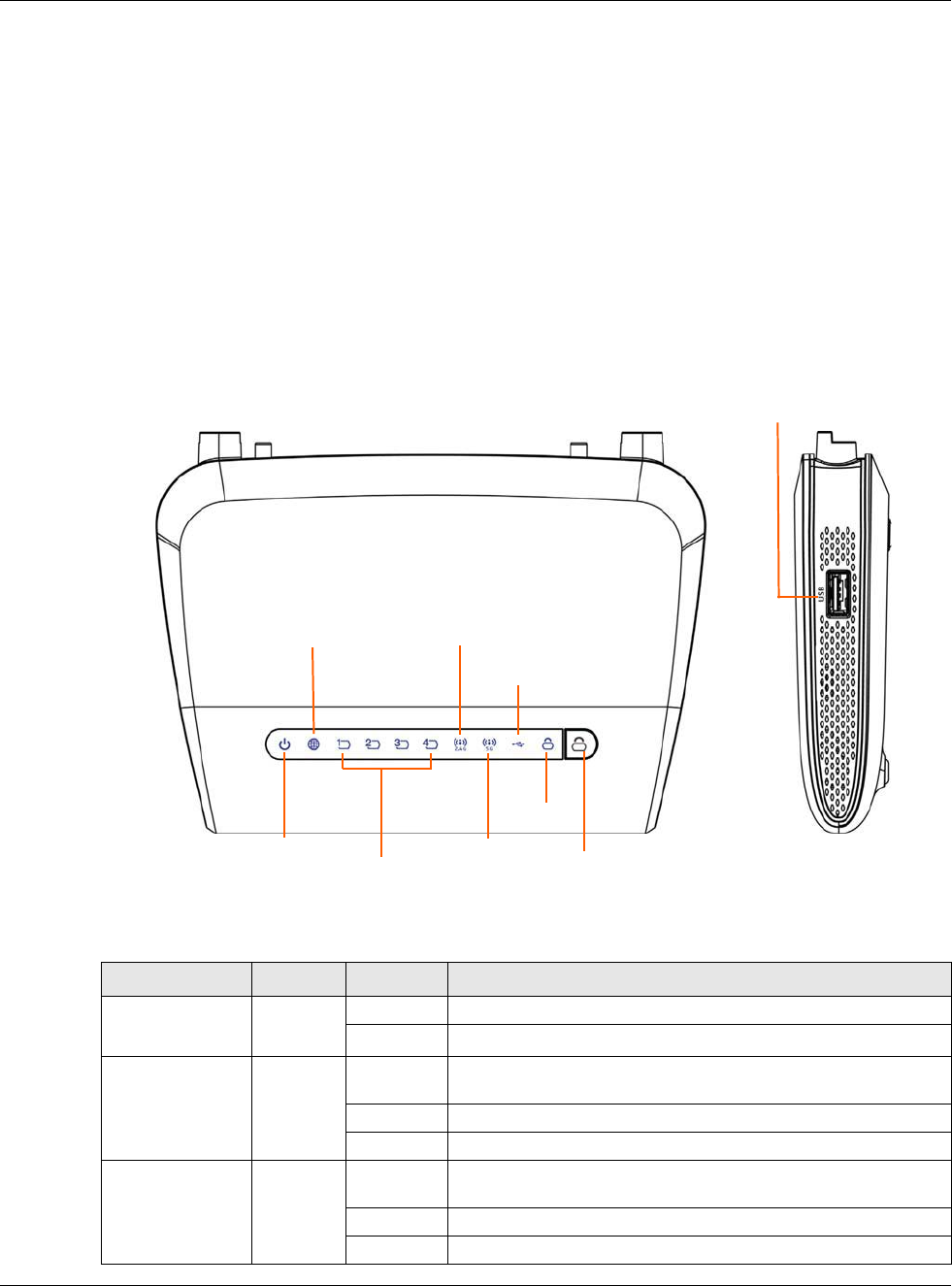
Chapter 1 Introduction
NBG6617 User’s Guide
12
1Make sure the power LED is on (not blinking).
2Press the WPS button for more than three seconds and release it. Press the WPS button on another
WPS-enabled device within range of the NBG6617.
Note: You must activate WPS in the NBG6617 and in another wireless device within two
minutes of each other.
For more information on using WPS, see Section 8.2 on page 49.
1.7 LEDs
Figure 1 Top Panel, WPS Button and USB Slot
The following table describes the top panel LEDs.
Table 1 Top Panel LEDs
LED COLOR STATUS DESCRIPTION
Power Green On The NBG6617 is receiving power and functioning properly.
Off The NBG6617 is not receiving power.
WAN Green On The NBG6617 has a successful 10/100/1000MB WAN
connection.
Blinking The NBG6617 is sending/receiving data through the WAN.
Off The WAN connection is not ready, or has failed.
LAN 1-4 Green On The NBG6617 has a successful 10/100/1000MB Ethernet
connection.
Blinking The NBG6617 is sending/receiving data through the LAN.
Off The LAN is not connected.
WLAN 2.4GHz
WLAN 5GHz
Power
WAN
LAN 1-4
WPS
USB Slot
WPS Button
USB
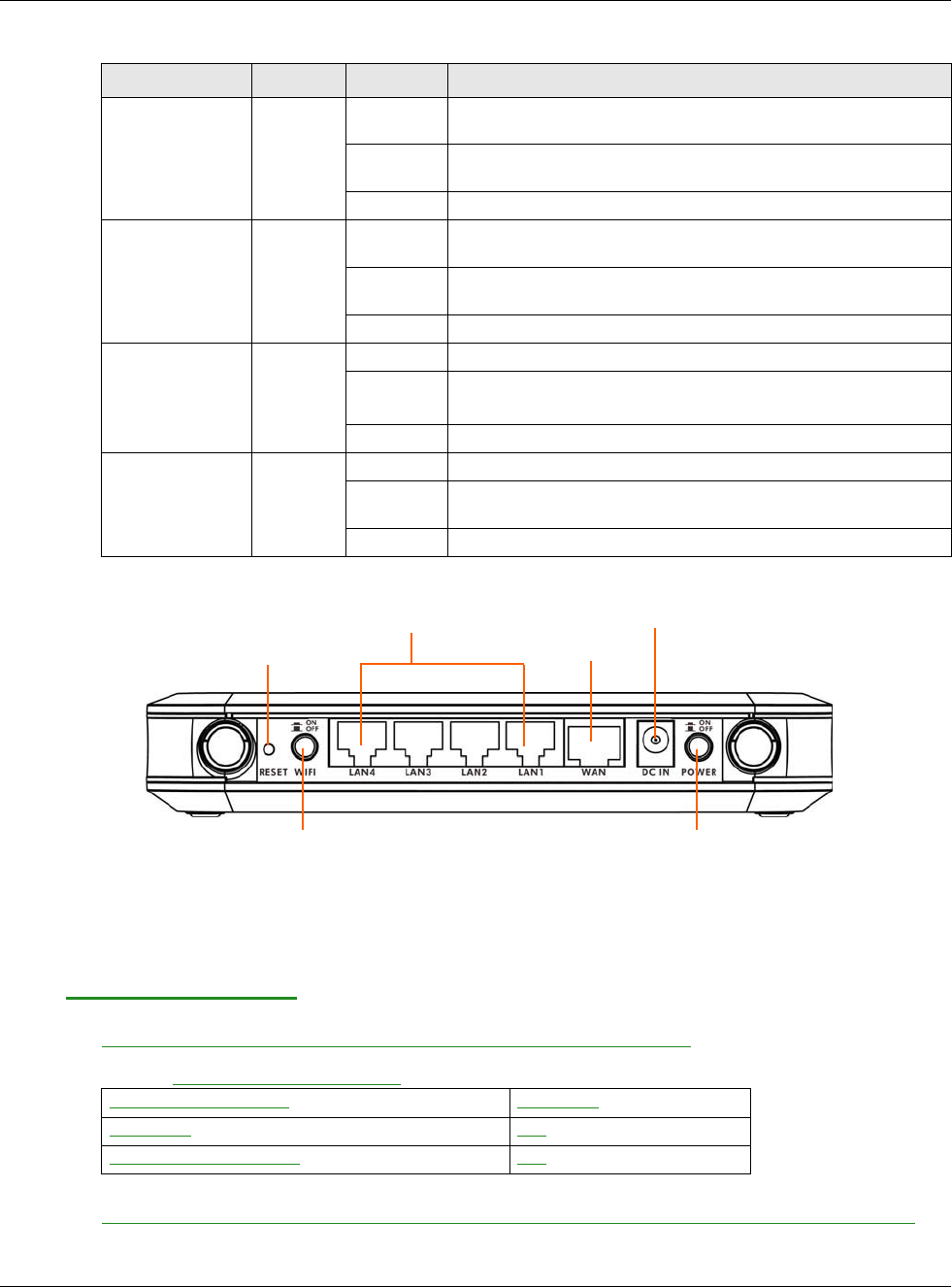
Chapter 1 Introduction
NBG6617 User’s Guide
13
Figure 2 Rear Panel
1.8 Wall Mounting
You may need screw anchors if mounting on a concrete or brick wall.
1Select a position free of obstructions on a wall strong enough to hold the weight of the device.
WLAN 2.4GHz Green On The NBG6617 is ready, but is not sending/receiving data
through the wireless LAN 2.4 GHz band.
Blinking The NBG6617 is sending/receiving data through the wireless
LAN 2.4 GHz band.
Off The wireless LAN 2.4 GHz band is not ready or has failed.
WLAN 5GHz Green On The NBG6617 is ready, but is not sending/receiving data
through the wireless LAN 5 GHz band.
Blinking The NBG6617 is sending/receiving data through the wireless
LAN 5 GHz band.
Off The wireless LAN 5 GHz band is not ready or has failed.
USB Green On The NBG6617 has a USB device installed.
Blinking The NBG6617 is transmitting and/or receiving data from routers
through an installed USB device.
Off There is no USB device connected to the NBG6617.
WPS Green On WPS is enabled.
Blinking The NBG6617 is negotiating a WPS connection with a wireless
client.
Off WPS is disabled.
Table 1 Top Panel LEDs (continued)
LED COLOR STATUS DESCRIPTION
LAN Ports 1-4
WAN Port
RESET Button
WIFI Button Power Button
Power Input
Table 2 Wall Mounting Information
Distance between holes 12.356 cm
M4 Screws Two
Screw anchors (optional) Two
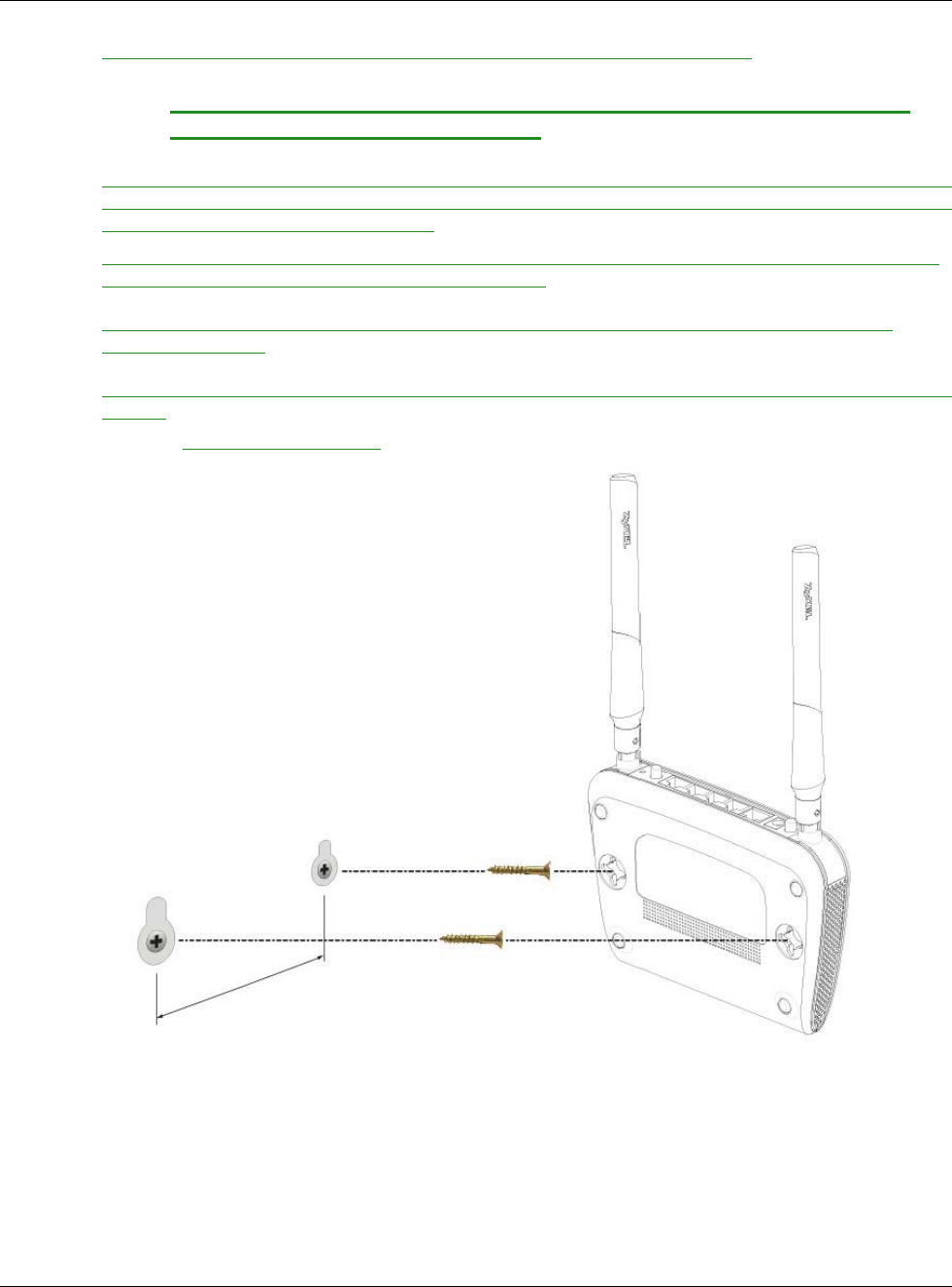
Chapter 1 Introduction
NBG6617 User’s Guide
14
2Mark two holes on the wall at the appropriate distance apart for the screws.
Be careful to avoid damaging pipes or cables located inside the wall
when drilling holes for the screws.
3If using screw anchors, drill two holes for the screw anchors into the wall. Push the anchors into the
full depth of the holes, then insert the screws into the anchors. Do not insert the screws all the way
in - leave a small gap of about 0.5 cm.
If not using screw anchors, use a screwdriver to insert the screws into the wall. Do not insert the
screws all the way in - leave a gap of about 0.5 cm.
4Make sure the screws are fastened well enough to hold the weight of the NBG6617 with the
connection cables.
5Align the holes on the back of the NBG6617 with the screws on the wall. Hang the NBG6617 on the
screws.
Figure 3 Wall Mounting Example

NBG6617 User’s Guide
15
CHAPTER 2
Introducing the Web Configurator
2.1 Overview
This chapter describes how to access the NBG6617 Web Configurator and provides an overview of
its screens.
The Web Configurator is an HTML-based management interface that allows easy setup and
management of the NBG6617 via Internet browser. Use a browser that supports HTML5, such as
Internet Explorer 9.0 and later versions, Mozilla Firefox 21 and later versions, Safari 6.0 and later
versions or Google Chrome 26.0 and later versions. The recommended screen resolution is 1024 by
768 pixels.
In order to use the Web Configurator you need to allow:
• Web browser pop-up windows from your device. Web pop-up blocking is enabled by default in
Windows XP SP (Service Pack) 2.
• JavaScript (enabled by default).
• Java permissions (enabled by default).
Refer to the Troubleshooting chapter (Chapter 16 on page 149) to see how to make sure these
functions are allowed in Internet Explorer.
2.2 Accessing the Web Configurator
1Make sure your NBG6617 hardware is properly connected and prepare your computer or computer
network to connect to the NBG6617 (refer to the Quick Start Guide).
2Launch your web browser.
3The NBG6617 is in router mode by default. Type "http://192.168.1.1" as the website address. If the
NBG6617 obtains a WAN IP address or a DNS server IP address in the same subnet as the LAN IP
address 192.168.1.1, the default LAN IP address will be changed to 10.0.0.1 automatically. See
Auto-IP Change on page 64 for more information.
If the NBG6617 is in access point, the IP address is 192.168.1.2. See Chapter 4 on page 27 for
more information about the modes of the NBG6617.
Your computer must be in the same subnet in order to access this website address.
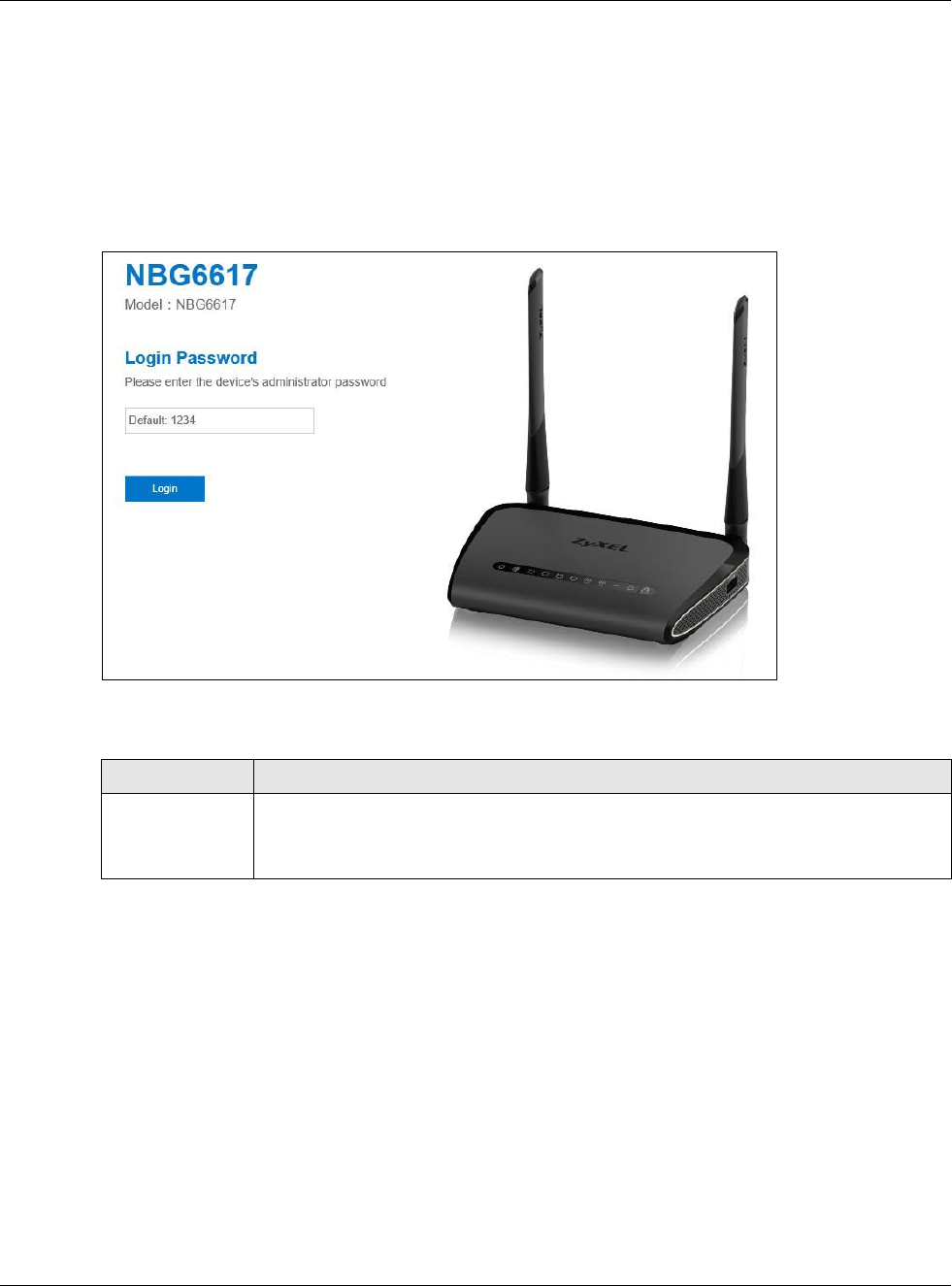
Chapter 2 Introducing the Web Configurator
NBG6617 User’s Guide
16
2.2.1 Login Screen
Note: If this is the first time you are accessing the Web Configurator, you may be
redirected to the eaZy123 wizard. Refer to Chapter 3 on page 18 for the eaZy123
setup screens.
The Web Configurator initially displays the following login screen.
Figure 4 Login screen
The following table describes the labels in this screen.
2.2.2 Change Default Password Screen
You should see a screen asking you to change your password (highly recommended) as shown
next.
Table 3 Login screen
LABEL DESCRIPTION
Please enter the
device’s
administrator
password
Type "1234" (default) as the password. Click Login.
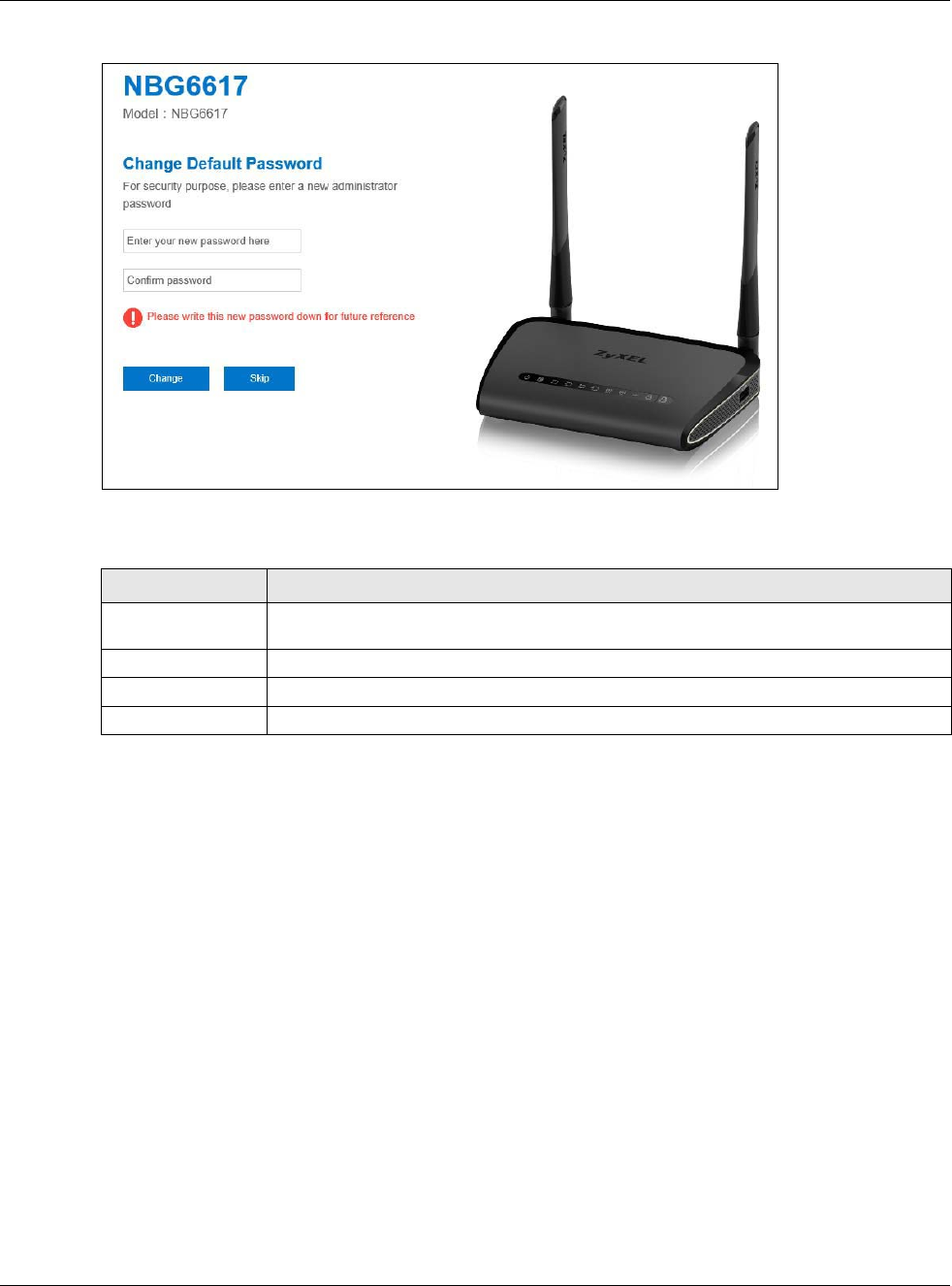
Chapter 2 Introducing the Web Configurator
NBG6617 User’s Guide
17
Figure 5 Change Default Password Screen
The following table describes the labels in this screen.
Note: The management session automatically times out when the time period set in the
Administrator Inactivity Timer field expires (default five minutes; go to Chapter
15 on page 135 to change this). Simply log back into the NBG6617 if this happens.
Table 4 Change Default Password Screen
LABEL DESCRIPTION
Enter your new
password here
Type a new password.
Confirm password Retype the password for confirmation.
Change Click Change to save your changes back to the NBG6617.
Skip Click Skip if you do not want to change the password this time.

NBG6617 User’s Guide
18
CHAPTER 3
eaZy 123 Wizard
3.1 Overview
This chapter provides information on the eaZy 123 setup screens in the Web Configurator.
The Web Configurator’s eaZy 123 setup wizard helps you configure your device to access the
Internet. Refer to your ISP for your Internet account information. Leave a field blank if you don’t
have that information.
3.2 Accessing the eaZy 123 Wizard
Launch your web browser and type "http://192.168.1.1" as the website address. Type "1234"
(default) as the password and click Login.
Note: The eaZy 123 wizard appears automatically when the NBG6617 is accessed for the
first time or when you reset the NBG6617 to its default factory settings. If you
didn’t configure the wizard screens, you will be redirected to the login page when
you connect to the Internet.
If you have already configured the wizard screens and want to open it again, click on the
upper right corner of any Web Configurator screen. The eaZy 123 wizard attempts to detect which
WAN connection type you are using.
If the eaZy 123 wizard does not detect a connection type, you must select one from the drop-down
list box. Check with your ISP to make sure you use the correct type.
If you do not have the Internet connection, the following screen opens.
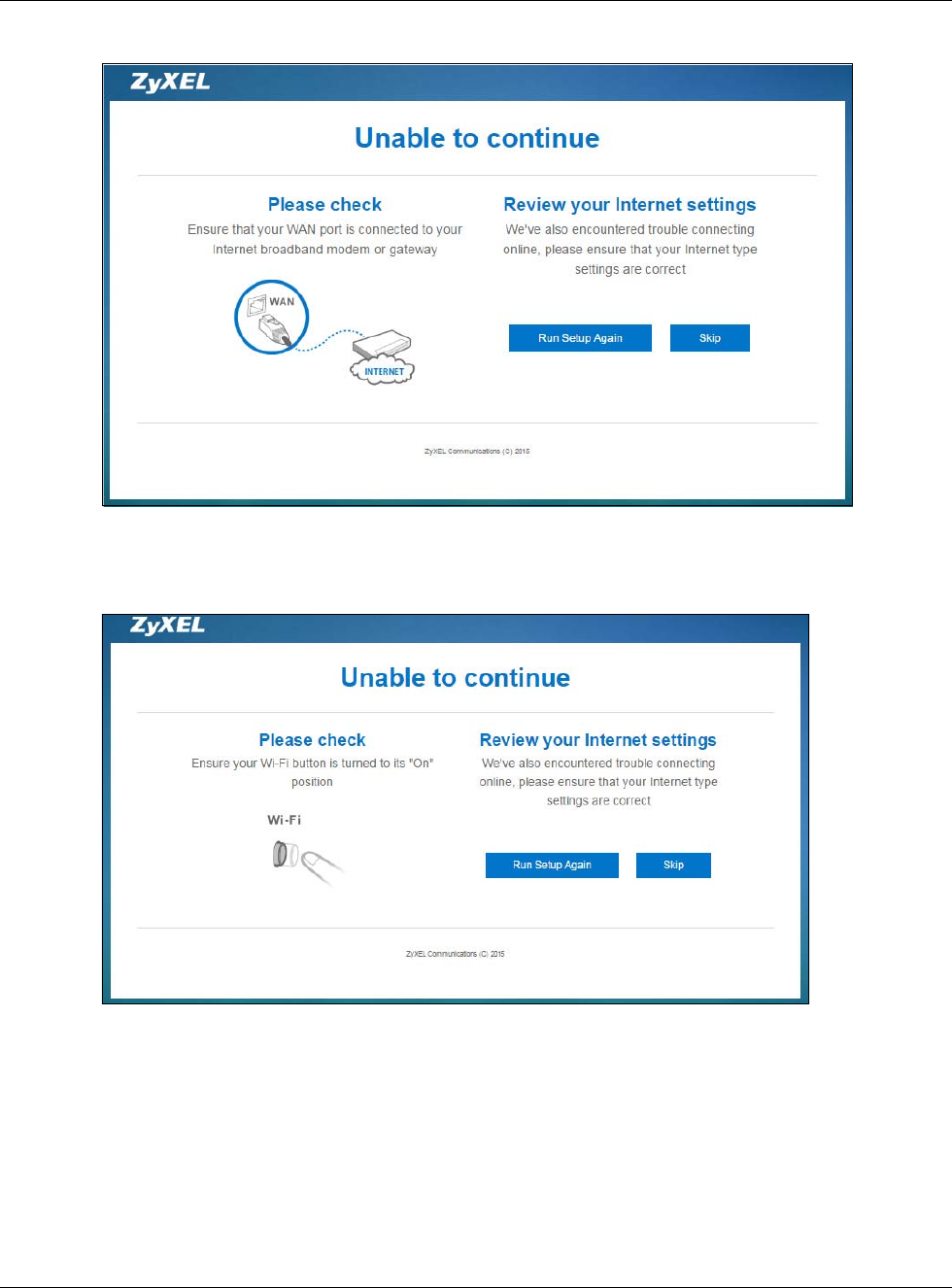
Chapter 3 eaZy 123 Wizard
NBG6617 User’s Guide
19
Figure 6 Unable to continue: WAN
If you do not press the Wi-Fi button located on the NBG6617’s rear panel, the following screen
opens.
Figure 7 Unable to continue: Wi-Fi
Note: If you get an error message, check your hardware connections. Make sure your
Internet connection is up and running.
The wizard screen opens.
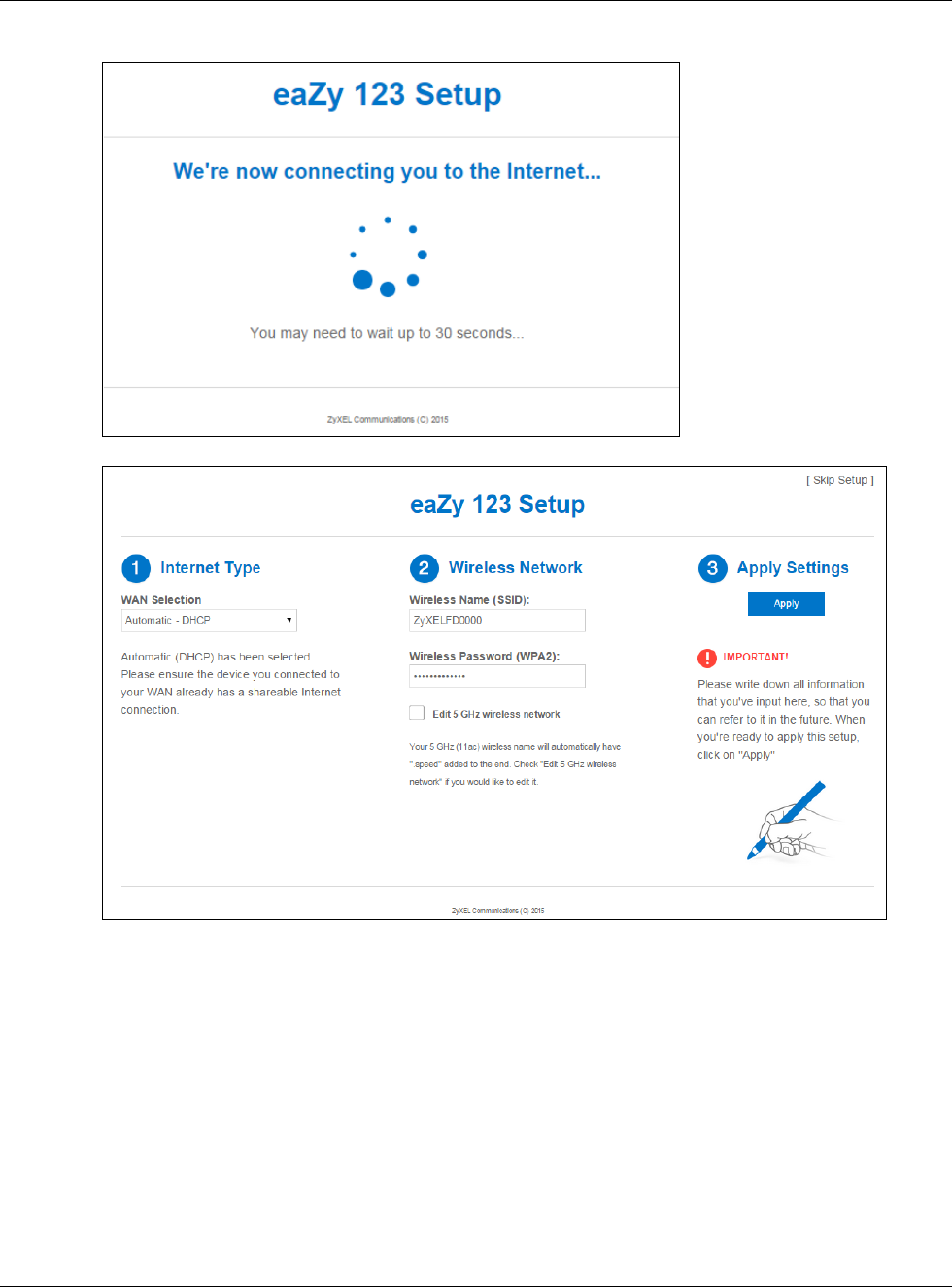
Chapter 3 eaZy 123 Wizard
NBG6617 User’s Guide
20
Figure 8 Detecting your Internet Connection Type
Figure 9 eaZy 123 Setup
3.3 Internet Type
The NBG6617 offers three WAN selection types. They are Automatic - DHCP, PPPoE or Static.
Configure the Internet type settings on your NBG6617 in the first part. The following screen
depends on your Internet connection type. Enter the details provided by your Internet Service
Provider (ISP) in the fields (if any).
Check with your ISP to make sure you use the correct type. This wizard screen varies according to
the connection type that you select.
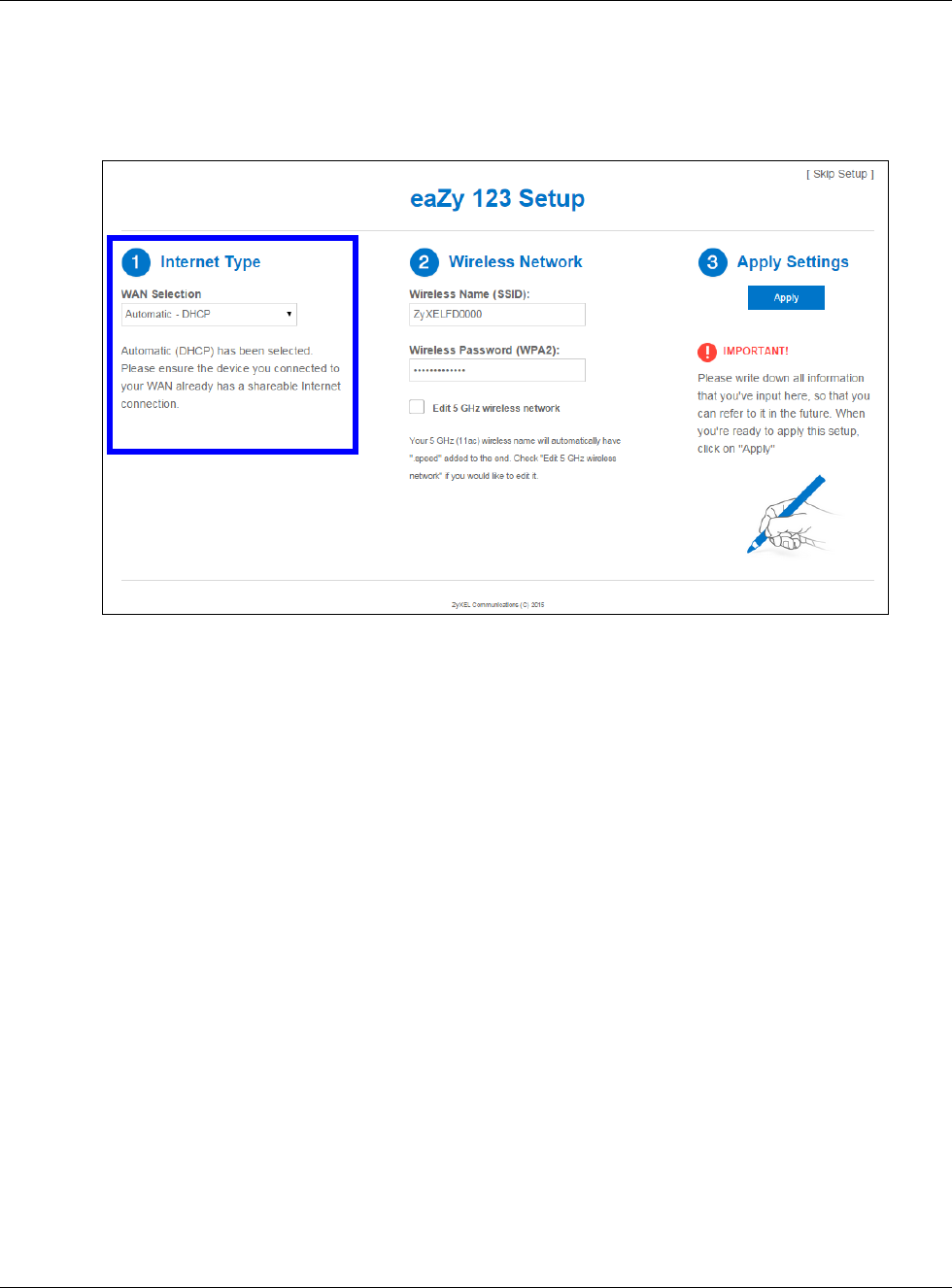
Chapter 3 eaZy 123 Wizard
NBG6617 User’s Guide
21
3.3.1 WAN Selection Type: Automatic - DHCP
Select the Automatic - DHCP option if your ISP did not assign you a fixed IP address.
Figure 10 WAN Selection Type: Automatic - DHCP
3.3.2 WAN Selection Type: PPPoE
Point-to-Point Protocol over Ethernet (PPPoE) functions as a dial-up connection. PPPoE is an IETF
(Internet Engineering Task Force) standard specifying how a host personal computer interacts with
a broadband modem (for example DSL, cable, wireless, etc.) to achieve access to high-speed data
networks.
For the service provider, PPPoE offers an access and authentication method that works with existing
access control systems (for instance, RADIUS).
One of the benefits of PPPoE is the ability to let end users access one of multiple network services,
a function known as dynamic service selection. This enables the service provider to easily create
and offer new IP services for specific users.
Operationally, PPPoE saves significant effort for both the subscriber and the ISP/carrier, as it
requires no specific configuration of the broadband modem at the subscriber's site.
By implementing PPPoE directly on the NBG6617 (rather than individual computers), the computers
on the LAN do not need PPPoE software installed, since the NBG6617 does that part of the task.
Furthermore, with NAT, all of the LAN's computers will have Internet access.
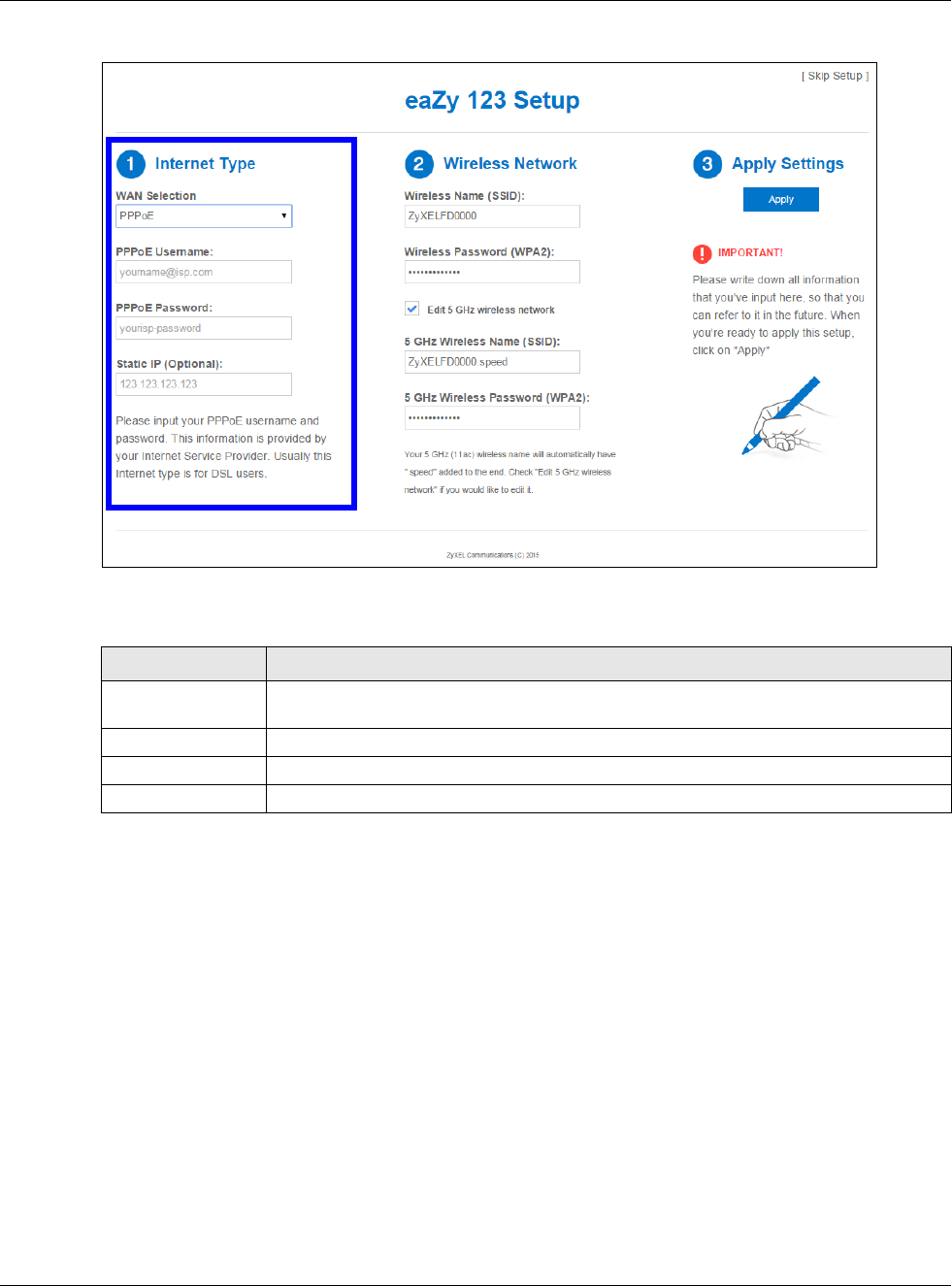
Chapter 3 eaZy 123 Wizard
NBG6617 User’s Guide
22
Figure 11 WAN Selection Type: PPPoE
The following table describes the labels in this screen.
Note: If you get an error message, make sure you have entered the correct information
provided by your ISP.
3.3.3 WAN Selection Type: Static
Choose Static as the WAN Selection Type when the WAN port is used as a regular Ethernet. Click
Next.
Table 5 WAN Selection Type: PPPoE
LABEL DESCRIPTION
WAN Selection Select the PPPoE (Point-to-Point Protocol over Ethernet) option for a dial-up
connection.
PPPoE Username Type the user name given to you by your ISP.
PPPoE Password Type the password associated with the user name above.
Static IP (Optional) Enter the WAN IP address assigned by your ISP.
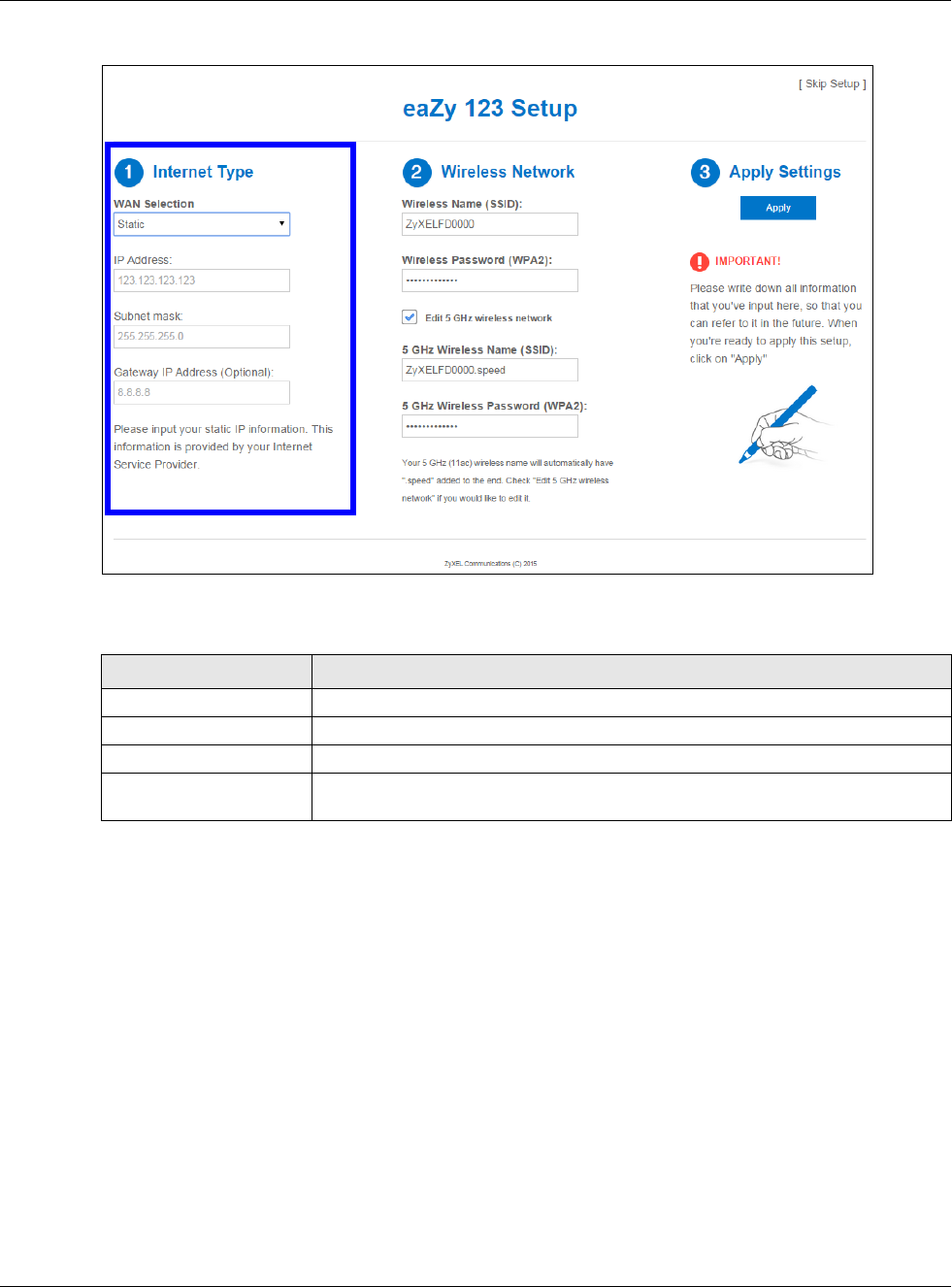
Chapter 3 eaZy 123 Wizard
NBG6617 User’s Guide
23
Figure 12 WAN Selection Type: Static
The following table describes the labels in this screen.
Note: If you get an error screen, make sure your Internet connection is working and
select the right WAN Selection Type. Contact your ISP if you are not sure of your
Internet Connection type.
3.4 Wireless Network
Configure the wireless network settings on your NBG6617 in the second part. The default wireless
security setting is WPA2-PSK.
Table 6 WAN Selection Type: Static
LABEL DESCRIPTION
WAN Selection Select the Static option when the WAN port is using a fixed IP address.
IP Address Enter the IP address provided by your ISP.
Subnet Mask Enter the IP subnet mask in this field.
Gateway IP Address
(Optional)
Enter the gateway IP address in this field.
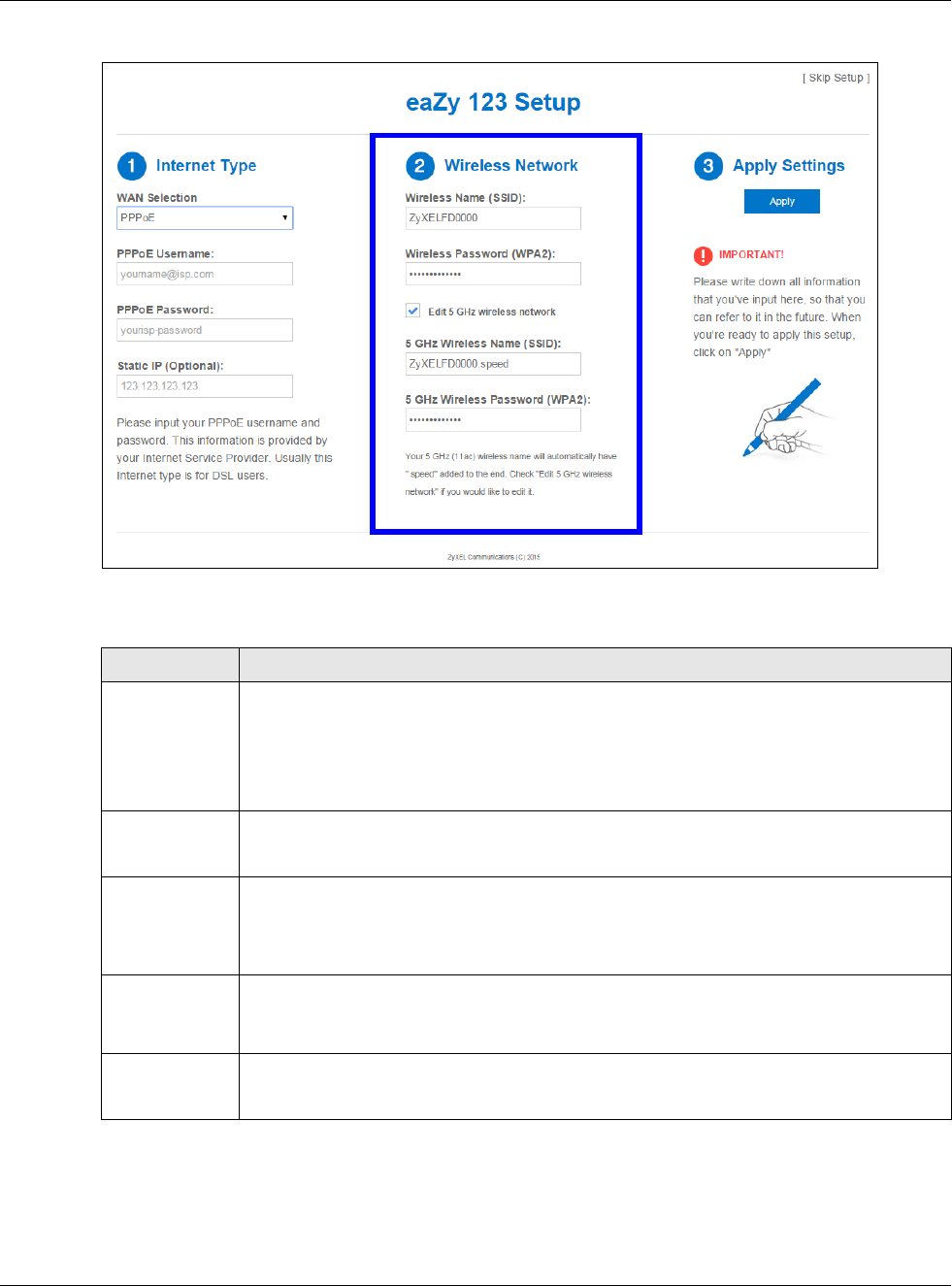
Chapter 3 eaZy 123 Wizard
NBG6617 User’s Guide
24
Figure 13 Wireless Network
The following table describes the labels in this screen.
Click the Apply button in the third part to save your settings.
Table 7 Wireless Network
LABEL DESCRIPTION
Wireless Name
(SSID)
Enter a descriptive name for the wireless LAN.
Note: The setting here applies to 2.4 GHz wireless radios.
If you change this field on the NBG6617, make sure all wireless stations use the same SSID
in order to access the network.
Wireless
Password
(WPA2)
Type from 8 to 63 case-sensitive ASCII characters. You can set up the most secure wireless
connection by configuring WPA in the wireless LAN screens.
Edit 5 GHz
wireless
network
Select this check box to configure different SSID and wireless security settings for the
NBG6617’s 5 GHz wireless network.
If you do not select this option, the NBG6617 uses the same SSID and Wi-Fi key (you
configured above) for the 5 GHz wireless network.
5GHz Wireless
Name (SSID)
Enter a descriptive name for the wireless LAN.
If you change this field on the NBG6617, make sure all wireless stations use the same SSID
in order to access the network.
5GHz Wireless
Password
(WPA2)
Type from 8 to 63 case-sensitive ASCII characters. You can set up the most secure wireless
connection by configuring WPA in the wireless LAN screens.
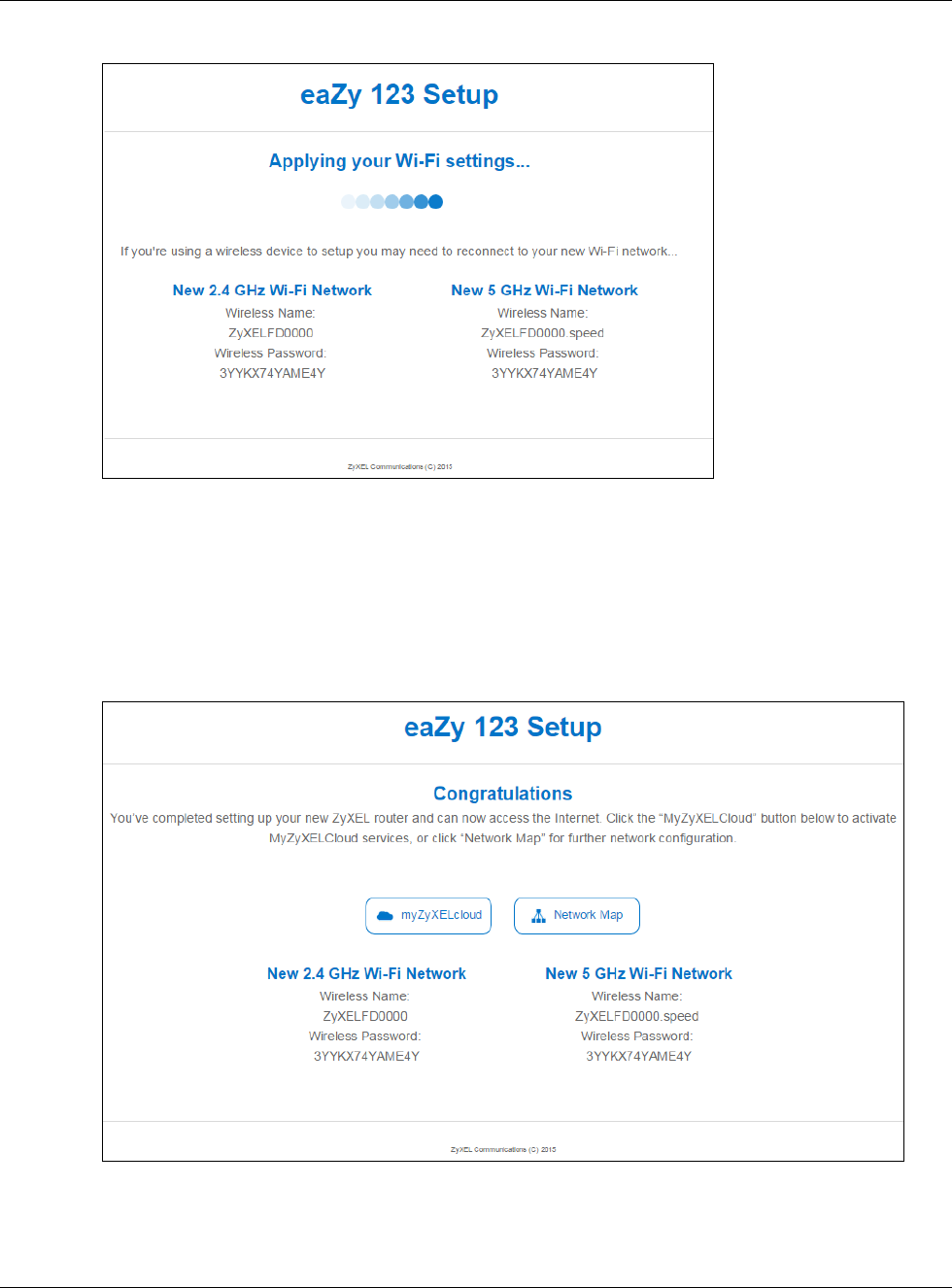
Chapter 3 eaZy 123 Wizard
NBG6617 User’s Guide
25
Figure 14 Apply your Wi-Fi settings
Congratulations! Open a web browser, such as Internet Explorer, to visit your favorite website.
Note: If you cannot access the Internet when your computer is connected to one of the
NBG6617’s LAN ports, check your connections. Then turn the NBG6617 off, wait for
a few seconds then turn it back on. If that does not work, log in to the web
configurator again and check you have typed all information correctly. See the
User’s Guide for more suggestions.
Figure 15 Congratulations
You can click the My ZyXEL Cloud Service button to go to https://mycloud.zyxel.com, where you
can create an account and register your NBG6617. At the time of writing, you can have free DDNS

Chapter 3 eaZy 123 Wizard
NBG6617 User’s Guide
26
service to get a domain name mapped to the NBG6617’s dynamic IP address. With DDNS, you can
use the domain name to remotely access the NBG6617’s Web Configurator through the Internet.
You have successfully set up your NBG6617 to operate on your network and access the Internet.

NBG6617 User’s Guide
27
CHAPTER 4
NBG6617 Modes
4.1 Overview
This chapter introduces the different modes available on your NBG6617. First, the term “mode”
refers to two things in this User’s Guide.
•Web Configurator mode. This refers to the Web Configurator interface you want to use for
editing NBG6617 features.
•Device mode. This is the operating mode of your NBG6617, or simply how the NBG6617 is
being used in the network.
4.1.1 Web Configurator Modes
This refers to the configuration interface of the Web Configurator, which has two modes:
•Easy: The Web Configurator shows this mode by default. Refer to Chapter 5 on page 28 for more
information on the screens in this mode. This interface may be sufficient for users who just want
to use the device.
•Expert: Advanced users can change to this mode to customize all the functions of the NBG6617.
Click > Expert Mode after logging into the Web Configurator. The User’s Guide Chapter 9 on
page 60 through Chapter 15 on page 147 discusses the screens in this mode.
4.1.2 Device Modes
This refers to the operating mode of the NBG6617, which can act as a:
•Router: This is the default device mode of the NBG6617. Use this mode to connect the local
network to another network, like the Internet. Go to Section 6.2 on page 36 to view the Status
screen in this mode.
•Access Point: Use this mode if you want to extend your network by allowing network devices to
connect to the NBG6617 wirelessly. Go to Section 7.4 on page 44 to view the Status screen in
this mode.
For more information on these modes and to change the mode of your NBG6617, refer to Chapter
15 on page 147.
The menu for changing device modes is available in Expert Mode only.
Note: Choose your device mode carefully to avoid having to change it later.
When changing to another mode, the IP address of the NBG6617 changes. The running applications
and services of the network devices connected to the NBG6617 can be interrupted.
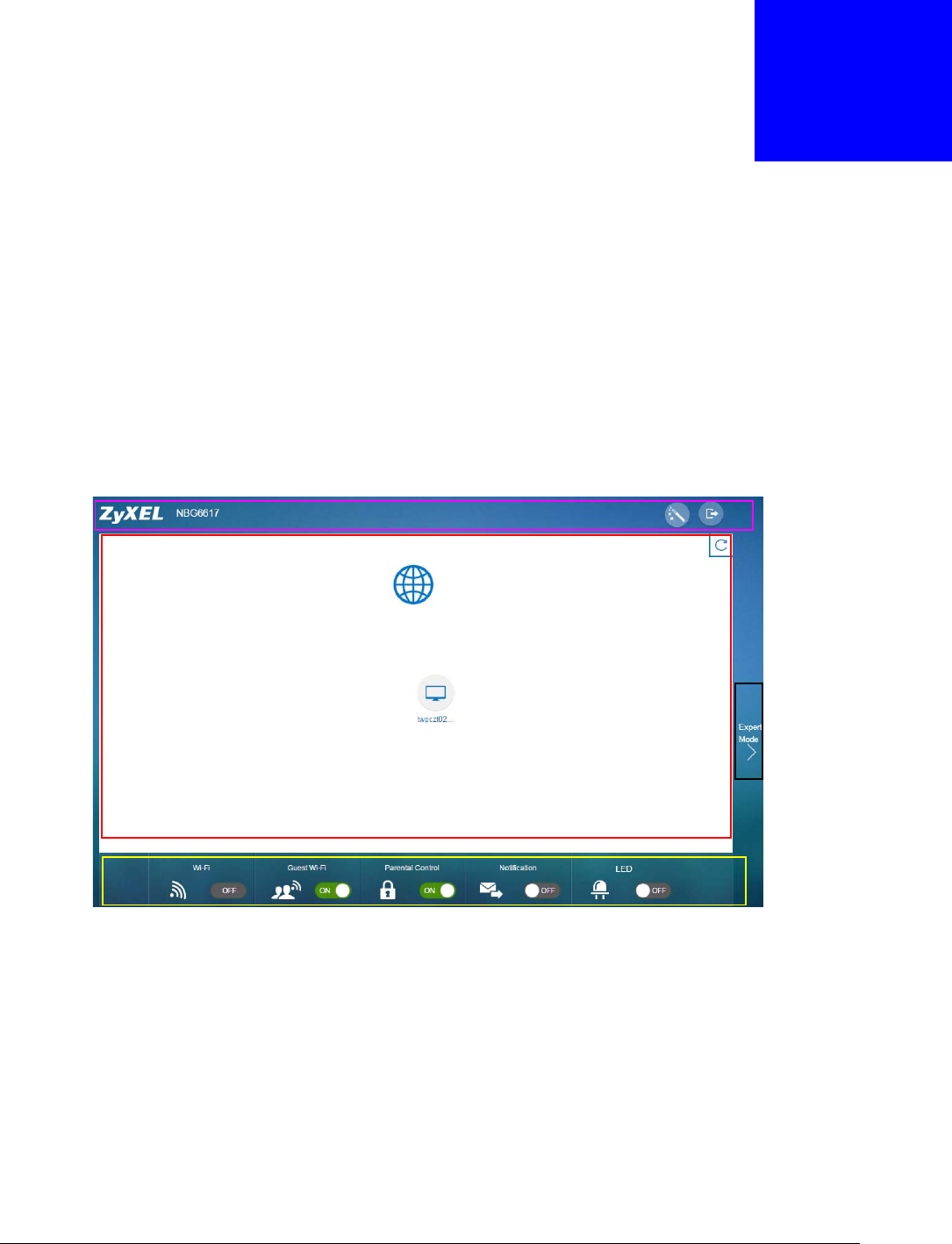
NBG6617 User’s Guide
28
CHAPTER 5
Easy Mode
5.1 Overview
The Web Configurator is set to Easy Mode by default. You can configure several key features of the
NBG6617 in this mode. This mode is useful to users who are not fully familiar with some features
that are usually intended for network administrators.
When you log in to the Web Configurator, the following screen opens.
Figure 16 Easy Mode
5.2 What You Can Do
You can do the following in this mode:
• Use this Navigation Panel to open the eaZy123 wizard or log out the NBG6617 (Section 5.4 on
page 29).
•Use the Network Map screen to check if your NBG6617 is connected to the Internet (Section 5.5
on page 29).
•Use the Control Panel to configure and enable NBG6617 features, including guest Wi-Fi,
wireless security, parental control and so on (Section 5.6 on page 31).
Network Map
Navigation Panel
Control Panel
Go to
Status
Screen
(Expert
Mode)
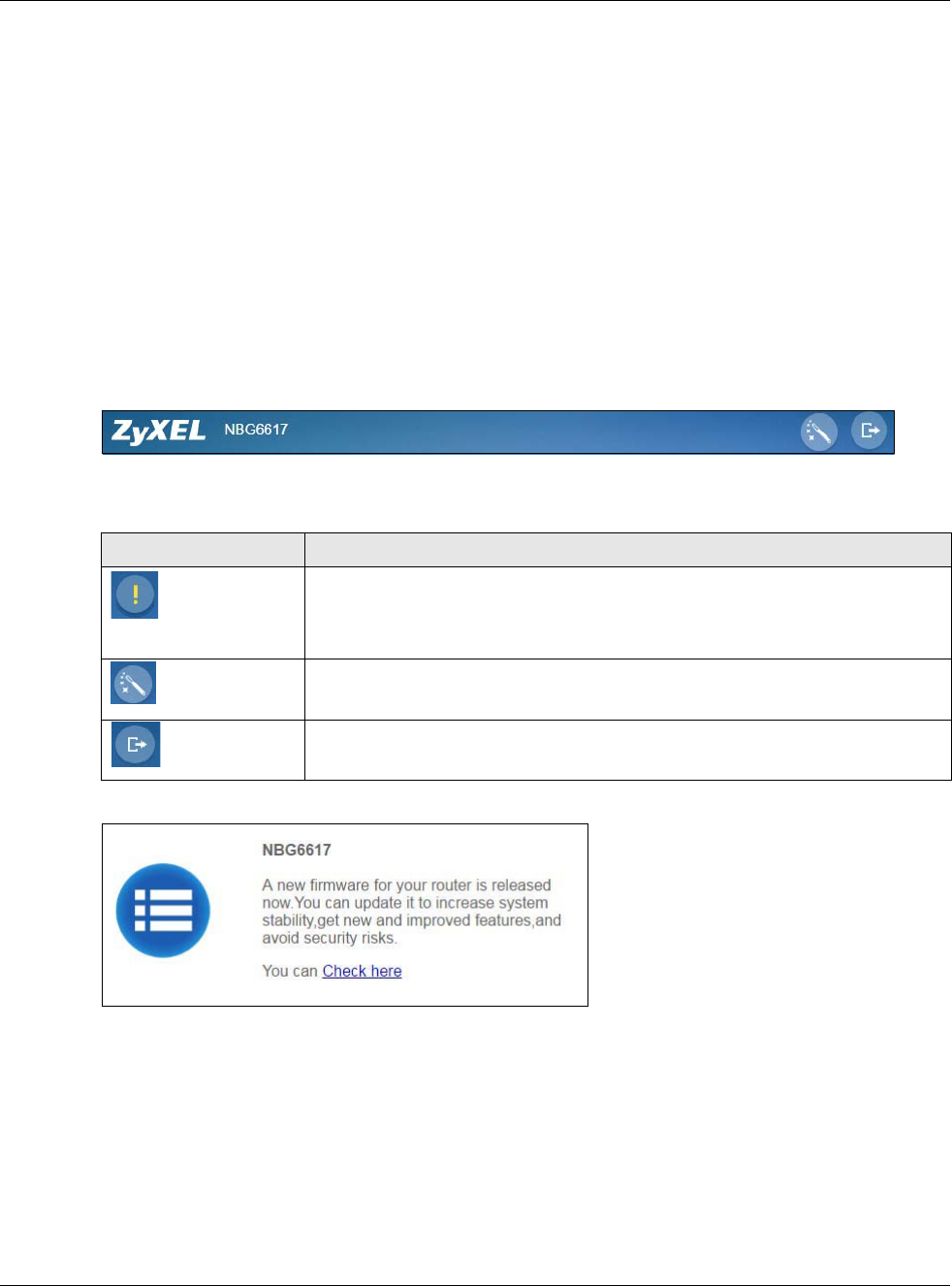
Chapter 5 Easy Mode
NBG6617 User’s Guide
29
5.3 What You Need to Know
Between the different device modes, the Control Panel (Section 5.6 on page 31) changes
depending on which features are applicable to the mode:
•Router Mode: All Control Panel features are available.
•Access Point Mode: Parental Control and Notification are not available.
5.4 Navigation Panel
Use this navigation panel to opt out of the Easy mode.
Figure 17 Easy Mode: Navigation Panel
The following table describes the labels in this screen.
Figure 18 Easy Mode: Navigation Panel: Firmware Notification
5.5 Network Map
When you log into the Web Configurator, the Network Map is shown as follows.
Table 8 Easy Mode: Navigation Panel
ITEM DESCRIPTION
Firmware Notification
Click this icon to open a screen where you can click Check here to redirect your
screen to the firmware upgrade page.
This icon only displays when new firmware is released.
Wizard Click this icon to open the eaZy123 wizard for the NBG6617.
Logout Click this to end the Web Configurator session.
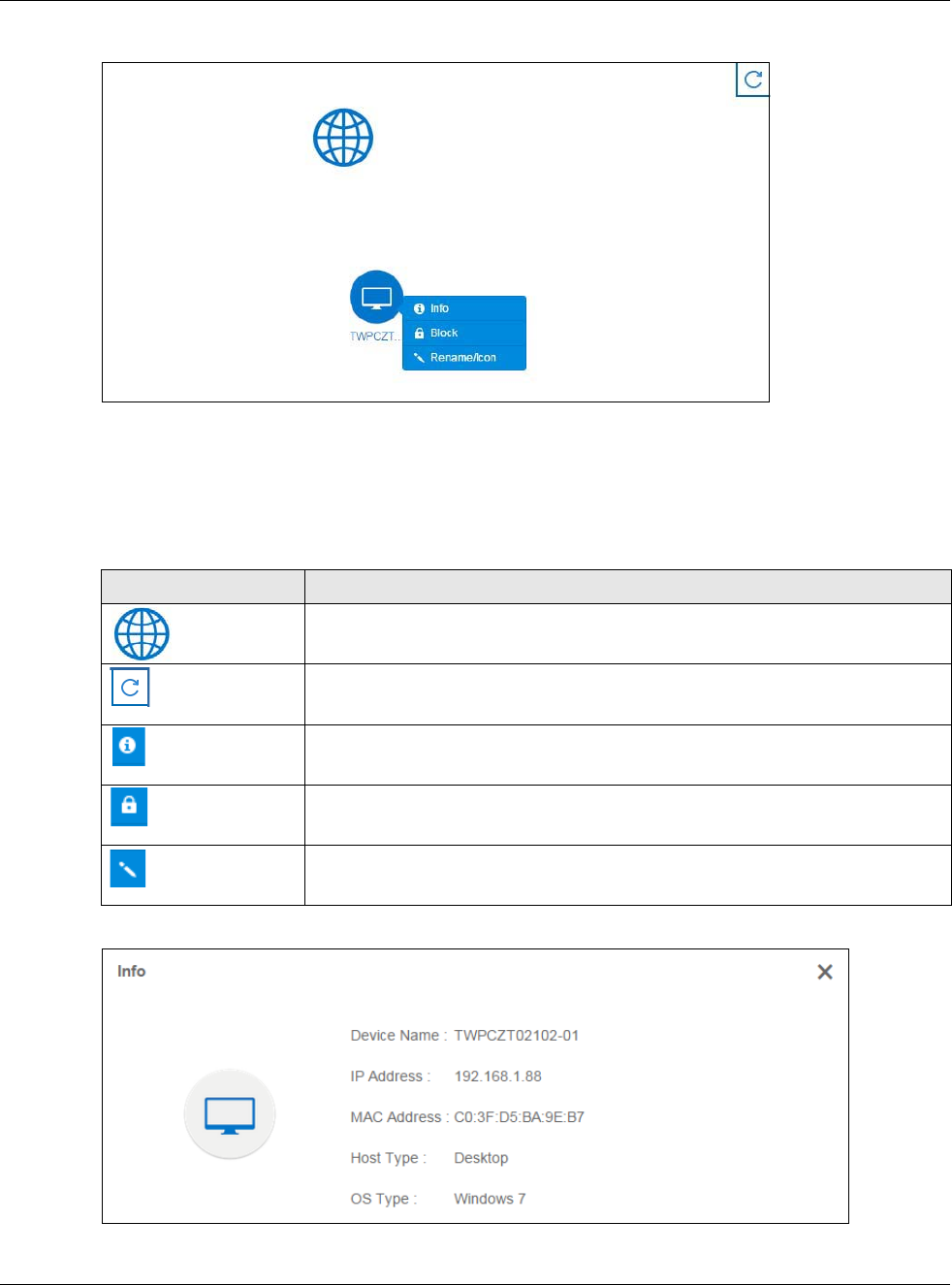
Chapter 5 Easy Mode
NBG6617 User’s Guide
30
Figure 19 Easy Mode: Network Map
This screen displays whether the NBG6617 connects to the Internet. It also shows the devices
connected to the NBG6617, including those connecting wirelessly. Click the Refresh button to
refresh the network map.
The following table describes the icons in this screen.
Figure 20 Easy Mode: Network Map: Info
Table 9 Easy Mode: Network Map
ITEM DESCRIPTION
This icon shows the NBG6617’s connection status.
This icon is grayed out if the user is unable to access the Internet.
Click this button to refresh the NBG6617’s connection status and the network map.
Info Click this to view the device’s information that is currently connected to the
NBG6617.
Block Click this to block the device from accessing the Internet through the NBG6617.
Rename / Icon Click this to rename the device or change the device’s icon.
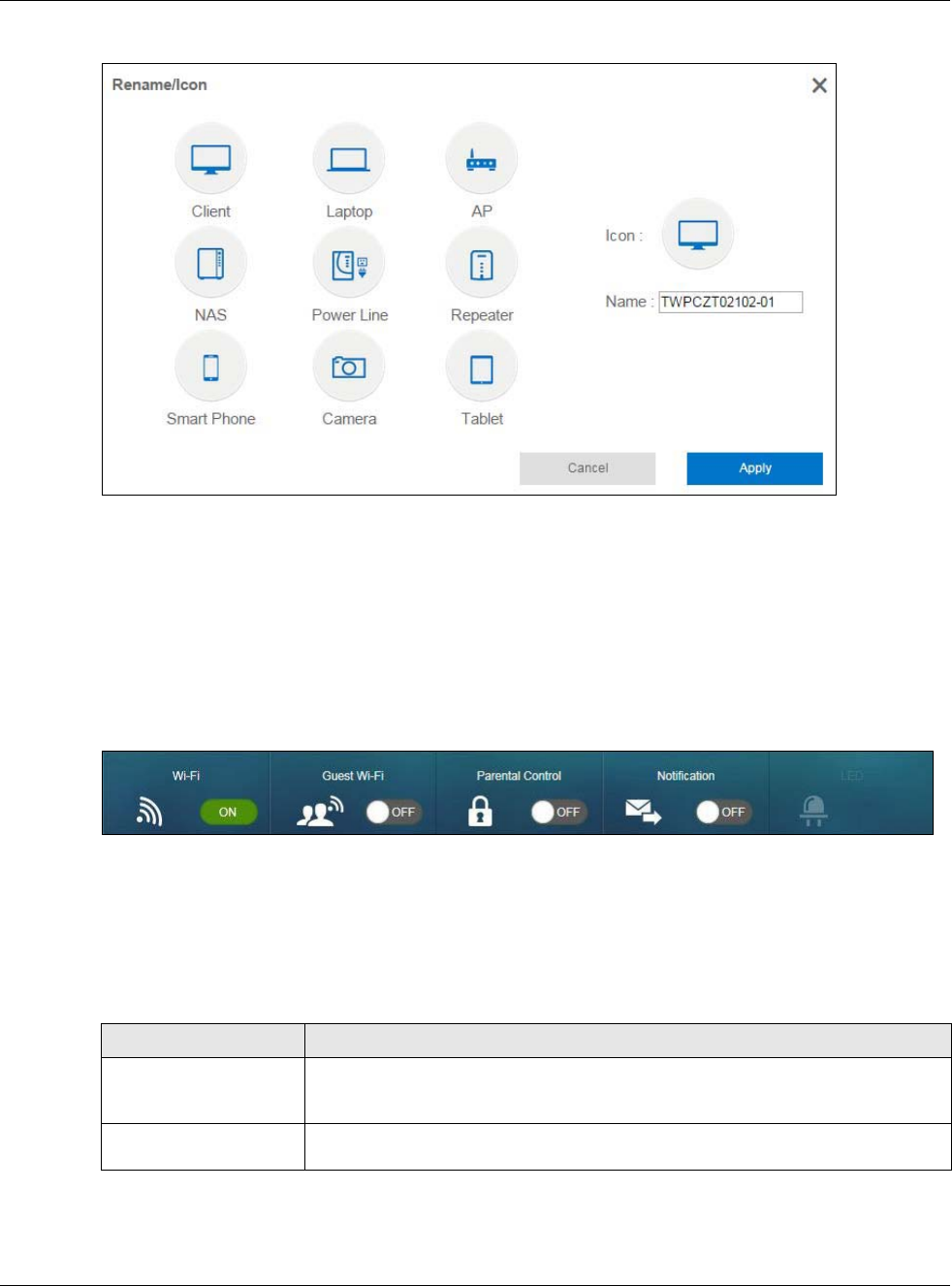
Chapter 5 Easy Mode
NBG6617 User’s Guide
31
Figure 21 Easy Mode: Network Map: Rename / Icon
Click Apply to save your changes back to the NBG6617. Click Cancel to reload the previous
configuration for this screen.
5.6 Control Panel
The features configurable in Easy Mode are shown in the Control Panel.
Figure 22 Easy Mode: Control Panel
Switch ON to enable the feature. Otherwise, switch OFF. If the feature is turned on, the green light
flashes. If it is turned off, the blue light flashes.
Additionally, click the feature to open a screen where you can edit its settings.
The following table describes the labels in this screen.
Table 10 Easy Mode: Control Panel
ITEM DESCRIPTION
Wi-Fi Switch ON to enable the NBG6617's default Wi-Fi network, and click this to
configure its wireless radio, SSID, security mode and wireless password.
Refer to Section 5.6.1 on page 32 to see this screen.
Guest Wi-Fi Switch ON to enable the guest Wi-Fi network, and click this to configure its wireless
security settings.
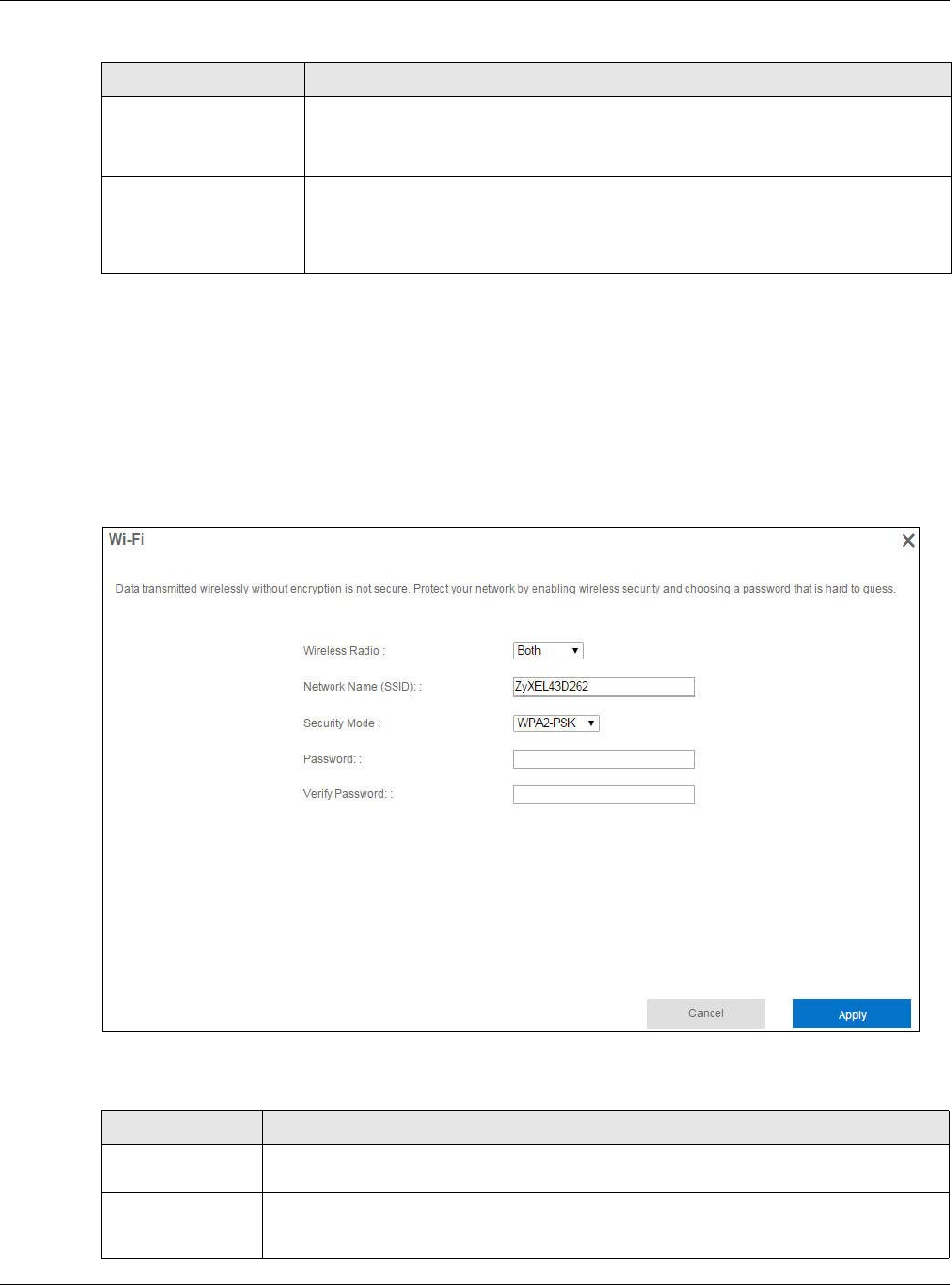
Chapter 5 Easy Mode
NBG6617 User’s Guide
32
5.6.1 Wi-Fi
Use this screen to configuresecurity for the NBG6617's default wireless LAN. You can enter the
SSID and select the wireless security mode in the following screen. See Chapter 14 on page 129 for
how to configure wireless network.
Note: You can enable the wireless function of your NBG6617 by first turning on the WIFI
switch in the rear panel.
Figure 23 Easy Mode: Wi-Fi
The following table describes the labels in this screen.
Parental Control Switch ON to enable parental control, and click this to view the parental control
rules. Otherwise, switch OFF.
Refer to Section 5.6.3 on page 34 to see this screen.
Notification Switch ON to have the NBG6617 send e-mail notifications when the user(s) is
connected to the NBG6617 for Internet access during the specified time periods.
Otherwise, switch OFF.
Refer to Section 5.6.4 on page 34 to see this screen.
Table 10 Easy Mode: Control Panel (continued)
ITEM DESCRIPTION
Table 11 Easy Mode: Wi-Fi
LABEL DESCRIPTION
Wireless Radio Choose whether you want to apply the wireless security to 2.4G Hz, 5G Hz or Both
wireless radios.
Network Name
(SSID)
(Service Set IDentity) The SSID identifies the Service Set with which a wireless station is
associated. Wireless stations associating to the access point (AP) must have the same
SSID. Enter a descriptive name (up to 32 keyboard characters) for the wireless LAN.
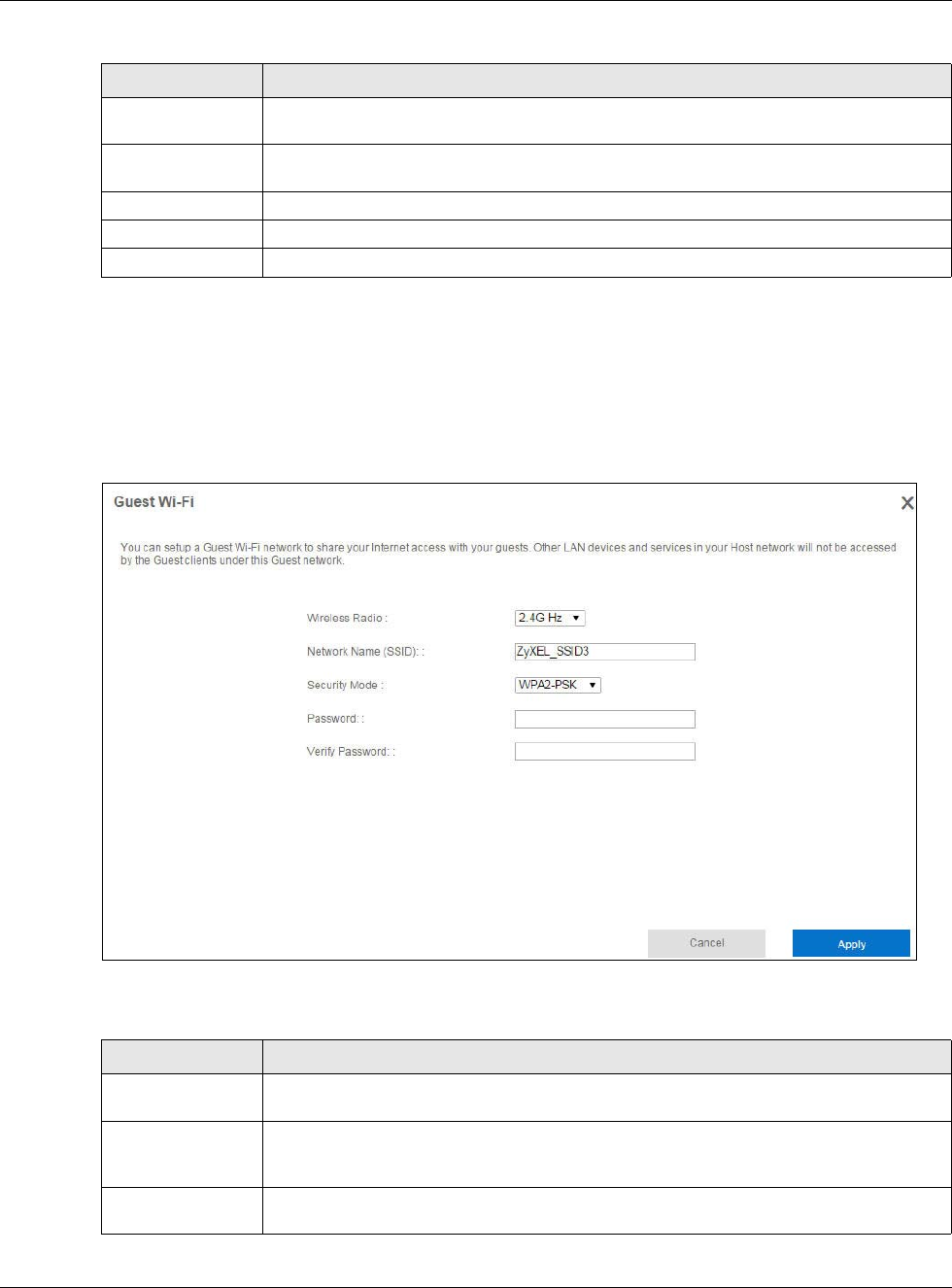
Chapter 5 Easy Mode
NBG6617 User’s Guide
33
5.6.2 Guest Wi-Fi
This screen allows you to configure guest wireless network settings on the NBG6617. Users
connected to the guest wireless network can access the Internet via the NBG6617, but not other
networks connected to the NBG6617. See Chapter 11 on page 80 for how to enable and set up the
guest wireless network.
Figure 24 Easy Mode: Guest Wi-Fi
The following table describes the labels in this screen.
Security Mode Select WPA2-PSK to enable data encryption. Or Select No Security to allow wireless
clients to communicate with the access points without any data encryption.
Password This field appears when you choose WPA2-PSK as the security mode.
Type a pre-shared key from 8 to 63 case-sensitive keyboard characters.
Verify Password Type the password again to confirm.
Cancel Click Cancel to reload the previous configuration for this screen.
Apply Click Apply to save your changes back to the NBG6617.
Table 11 Easy Mode: Wi-Fi
LABEL DESCRIPTION
Table 12 Easy Mode: Guest Wi-Fi
LABEL DESCRIPTION
Wireless Radio Choose whether you want to apply the wireless settings to the 2.4G Hz or 5G Hz
wireless radio.
Network Name
(SSID)
The SSID (Service Set IDentity) identifies the Service Set with which a wireless client is
associated. Enter a descriptive name (up to 32 printable characters found on a typical
English language keyboard) for the guest wireless network.
Security Mode Select WPA2-PSK to enable data encryption. Or select No Security to allow wireless
clients to communicate with the NBG6617 without any data encryption.
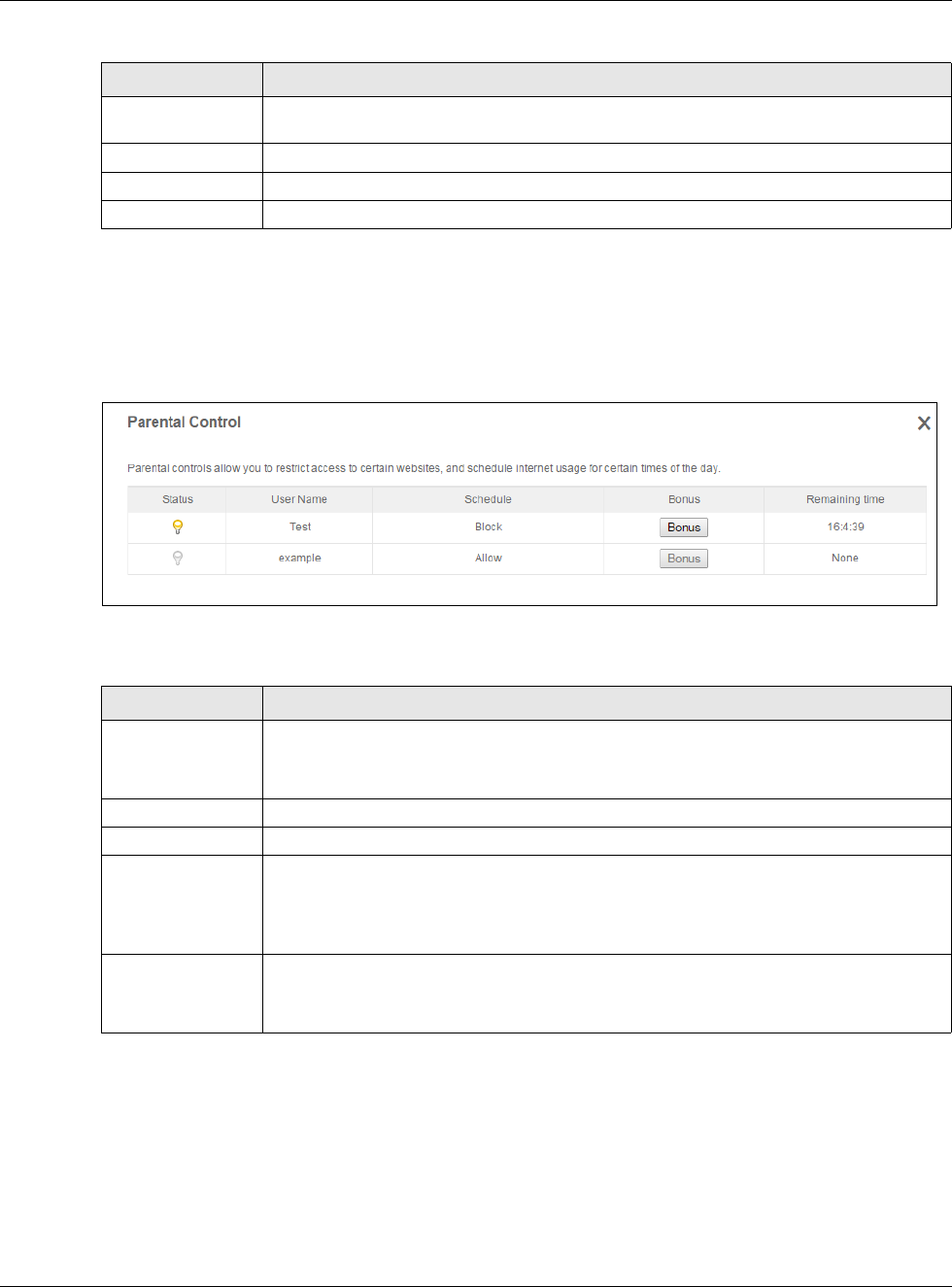
Chapter 5 Easy Mode
NBG6617 User’s Guide
34
5.6.3 Parental Control
Use this screen to view the parental control rules configured on the NBG6617. See Section 13.2 on
page 106 for how to enable and configure parental control rules.
Figure 25 Easy Mode: Parental Control
The following table describes the labels in this screen.
5.6.4 Notification
Use this screen to view the e-mail notification rules configured on the NBG6617. See Section 13.2.2
on page 110 for how to configure e-mail notification rules and e-mail settings.
Password This field appears when you choose WPA2-PSK as the security mode.
Type a pre-shared key from 8 to 63 case-sensitive keyboard characters.
Verify Password Type the password again to confirm.
Cancel Click Cancel to reload the previous configuration for this screen.
Apply Click Apply to save your changes back to the NBG6617.
Table 12 Easy Mode: Guest Wi-Fi
LABEL DESCRIPTION
Table 13 Easy Mode: Parental Control
LABEL DESCRIPTION
Status This indicates whether the rule is active or not.
A yellow bulb signifies that this rule is active. A gray bulb signifies that this rule is not
active.
User Name This shows the name of the user to which this rule applies.
Schedule This shows whether the user is allowed to access the Internet (Allow) or not (Block).
Bonus If the user is currently not permitted to access the Internet, you can click the Bonus to
allow access for a specified period of time. A screen then displays allowing you to set
how long (in minutes) the user is allowed to access the Internet.
This button is grayed out if the user is now able to access the Internet.
Remaining time This field displays the amount of Internet access time that remains for each user before
the NBG6617 blocks the user from accessing the Internet.
None means there is no extra Internet access time.

Chapter 5 Easy Mode
NBG6617 User’s Guide
35
Figure 26 Easy Mode: Notification
The following table describes the labels in this screen.
Table 14 Easy Mode: Notification
LABEL DESCRIPTION
Notification
Status This indicates whether the rule is active or not.
A yellow bulb signifies that this rule is active. A gray bulb signifies that this rule is not
active.
User Name This shows the name of the user to which this rule applies.
Notification This shows the e-mail address to which the notification is sent.
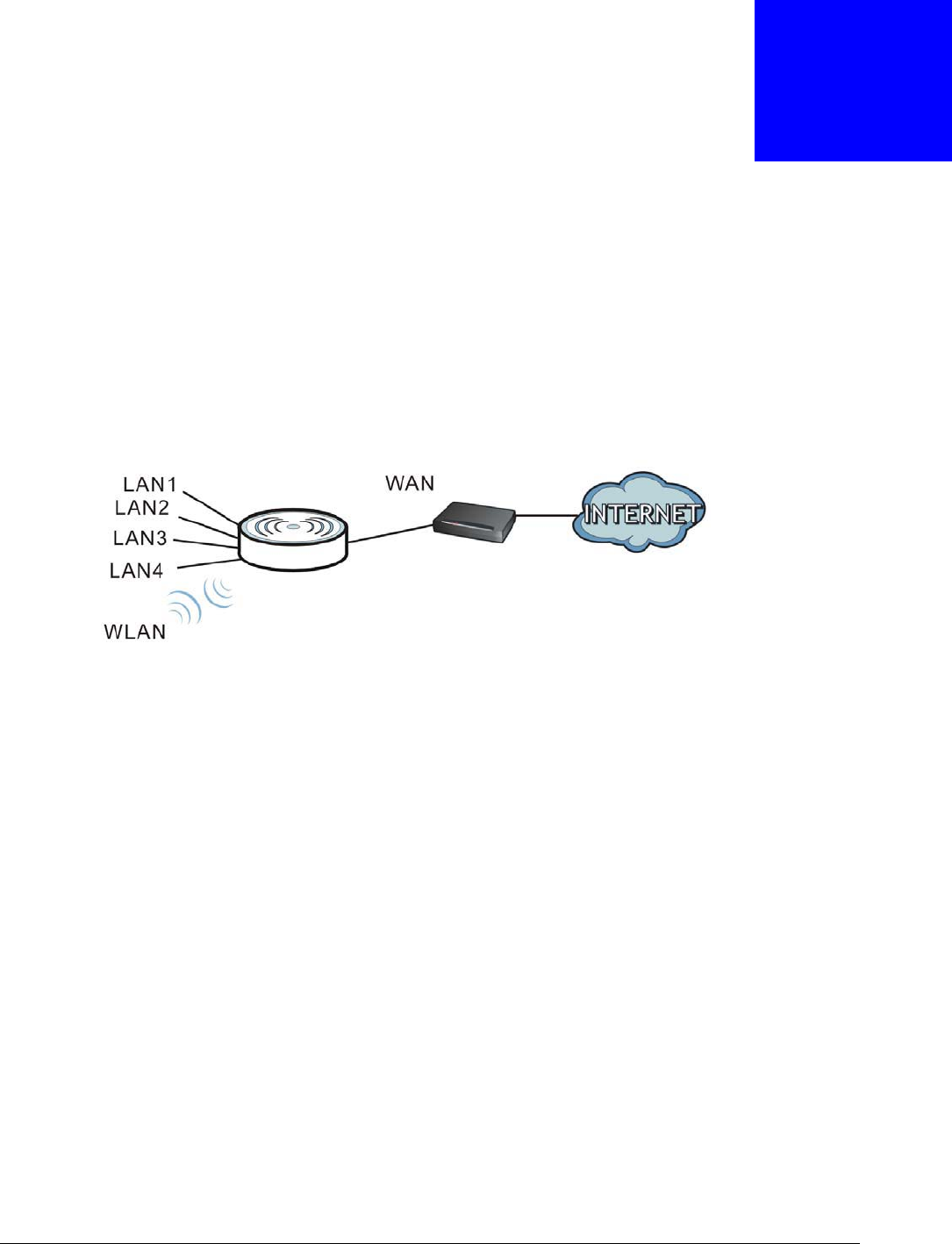
NBG6617 User’s Guide
36
CHAPTER 6
Router Mode
6.1 Overview
The NBG6617 is set to router mode by default. Routers are used to connect the local network to
another network (for example, the Internet). In the figure below, the NBG6617 connects the local
network (LAN1 ~ LAN4) to the Internet.
Figure 27 NBG6617 Network
Note: After clicking Login, the Easy Mode appears. Refer to Chapter 5 on page 28 for
the Easy Mode screens. Change to Expert Mode to see the screens described in
the sections following this.
6.2 Router Mode Status Screen
Click Expert Mode > Status > System Status to open the status screen.
Modem
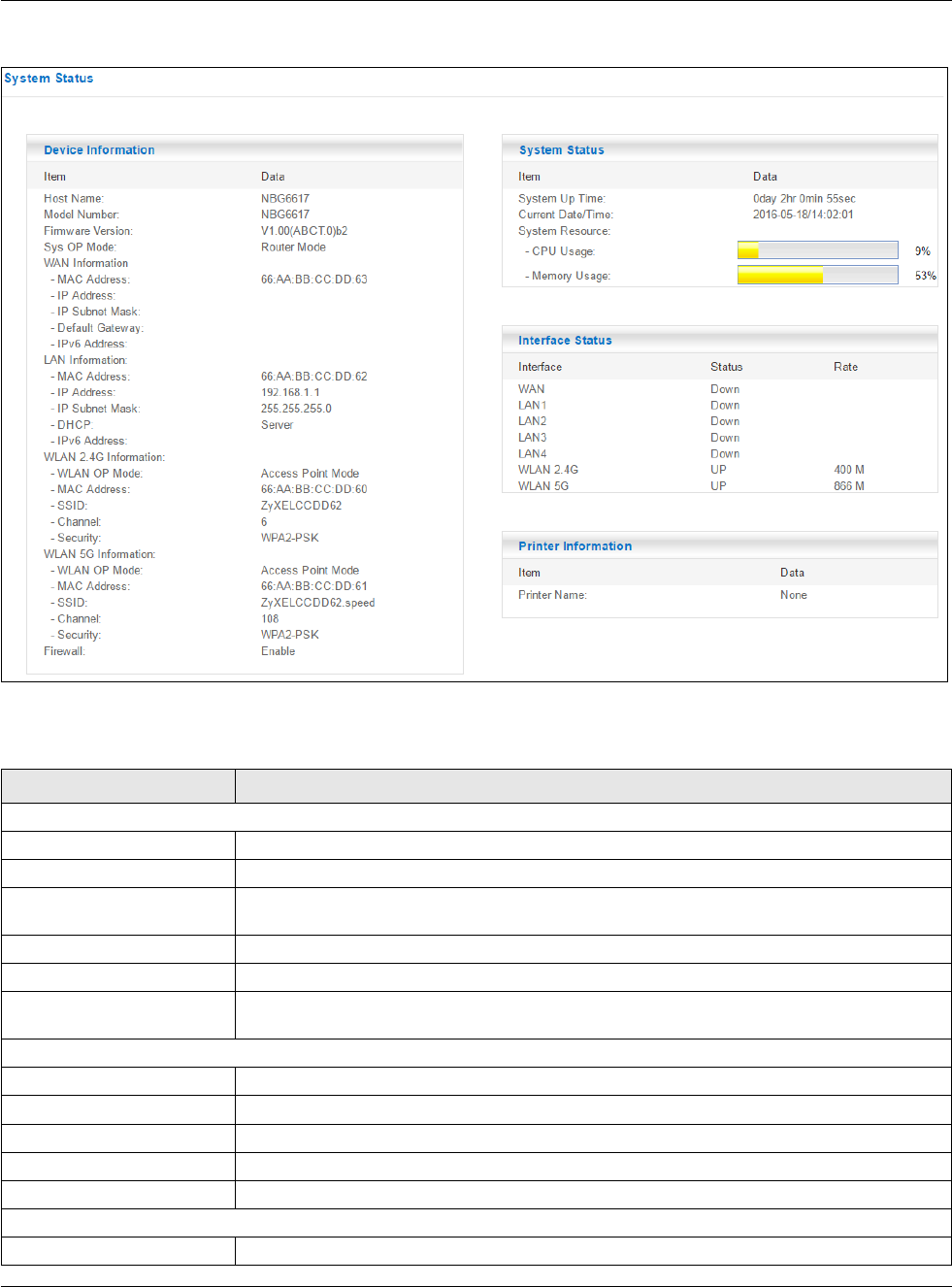
Chapter 6 Router Mode
NBG6617 User’s Guide
37
Figure 28 Expert Mode: Status > System Status: Router Mode
The following table describes the labels shown in the Status screen.
Table 15 Expert Mode: Status > System Status: Router Mode
LABEL DESCRIPTION
Device Information
Item This column shows the type of data the NBG6617 is recording.
Data This column shows the actual data recorded by the NBG6617.
Host Name This is the System Name you enter in the Maintenance > General screen. It is for
identification purposes.
Model Number This is the model name of your device.
Firmware Version This is the firmware version.
Sys OP Mode This is the device mode (Section 4.1.2 on page 27) to which the NBG6617 is set - Router
Mode.
WAN Information
MAC Address This shows the WAN Ethernet adapter MAC Address of your device.
IP Address This shows the WAN port’s IP address.
IP Subnet Mask This shows the WAN port’s subnet mask.
Default Gateway This shows the WAN port’s gateway IP address.
IPv6 Address This shows the IPv6 address of the NBG6617 on the WAN.
LAN Information
MAC Address This shows the LAN Ethernet adapter MAC Address of your device.

Chapter 6 Router Mode
NBG6617 User’s Guide
38
IP Address This shows the LAN port’s IP address.
IP Subnet Mask This shows the LAN port’s subnet mask.
DHCP This shows the LAN port’s DHCP role - Server or Disable.
IPv6 Address This shows the IPv6 address of the NBG6617 on the LAN.
WLAN 2.4G Information
WLAN OP Mode This is the device mode (Section 4.1.2 on page 27) to which the NBG6617’s wireless LAN is
set - Access Point Mode.
MAC Address This shows the 2.4GHz wireless adapter MAC Address of your device.
SSID This shows a descriptive name used to identify the NBG6617 in the 2.4GHz wireless LAN.
Channel This shows the channel number which you select manually.
Security This shows the level of wireless security the NBG6617 is using.
WLAN 5G Information
WLAN OP Mode This is the device mode (Section 4.1.2 on page 27) to which the NBG6617’s wireless LAN is
set - Access Point Mode.
MAC Address This shows the 5GHz wireless adapter MAC Address of your device.
SSID This shows a descriptive name used to identify the NBG6617 in the 5GHz wireless LAN.
Channel This shows the channel number which you select manually.
Security This shows the level of wireless security the NBG6617 is using.
Firewall This shows whether the firewall is enabled or not.
System Status
System Up Time This is the total time the NBG6617 has been on.
Current Date/Time This field displays your NBG6617’s present date and time.
System Resource
- CPU Usage This displays what percentage of the NBG6617’s processing ability is currently used. When
this percentage is close to 100%, the NBG6617 is running at full load, and the throughput is
not going to improve anymore. If you want some applications to have more throughput, you
should turn off other applications (for example, using bandwidth management.)
- Memory Usage This shows what percentage of the heap memory the NBG6617 is using.
Interface Status
Interface This displays the NBG6617 port types. The port types are: WAN, LAN and WLAN.
Status For the LAN and WAN ports, this field displays Down (line is down) or Up (line is up or
connected).
For the 2.4GHz/5GHz WLAN, it displays Up when the 2.4GHz/5GHz WLAN is enabled or
Down when the 2.4G/5G WLAN is disabled.
Rate For the LAN ports, this displays the port speed and duplex setting or is left blank when the
line is disconnected.
For the WAN port, it displays the port speed and duplex setting if you’re using Ethernet
encapsulation. This field displays N/A when the line is disconnected.
For the 2.4GHz/5GHz WLAN, it displays the maximum transmission rate when the 2.4GHz/
5GHz WLAN is enabled and N/A when the WLAN is disabled.
Table 15 Expert Mode: Status > System Status: Router Mode (continued)
LABEL DESCRIPTION
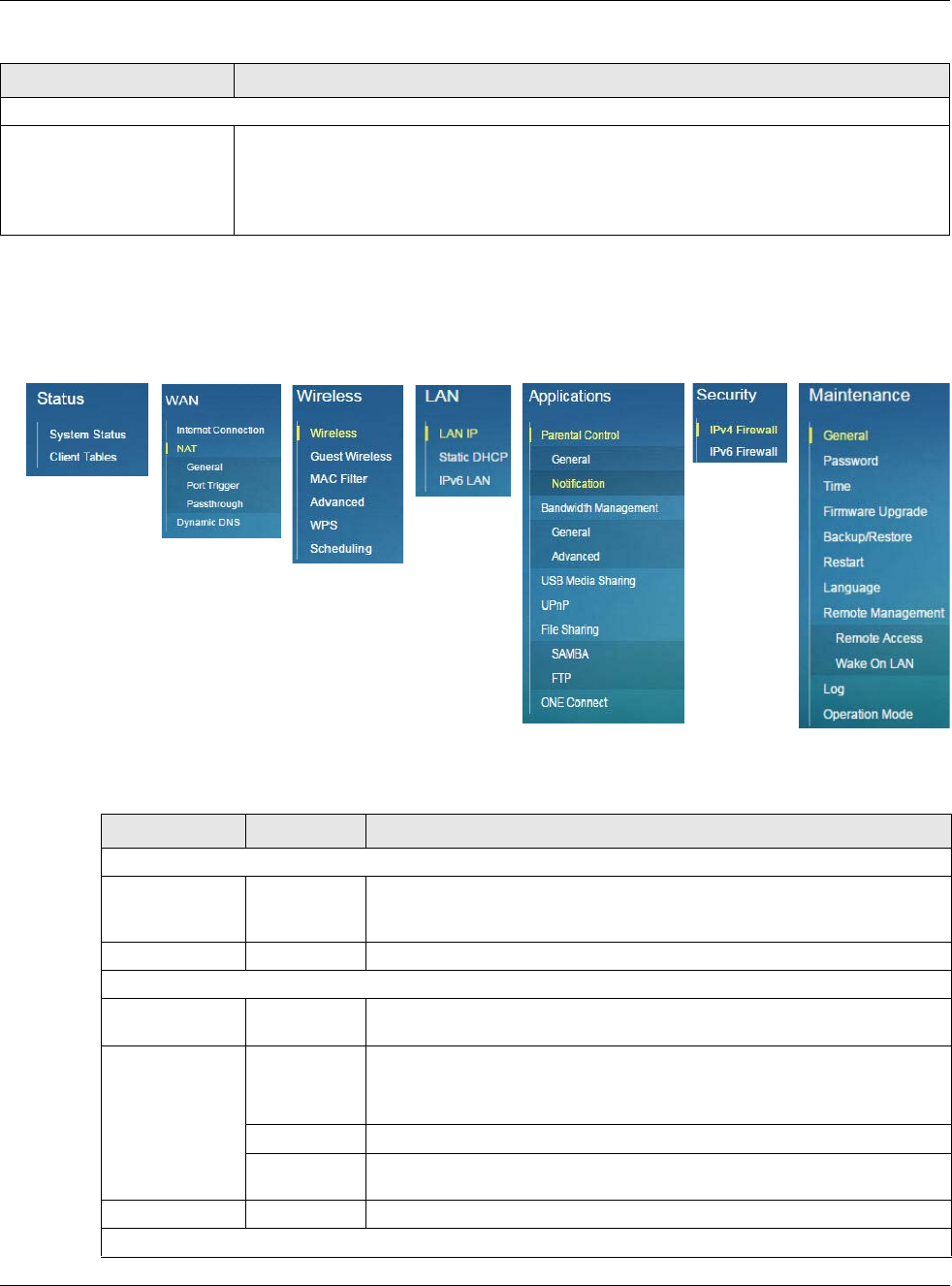
Chapter 6 Router Mode
NBG6617 User’s Guide
39
6.2.1 Navigation Panel
Use the sub-menus on the navigation panel to configure NBG6617 features.
Figure 29 Expert Mode: Navigation Panel: Router Mode
The following table describes the sub-menus.
Printer Information
Printer Name The NBG6617 can act as a print server and allows you to share a USB printer on your LAN.
This displays the name of the printer connected to the NBG6617's USB port.
Note: You need to manually install the printer driver in your computer and add the printer to
your printer list.
Table 15 Expert Mode: Status > System Status: Router Mode (continued)
LABEL DESCRIPTION
Table 16 Expert Mode: Navigation Panel: Router Mode
LINK TAB FUNCTION
Status
System Status This screen shows the NBG6617’s general device, system and interface
status information. Use this screen to access the wizard, and summary
statistics tables.
Client Tables Use this screen to view current DHCP client information.
WAN
Internet
Connection
This screen allows you to configure ISP parameters, WAN IP address
assignment, DNS servers and the WAN MAC address.
NAT General Use this screen to enable NAT.
Use this screen to configure servers behind the NBG6617 and forward
incoming service requests to the server(s) on your local network.
Port Trigger Use this screen to change your NBG6617’s port triggering settings.
Passthrough Use this screen to enable ALGs (Application Layer Gateway) and VPN pass-
through settings.
Dynamic DNS Use this screen to set up dynamic DNS.
Wireless

Chapter 6 Router Mode
NBG6617 User’s Guide
40
Wireless Use this screen to enable the wireless LAN and configure wireless LAN and
wireless security settings.
Guest Wireless Use this screen to configure multiple BSSs on the NBG6617.
MAC Filter Use the MAC filter screen to configure the NBG6617 to block access to
devices or block the devices from accessing the NBG6617.
Advanced This screen allows you to configure advanced wireless settings.
WPS Use this screen to configure WPS.
Scheduling Use this screen to schedule the times the Wireless LAN is enabled.
LAN
LAN IP Use this screen to configure LAN IP address and subnet mask.
Use this screen to configure the IPv6 address for the NBG6617 on the LAN.
Use this screen to enable the NBG6617’s DHCP server.
Static DHCP This screen allows you to assign IP addresses on the LAN to specific
individual computers based on their MAC addresses.
IPv6 LAN Use this screen to configure the IPv6 address for your NBG6617 on the
LAN.
Applications
Parental Control General Use this screen to enable parental control, set parental controls rules/
schedules and block web sites containing certain keywords in the URL.
Notification Use this screen to send e-mail notifications, configure e-mail notification
rules and e-mail settings.
Bandwidth
Management
General Use this screen to enable StreamBoost.
Advanced Use this screen to configure the maximum allowable bandwidth and enable
automatic update.
Use this screen to change the priority of the connected devices.
USB Media
Sharing
Use this screen to have the NBG6617 function as a DLNA-compliant media
server, that lets DLNA-compliant media clients play video, audio, and photo
content files stored on the connected USB storage device.
UPnP Use this screen to enable UPnP on the NBG6617.
File Sharing SAMBA Use this screen to enable file sharing through the NBG6617.
FTP Use this screen to have the NBG6617 act as a FTP server.
One Connect Use this screen to enable or disable Wi-Fi auto-configuration.
Security
IPv4 Firewall Use this screen to configure IPv4 firewall rules.
IPv6 Firewall Use this screen to configure IPv6 firewall rules.
Maintenance
General Use this screen to view and change administrative settings such as system
and domain names.
Password Use this screen to change the password of your NBG6617.
Time Use this screen to change your NBG6617’s time and date.
Firmware
Upgrade
Use this screen to upload firmware to your NBG6617.
Backup/Restore Use this screen to backup and restore the configuration or reset the factory
defaults to your NBG6617.
Table 16 Expert Mode: Navigation Panel: Router Mode (continued)
LINK TAB FUNCTION

Chapter 6 Router Mode
NBG6617 User’s Guide
41
Restart This screen allows you to reboot the NBG6617 without turning the power
off.
Language This screen allows you to select the language you prefer.
Remote
Management
Remote
Access
Use this screen to configure through which interface(s) and from which IP
address(es) users can use Telnet and HTTP/HTTPS to manage the
NBG6617.
Wake On LAN Use this screen to enable Wake on LAN to remotely turn on a device on the
local network.
Log Use this screen to view the list of activities recorded by your NBG6617.
Operation Mode This screen allows you to select whether your device acts as a router, or an
access point.
Table 16 Expert Mode: Navigation Panel: Router Mode (continued)
LINK TAB FUNCTION
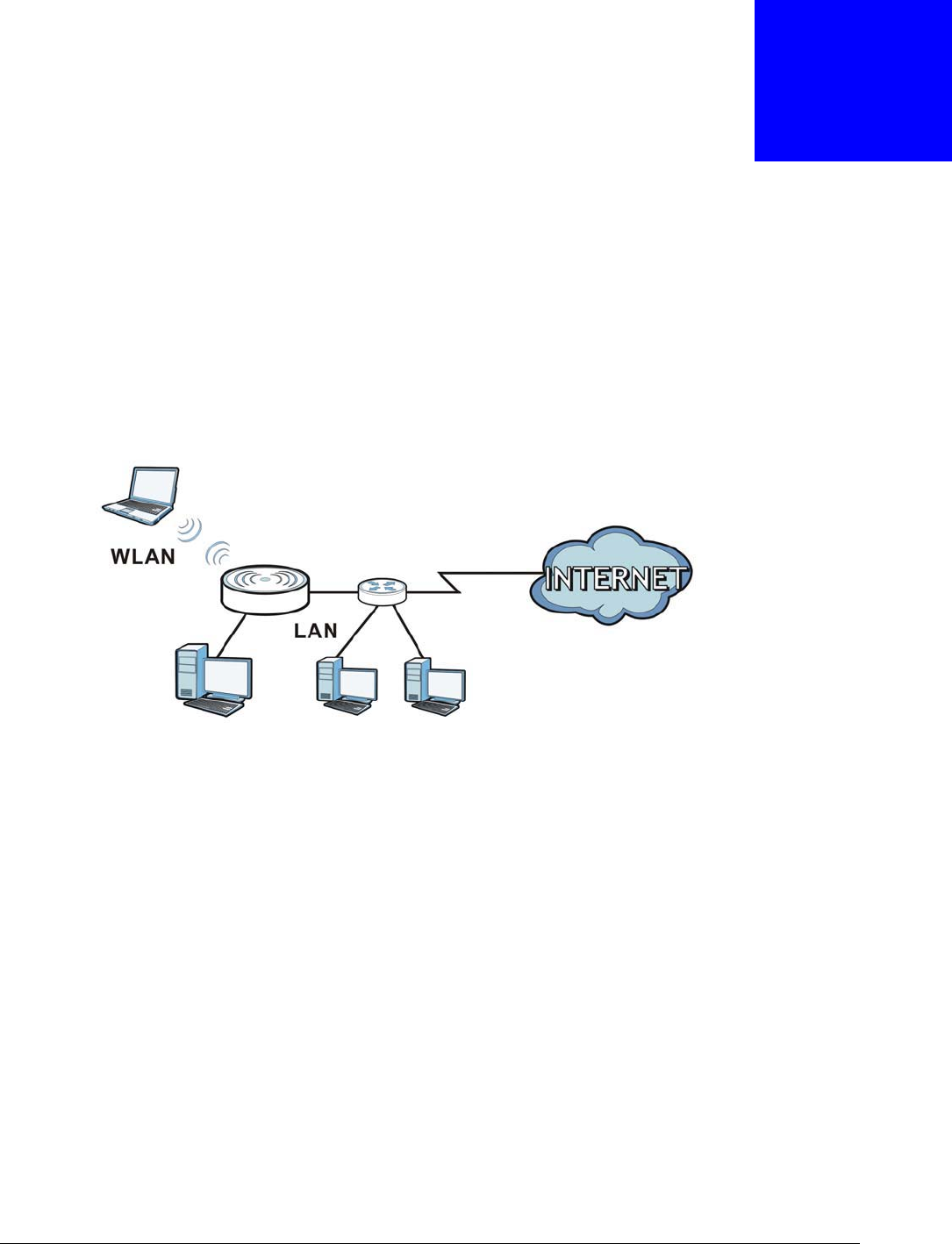
NBG6617 User’s Guide
42
CHAPTER 7
Access Point Mode
7.1 Overview
Use your NBG6617 as an access point (AP) if you already have a router or gateway on your
network. In this mode your NBG6617 bridges a wired network (LAN) and wireless LAN (WLAN) in
the same subnet. See the figure below for an example.
Figure 30 Wireless Internet Access in Access Point Mode
Many screens that are available in Router Mode are not available in Access Point Mode, such as
bandwidth management and firewall.
7.2 What You Can Do
•Use the Status screen to view read-only information about your NBG6617 (Section 7.4 on page
44).
•Use the LAN screen to set the IP address for your NBG6617 acting as an access point (Section
7.5 on page 46).
7.3 What You Need to Know
See Chapter 8 on page 49 for a tutorial on setting up a network with the NBG6617 as an access
point.
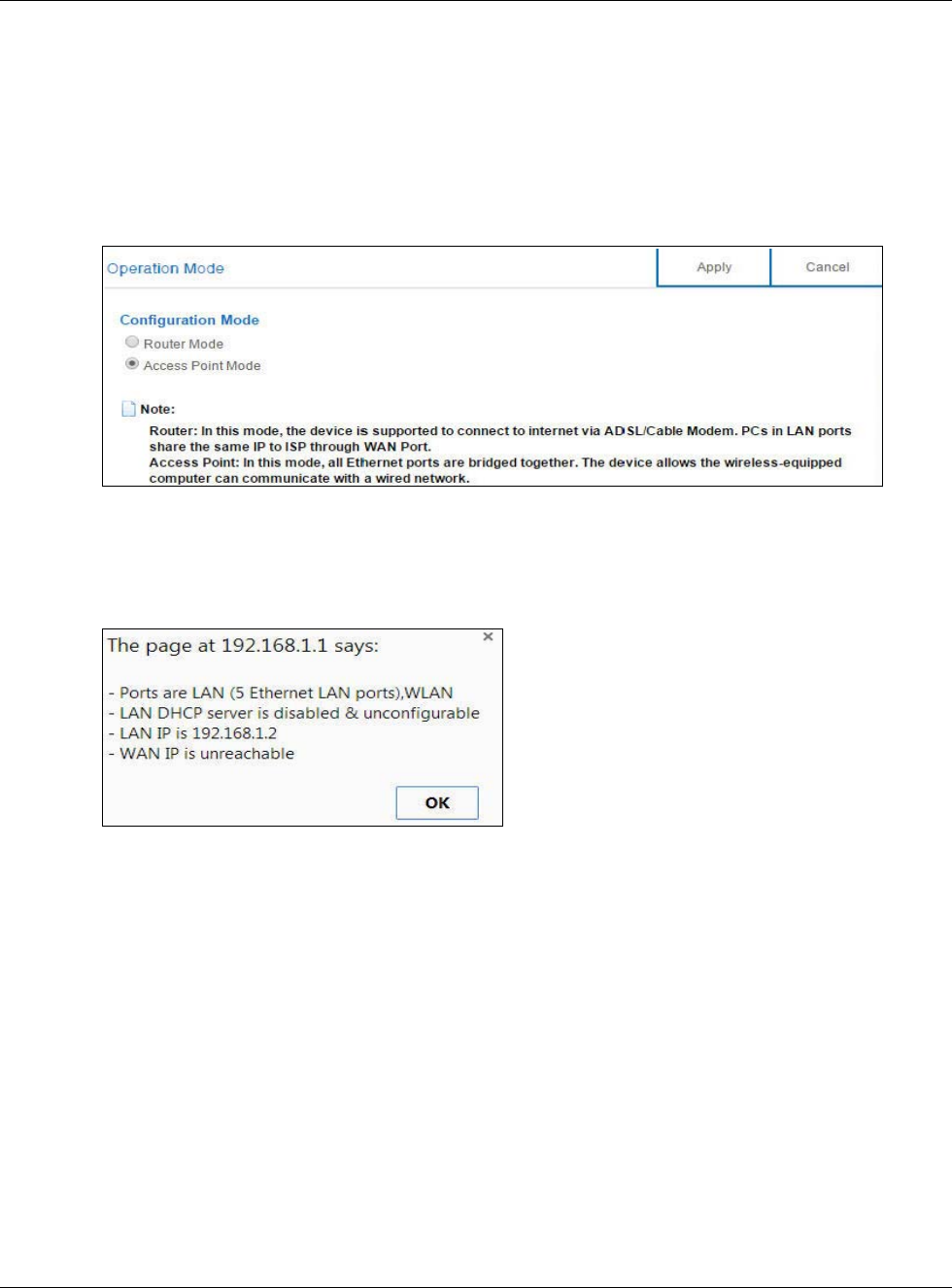
Chapter 7 Access Point Mode
NBG6617 User’s Guide
43
7.3.1 Setting your NBG6617 to AP Mode
1Log into the Web Configurator if you haven’t already. See the Quick start Guide for instructions on
how to do this.
2To use your NBG6617 as an access point, go to Expert Mode > Maintenance > Operation Mode
and select Access Point Mode.
Figure 31 Changing to Access Point mode
Note: You have to log in to the Web Configurator again when you change modes. As soon
as you do, your NBG6617 is already in Access Point mode.
3When you select Access Point Mode, the following pop-up message window appears.
Figure 32 Pop up for Access Point mode
Click OK. Then click Apply. The Web Configurator refreshes once the change to Access Point mode
is successful.
7.3.2 Accessing the Web Configurator in Access Point Mode
Log in to the Web Configurator in Access Point mode, do the following:
1Connect your computer to the LAN port of the NBG6617.
2The default IP address of the NBG6617 is “192.168.1.2”. In this case, your computer must have an
IP address in the range between “192.168.1.3” and “192.168.1.254”.
3Click Start > Run on your computer in Windows. Type “cmd” in the dialog box. Enter “ipconfig” to
show your computer’s IP address. If your computer’s IP address is not in the correct range then see
Appendix B on page 162 for information on changing your computer’s IP address.
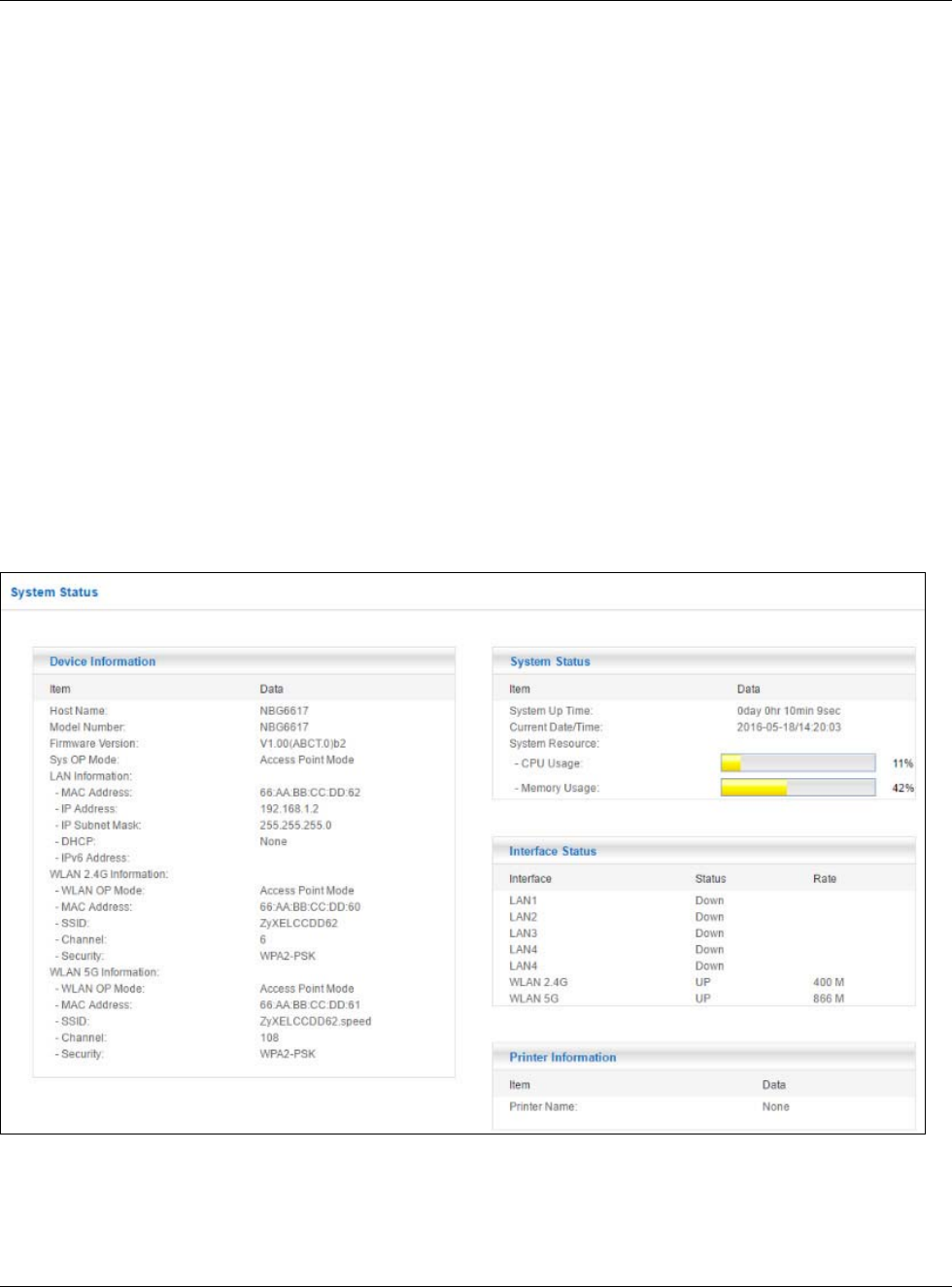
Chapter 7 Access Point Mode
NBG6617 User’s Guide
44
4After you’ve set your computer’s IP address, open a web browser such as Internet Explorer and
type “192.168.1.2” as the web address in your web browser.
Note: After clicking Login, the Easy Mode appears. Refer to Chapter 5 on page 28 for
the Easy Mode screens. Change to Expert Mode to see the screens described in
the sections following this.
7.3.3 Configuring your WLAN and Maintenance Settings
The configuration of wireless and maintenance settings in Access Point Mode is the same as for
Router Mode.
•See Chapter 11 on page 80 for information on the configuring your wireless network.
•See Chapter 15 on page 135 for information on configuring your maintenance settings.
7.4 AP Mode Status Screen
Click Expert Mode > Status to open the Status screen.
Figure 33 Expert Mode: Status > System Status: Access Point Mode

Chapter 7 Access Point Mode
NBG6617 User’s Guide
45
The following table describes the labels shown in the Status screen.
Table 17 Expert Mode: Status > System Status: Access Point Mode
LABEL DESCRIPTION
Device Information
Host Name This is the System Name you enter in the Maintenance > General screen. It is for
identification purposes.
Model Number This is the model name of your device.
Firmware Version This is the firmware version and the date created.
Sys OP Mode This is the device mode (Section 4.1.2 on page 27) to which the NBG6617 is set - AP Mode.
LAN Information
MAC Address This shows the LAN Ethernet adapter MAC Address of your device.
IP Address This shows the LAN port’s IP address.
IP Subnet Mask This shows the LAN port’s subnet mask.
DHCP This shows the LAN port’s DHCP role - Client or None.
IPv6 Address This shows the IPv6 address of the NBG6617 on the LAN.
WLAN 2.4G Information
WLAN OP Mode This is the device mode (Section 4.1.2 on page 27) to which the NBG6617’s wireless LAN is
set - Access Point Mode.
MAC Address This shows the 2.4GHz wireless adapter MAC Address of your device.
SSID This shows a descriptive name used to identify the NBG6617 in the 2.4GHz wireless LAN.
Channel This shows the channel number which you select manually.
Security This shows the level of wireless security the NBG6617 is using.
WLAN 5G Information
WLAN OP Mode This is the device mode (Section 4.1.2 on page 27) to which the NBG6617’s wireless LAN is
set - Access Point Mode.
MAC Address This shows the 5GHz wireless adapter MAC Address of your device.
SSID This shows a descriptive name used to identify the NBG6617 in the 5GHz wireless LAN.
Channel This shows the channel number which you select manually.
Security This shows the level of wireless security the NBG6617 is using.
System Status
Item This column shows the type of data the NBG6617 is recording.
Data This column shows the actual data recorded by the NBG6617.
System Up Time This is the total time the NBG6617 has been on.
Current Date/Time This field displays your NBG6617’s present date and time.
System Resource
- CPU Usage This displays what percentage of the NBG6617’s processing ability is currently used. When
this percentage is close to 100%, the NBG6617 is running at full load, and the throughput is
not going to improve anymore. If you want some applications to have more throughput, you
should turn off other applications (for example, using bandwidth management.)
- Memory Usage This shows what percentage of the heap memory the NBG6617 is using.
Interface Status
Interface This displays the NBG6617 port types. The port types are: LAN and WLAN.
Status For the LAN ports, this field displays Down (line is down) or Up (line is up or connected).
For the 2.4GHz/5GHz WLAN, it displays Up when the 2.4GHz/5GHz WLAN is enabled or
Down when the 2.4G/5G WLAN is disabled.
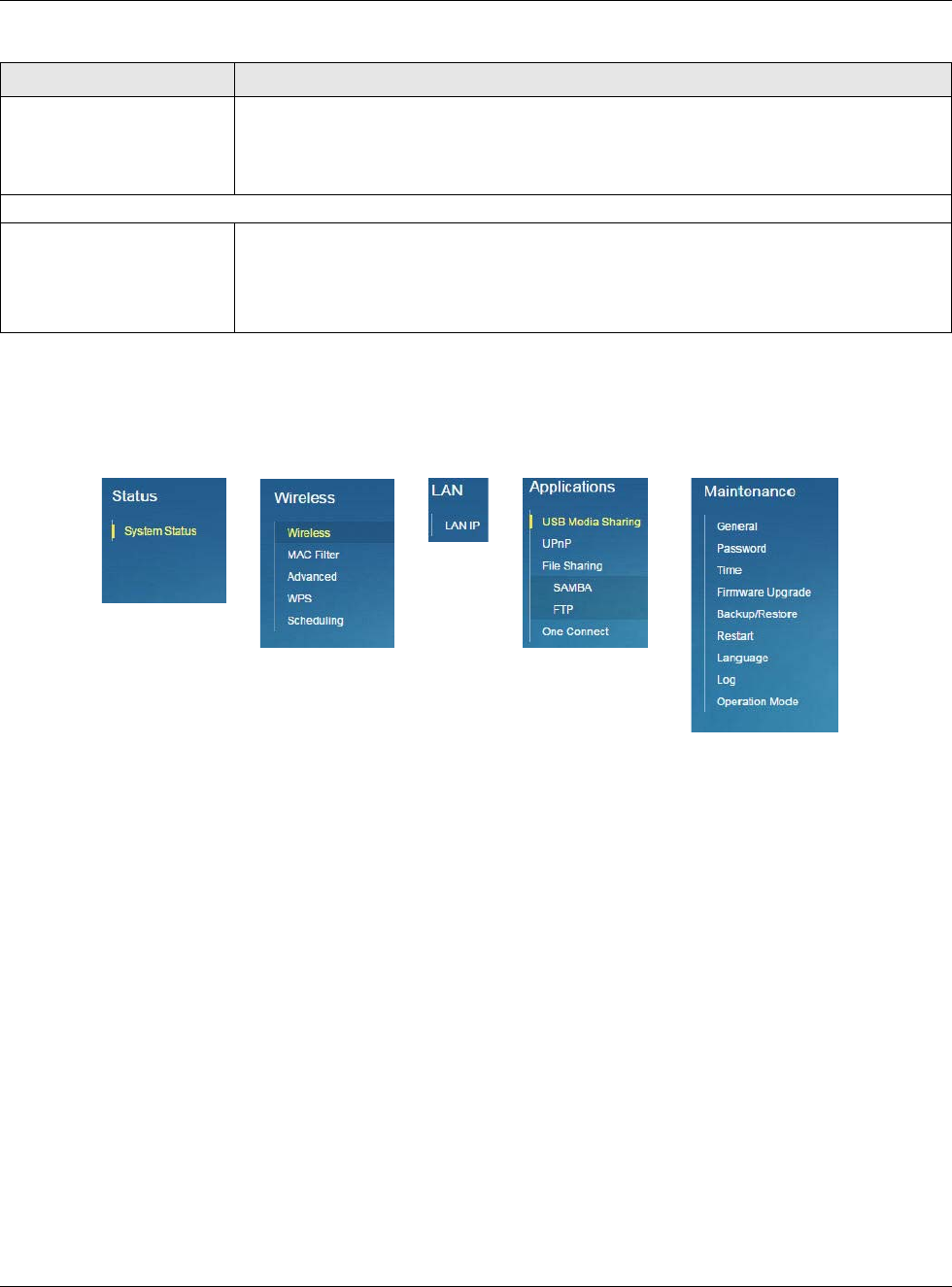
Chapter 7 Access Point Mode
NBG6617 User’s Guide
46
7.4.1 Navigation Panel
Use the menu in the navigation panel to configure NBG6617 features in Access Point Mode.
Figure 34 Expert Mode: Navigation Panel: Access Point Mode
Refer to Table 16 on page 39 for descriptions of the labels shown in the navigation panel.
7.5 LAN Screen
Use this section to configure your LAN settings while in Access Point Mode.
Click Expert Mode > LAN to see the screen below.
Note: If you change the IP address of the NBG6617 in the screen below, you will need to
log into the NBG6617 again using the new IP address.
Rate For the LAN ports, this displays the port speed and duplex setting or is left blank when the
line is disconnected.
For the 2.4GHz/5GHz WLAN, it displays the maximum transmission rate when the 2.4GHz/
5GHz WLAN is enabled and N/A when the WLAN is disabled.
Printer Information
Printer Name The NBG6617 can act as a print server and allows you to share a USB printer on your LAN.
This displays the name of the printer connected to the NBG6617's USB port.
Note: You need to manually install the printer driver in your computer and add the printer to
your printer list.
Table 17 Expert Mode: Status > System Status: Access Point Mode (continued)
LABEL DESCRIPTION
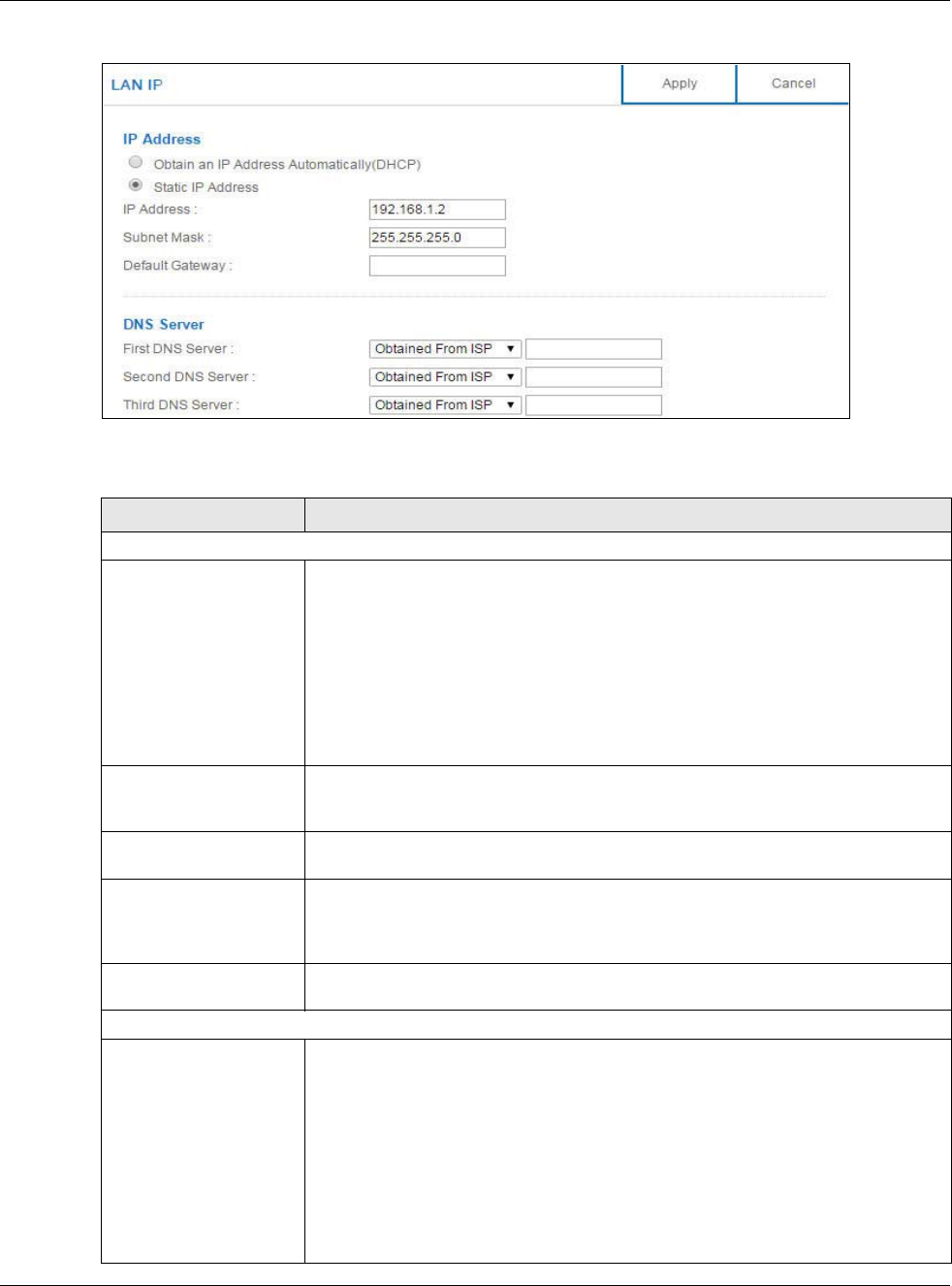
Chapter 7 Access Point Mode
NBG6617 User’s Guide
47
Figure 35 LAN > LAN IP
The table below describes the labels in the screen.
Table 18 LAN > LAN IP
LABEL DESCRIPTION
IP Address
Obtain an IP Address
Automatically
When you enable this, the NBG6617 gets its IP address from the network’s DHCP
server (for example, your ISP). Users connected to the NBG6617 can now access
the network (i.e., the Internet if the IP address is given by the ISP).
The Web Configurator may no longer be accessible unless you know the IP address
assigned by the DHCP server to the NBG6617. You need to reset the NBG6617 to
be able to access the Web Configurator again (see Section 15.7 on page 140 for
details on how to reset the NBG6617).
Also when you select this, you cannot enter an IP address for your NBG6617 in the
field below.
Static IP Address Click this if you want to specify the IP address of your NBG6617. Or if your ISP or
network administrator gave you a static IP address to access the network or the
Internet.
IP Address Type the IP address in dotted decimal notation. The default setting is 192.168.1.2.
If you change the IP address you will have to log in again with the new IP address.
Subnet Mask The subnet mask specifies the network number portion of an IP address. Your
NBG6617 will automatically calculate the subnet mask based on the IP address that
you assign. Unless you are implementing subnetting, use the subnet mask
computed by the NBG6617.
Default Gateway Enter a Default Gateway’s IP address (if your ISP or network administrator gave
you one) in this field.
DNS Server
First DNS Server
Second DNS Server
Third DNS Server
Select Obtained From ISP if your ISP dynamically assigns DNS server information
(and the NBG6617's WAN IP address). The field to the right displays the (read-
only) DNS server IP address that the ISP assigns.
Select User-Defined if you have the IP address of a DNS server. Enter the DNS
server's IP address in the field to the right. If you chose User-Defined, but leave
the IP address set to 0.0.0.0, User-Defined changes to None after you click
Apply. If you set a second choice to User-Defined, and enter the same IP
address, the second User-Defined changes to None after you click Apply.
Select None if you do not want to configure DNS servers. If you do not configure a
DNS server, you must know the IP address of a computer in order to access it.

Chapter 7 Access Point Mode
NBG6617 User’s Guide
48
Apply Click Apply to save your changes to the NBG6617.
Cancel Click Cancel to reload the previous configuration for this screen.
Table 18 LAN > LAN IP (continued)
LABEL DESCRIPTION

NBG6617 User’s Guide
49
CHAPTER 8
Tutorials
8.1 Overview
This chapter provides tutorials for setting up your NBG6617.
•Set Up a Wireless Network Using WPS
•Connect to NBG6617 Wireless Network without WPS
•Using Guest SSIDs on the NBG6617
8.2 Set Up a Wireless Network Using WPS
This section gives you an example of how to set up wireless network using WPS. This example uses
the NBG6617 as the AP and NWD210N as the wireless client which connects to a notebook.
Note: The wireless client must be a WPS-aware device (for example, a WPS USB adapter
or PCI card).
There are two WPS methods for creating a secure connection via the web configurator or utility.
This tutorial shows you how to do both.
•Push Button Configuration (PBC) - create a secure wireless network simply by pressing a
button. See Section 8.2.1 on page 49. This is the easier method.
•PIN Configuration - create a secure wireless network simply by entering a wireless client's PIN
(Personal Identification Number) in the NBG6617’s interface. See Section 8.2.2 on page 50. This
is the more secure method, since one device can authenticate the other.
8.2.1 Push Button Configuration (PBC)
1Make sure that your NBG6617 is turned on. Make sure the WIFI button (at the rear panel of the
NBG6617) is pushed in, and that the device is placed within range of your notebook.
2Make sure that you have installed the wireless client (this example uses the NWD210N) driver and
utility in your notebook.
3In the wireless client utility, find the WPS settings. Enable WPS and press the WPS button (Start or
WPS button)
4Log into NBG6617’s Web Configurator and press the Push Button in the Expert > Wireless >
WPS screen.
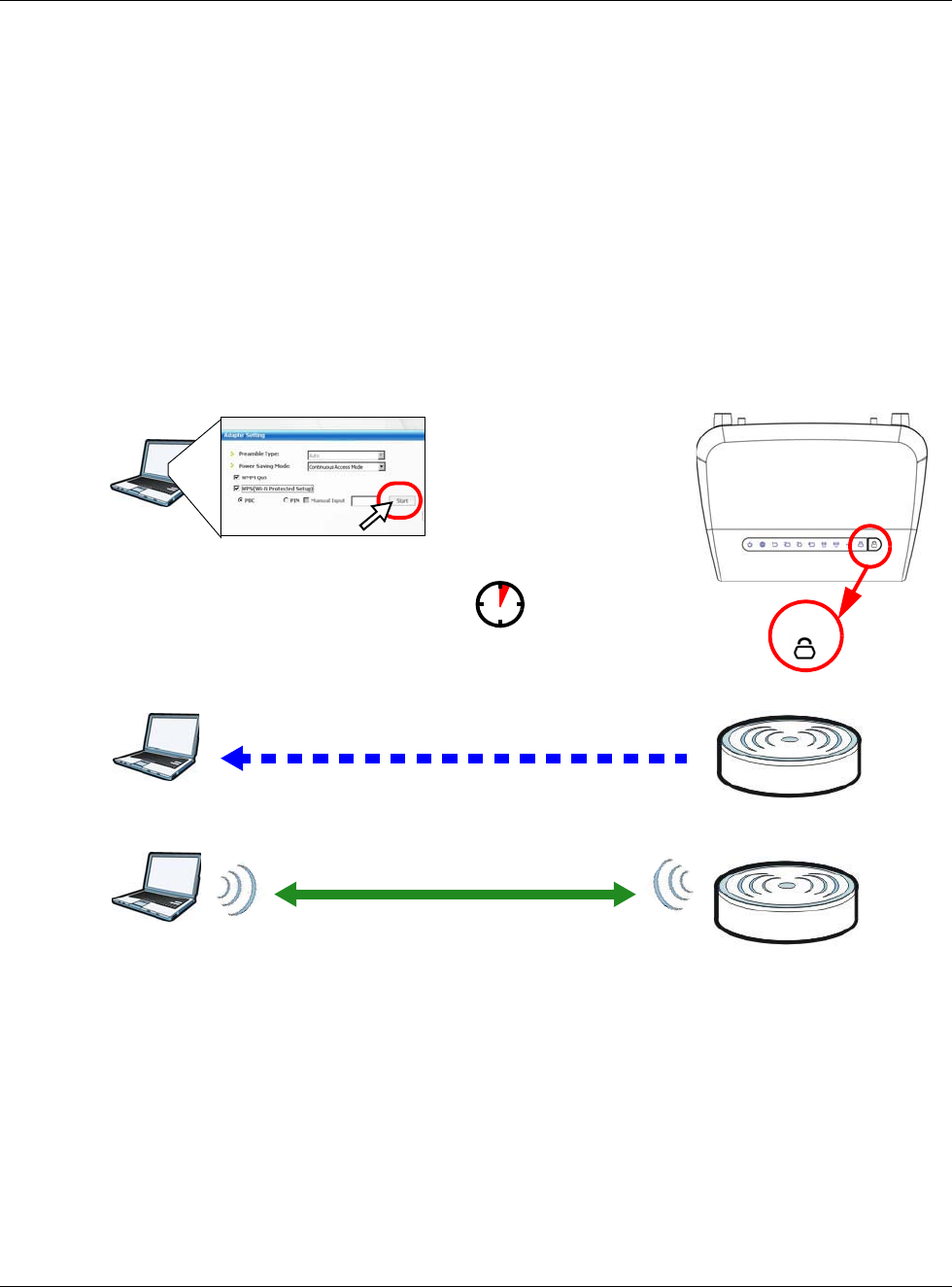
Chapter 8 Tutorials
NBG6617 User’s Guide
50
Note: Your NBG6617 has a WPS button located on its top panel, as well as a WPS button
in its configuration utility. Both buttons have exactly the same function; you can
use one or the other.
Note: It doesn’t matter which button is pressed first. You must press the second button
within two minutes of pressing the first one.
The NBG6617 sends the proper configuration settings to the wireless client. This may take up to
two minutes. Then the wireless client is able to communicate with the NBG6617 securely.
The following figure shows you an example to set up wireless network and security by pressing a
button on both NBG6617 and wireless client (the NWD210N in this example).
Figure 36 Example WPS Process: PBC Method
8.2.2 PIN Configuration
When you use the PIN configuration method, you need to use both NBG6617’s configuration
interface and the client’s utilities.
1Launch your wireless client’s configuration utility. Go to the WPS settings and select the PIN method
to get a PIN number.
2Enter the PIN number to the PIN field in the Expert > Wireless > WPS screen on the NBG6617.
Wireless Client Access Point
SECURITY INFO
COMMUNICATION
WITHIN 2 MINUTES
WPS
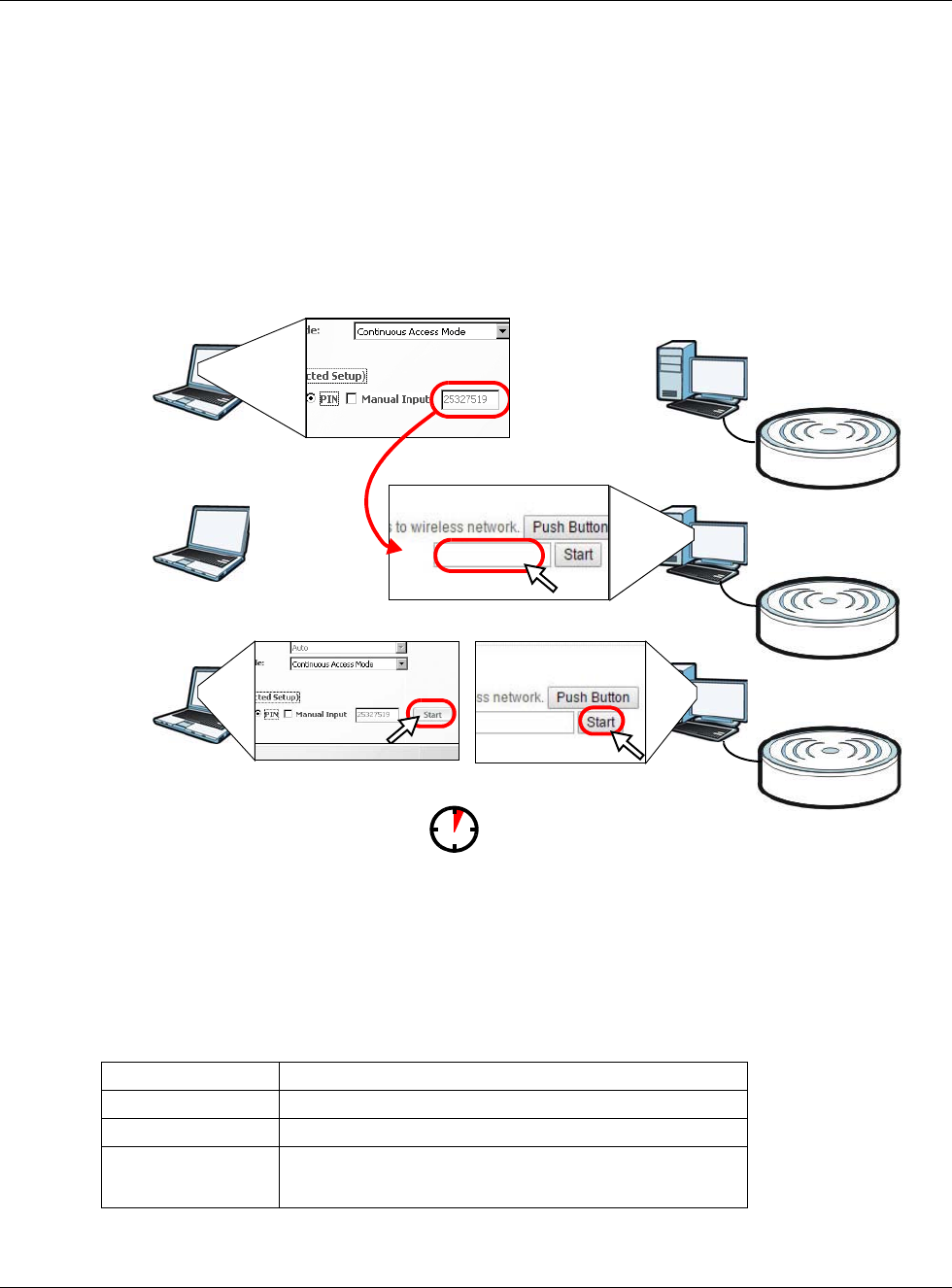
Chapter 8 Tutorials
NBG6617 User’s Guide
51
3Click Start buttons (or button next to the PIN field) on both the wireless client utility screen and the
NBG6617’s WPS screen within two minutes.
The NBG6617 authenticates the wireless client and sends the proper configuration settings to the
wireless client. This may take up to two minutes. Then the wireless client is able to communicate
with the NBG6617 securely.
The following figure shows you the example to set up wireless network and security on NBG6617
and wireless client (ex. NWD210N in this example) by using PIN method.
Figure 37 Example WPS Process: PIN Method
8.3 Connect to NBG6617 Wireless Network without WPS
This example shows you how to configure wireless security settings with the following parameters
on your NBG6617 and connect your computer to the NBG6617 wireless network.
Follow the steps below to configure the wireless settings on your NBG6617.
WITHIN 2 MINUTES
Wireless Client
Access Point
Band 2.4GHz
SSID SSID_Example3
Channel 6
Security WPA2-PSK
(Pre-Shared Key: ThisismyWPA-PSKpre-sharedkey)
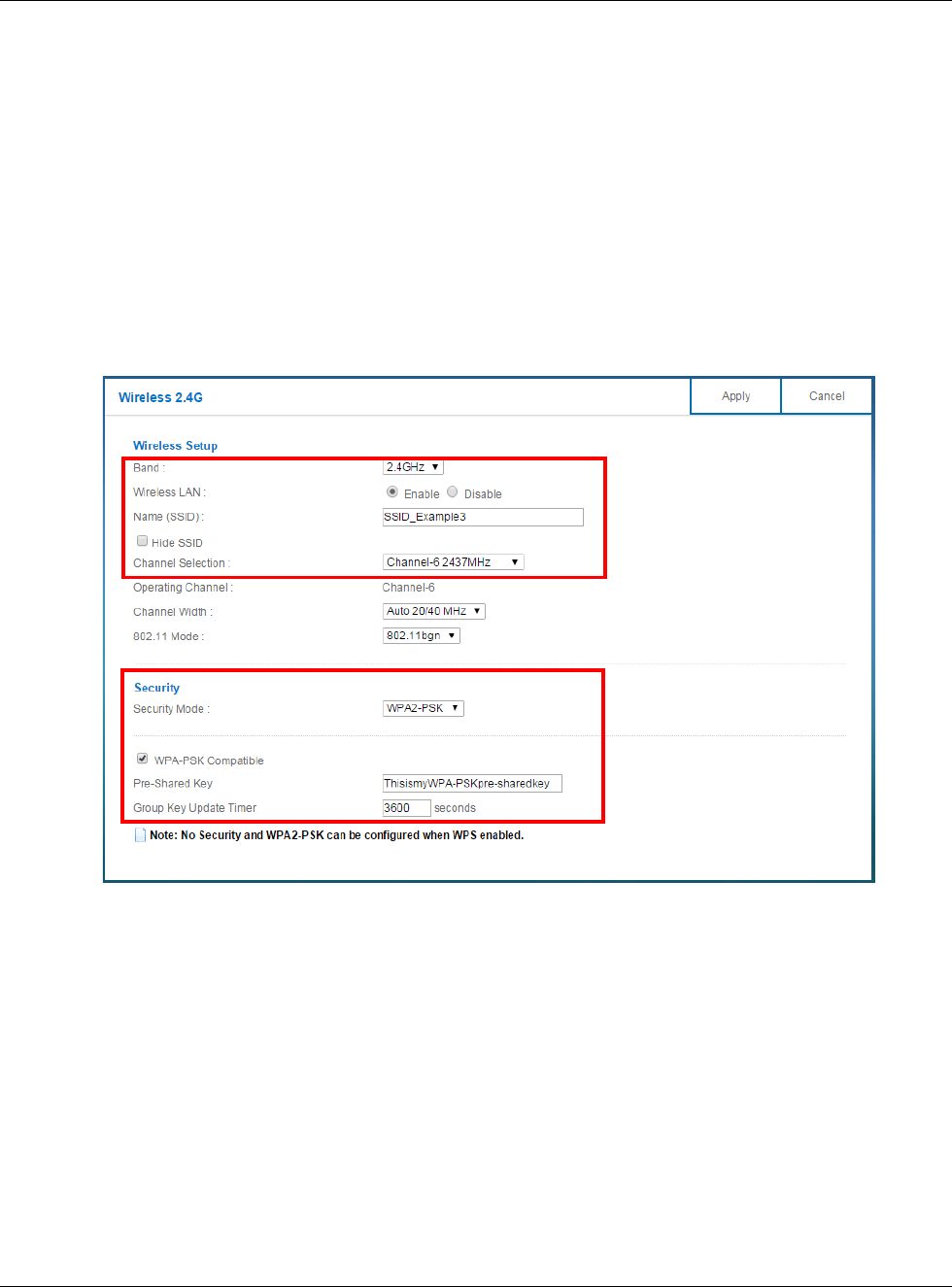
Chapter 8 Tutorials
NBG6617 User’s Guide
52
The instructions require that your hardware is connected (see the Quick Start Guide) and you are
logged into the Web Configurator through your LAN connection (see Section 2.2 on page 15).
1Make sure the WIFI switch (at the rear panel of the NBG6617) is set to ON.
2Open the Expert > Wireless > Wireless screen in the AP’s Web Configurator.
3Confirm that the wireless LAN is enabled on the NBG6617.
4Select to configure the wireless settings for the 2.4GHz wireless radio.
5Enter SSID_Example3 as the SSID and select Channel-06 as the channel. Set security mode to
WPA2-PSK and enter ThisismyWPA-PSKpre-sharedkey in the Pre-Shared Key field. Click
Apply.
6Click Expert > Status to open the Status screen. Verify your wireless and wireless security
settings under Device Information and check if the WLAN connection is up under Interface
Status.
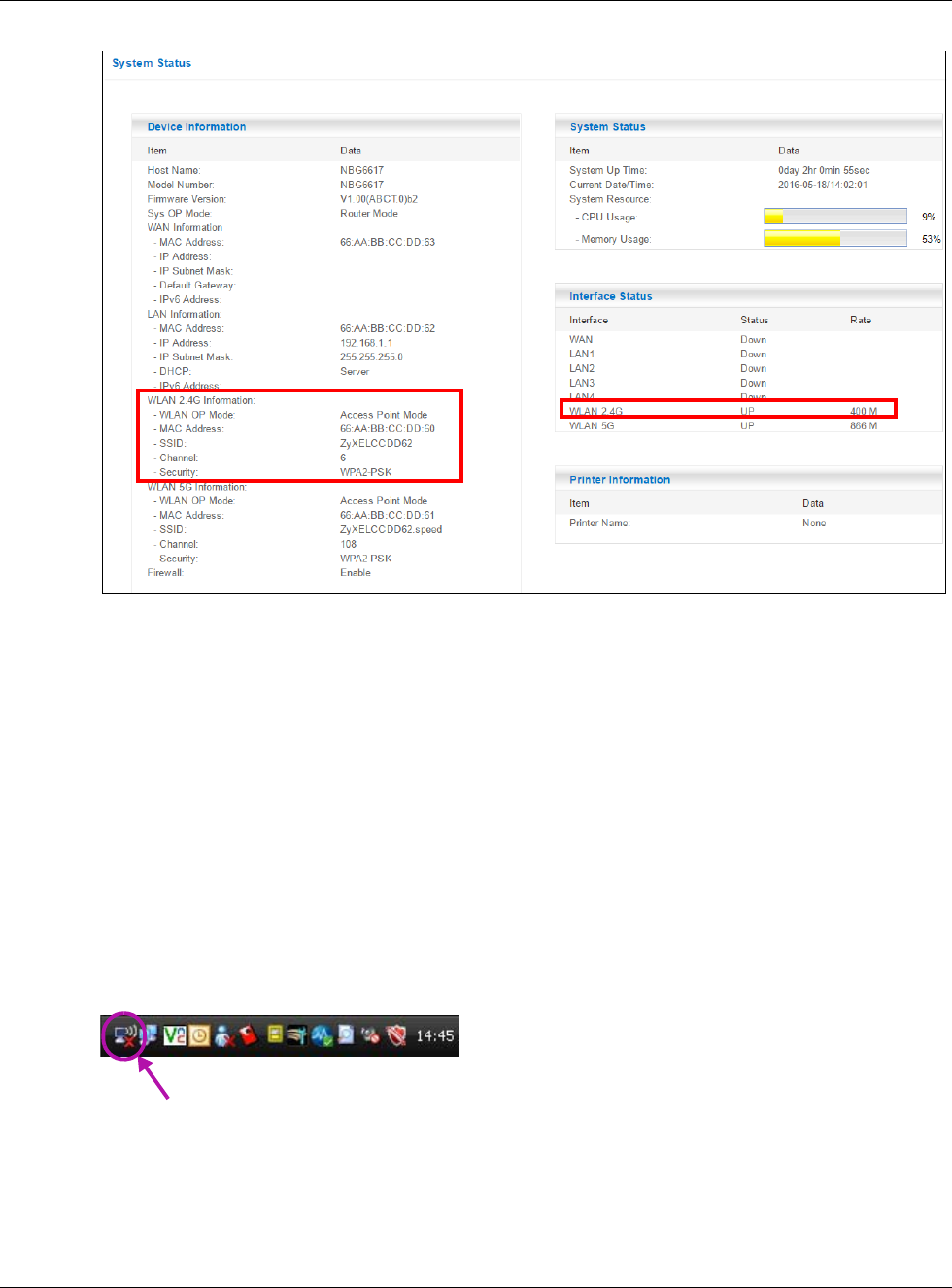
Chapter 8 Tutorials
NBG6617 User’s Guide
53
8.3.1 Configure Your Notebook
Note: In this example, we use the ZyXEL NWD6505 wireless adapter as the wireless
client and use the Windows built-in utility (Windows Zero Configuration (WZC)) to
connect to the wireless netwok.
1The NBG6617 supports IEEE 802.11a, IEEE 802.11b, IEEE 802.11g, IEEE 802.11n and IEEE
802.11ac wireless clients. Make sure that your notebook or computer’s wireless adapter supports
one of these standards.
2Wireless adapters come with software sometimes called a “utility” that you install on your
computer. See your wireless adapter’s User’s Guide for information on how to do that.
3After you’ve installed the driver and attached the NWD6505 to your computer’s USB port, right-
click the Wireless Network Connection icon in your computer’s system tray, select and click
View Available Wireless Networks.
4The Wireless Network Connection screen displays. Click Refresh network list to view the
available wireless APs within range.
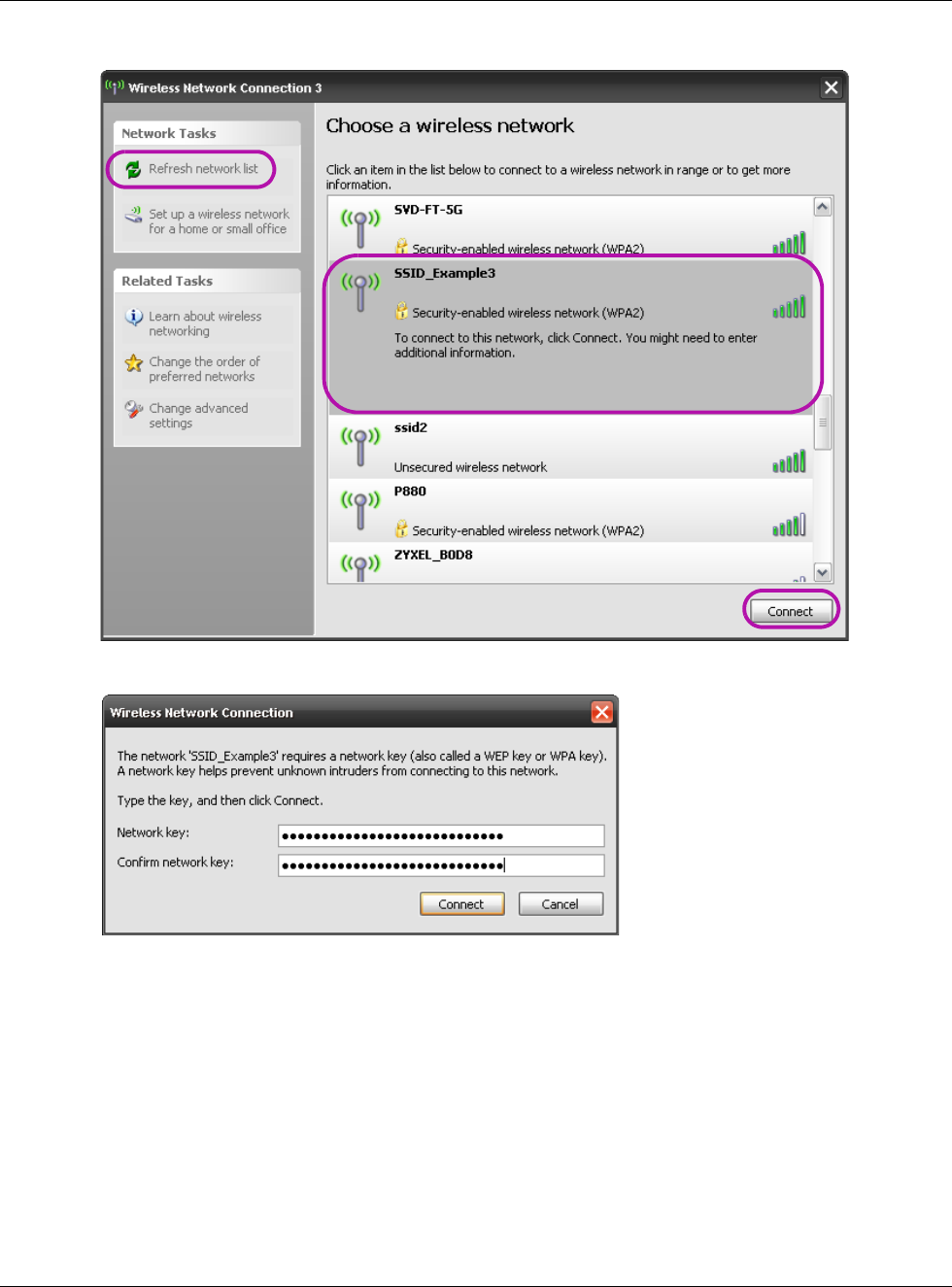
Chapter 8 Tutorials
NBG6617 User’s Guide
54
5Select SSID_Example3 and click Connect.
6Type the security key in the following screen. Click Connect.
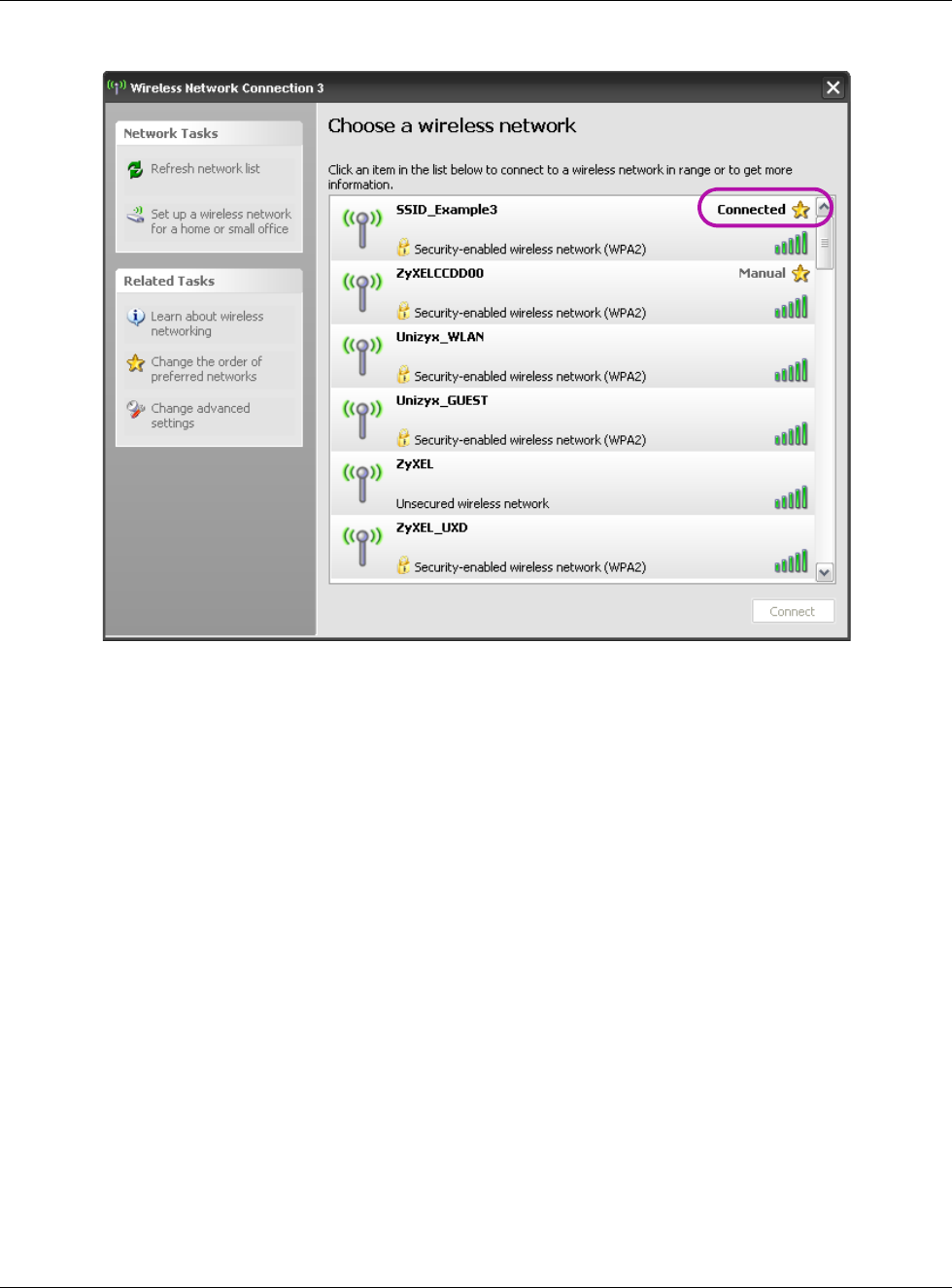
Chapter 8 Tutorials
NBG6617 User’s Guide
55
7Check the status of your wireless connection in the screen below.
8If the wireless client keeps trying to connect to or acquiring an IP address from the NBG6617, make
sure you entered the correct security key.
If the connection has limited or no connectivity, make sure the DHCP server is enabled on the
NBG6617.
If your connection is successful, open your Internet browser and enter http://www.zyxel.com or the
URL of any other web site in the address bar. If you are able to access the web site, your wireless
connection is successfully configured.
8.4 Using Guest SSIDs on the NBG6617
You can configure more than one guest SSID on a NBG6617. See Section 11.4 on page 91.
This allows you to configure multiple independent wireless networks on the NBG6617 as if there
were multiple APs (virtual APs). Each guest SSID has its own wireless security type. That is, each
SSID on the NBG6617 represents a different access point/wireless network to wireless clients in the
network.
Clients can associate only with the SSIDs for which they have the correct security settings. Clients
using different SSIDs can access the Internet and the wired network behind the NBG6617 (such as
a printer).
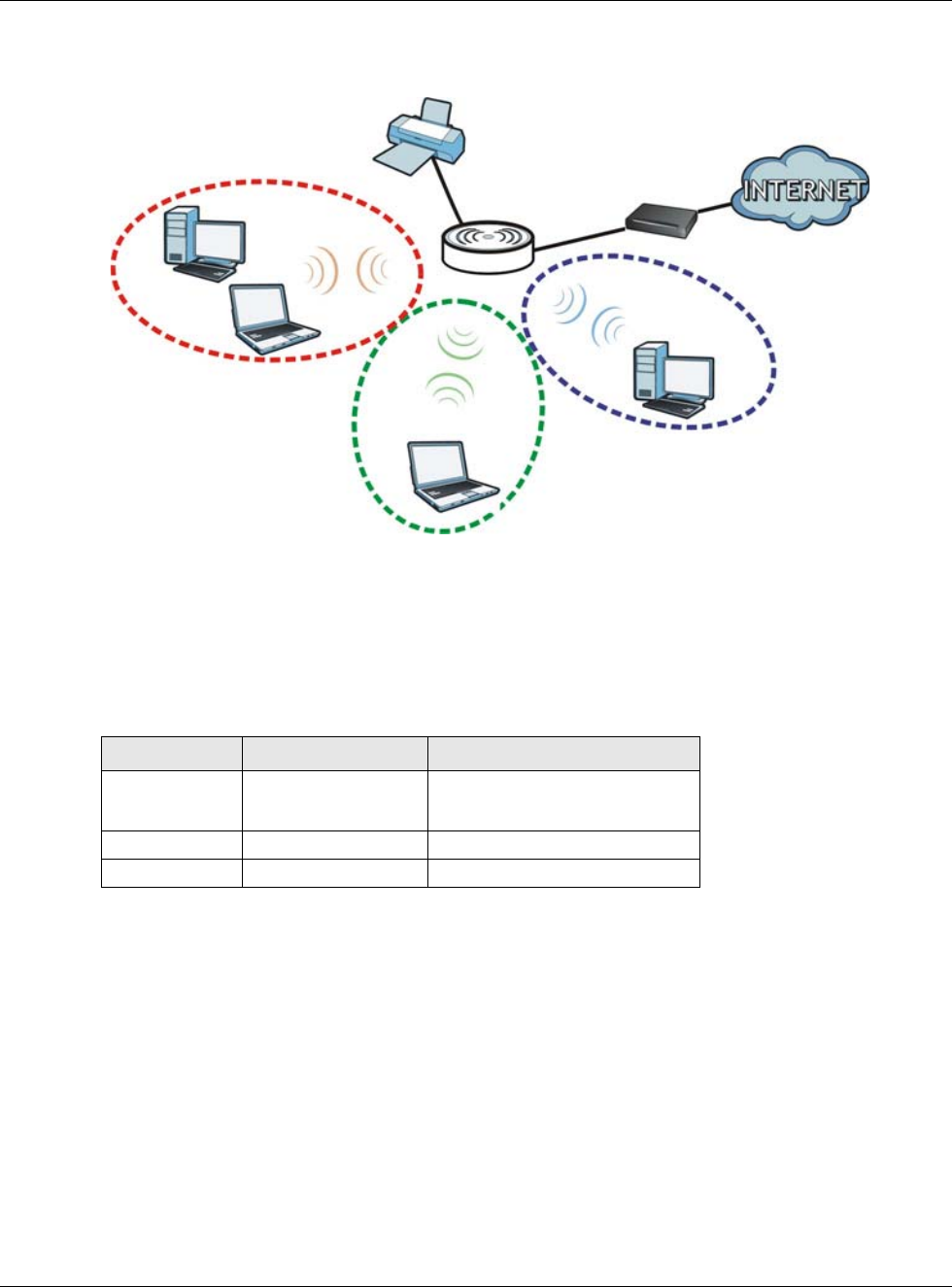
Chapter 8 Tutorials
NBG6617 User’s Guide
56
For example, you may set up three wireless networks (A, B and C) in your office. A is for workers,
B is for guests and C is specific to a VoIP device in the meeting room.
8.4.1 Configuring Security Settings of Guest SSIDs
The NBG6617 is in router mode by default.
This example shows you how to configure the SSIDs with the following parameters on your
NBG6617 (in router mode).
Note: This tutorial assumes that you have disabled WPS in Expert > Wireless > WPS.
Otherwise, the “WPA-PSK” security type is not available to configure.
1Connect your computer to the LAN port of the NBG6617 using an Ethernet cable.
2The default IP address of the NBG6617 in router mode is “192.168.1.1”. In this case, your
computer must have an IP address in the range between “192.168.1.2” and “192.168.1.254”.
3Click Start > Run on your computer in Windows. Type “cmd” in the dialog box. Enter “ipconfig” to
show your computer’s IP address. If your computer’s IP address is not in the correct range then see
Appendix B on page 162 for information on changing your computer’s IP address.
4After you’ve set your computer’s IP address, open a web browser such as Internet Explorer and
type “http://192.168.1.1” as the web address in your web browser.
A
B
C
SSID_Guest
SSID_Worker
SSID_VoIP
SSID SECURITY TYPE KEY
SSID_Worker WPA2-PSK
WPA Compatible
DoNotStealMyWirelessNetwork
SSID_VoIP WPA-PSK VoIPOnly12345678
SSID_Guest WPA-PSK keyexample123
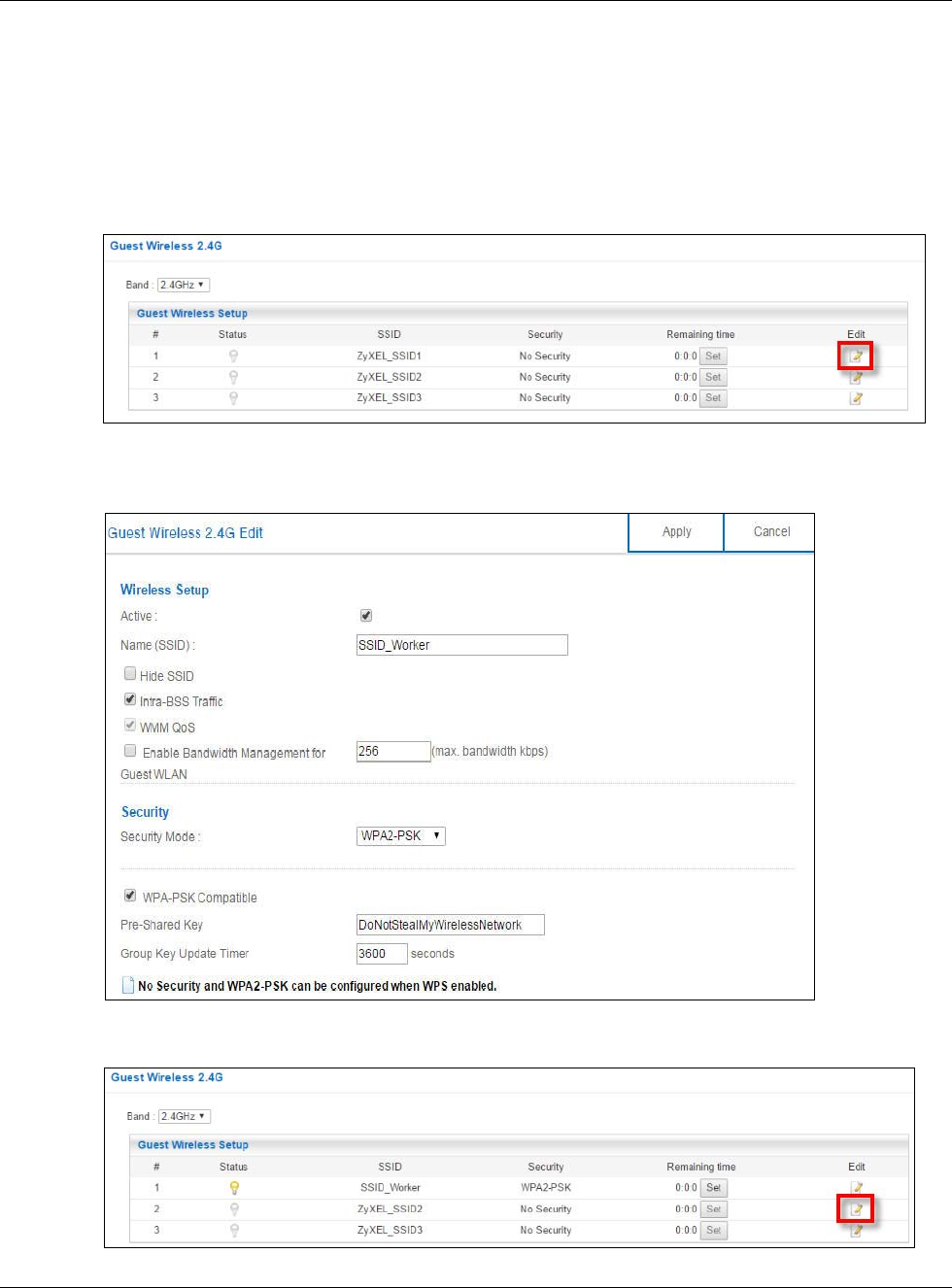
Chapter 8 Tutorials
NBG6617 User’s Guide
57
5Enter “1234” (default) as the password and click Login.
6Type a new password and retype it to confirm, then click Apply. Otherwise, click Ignore.
7The Easy Mode appears.
8Go to Expert > Wireless > Guest Wireless. Click the Edit icon of the first entry to configure
wireless and security settings for SSID_Worker.
9Configure the screen as follows. In this example, you enable Intra-BSS Traffic for SSID_Worker
to allow wireless clients in the same wireless network to communicate with each other. Click Apply.
10 Click the Edit icon of the second entry to configure wireless and security settings for SSID_VoIP.
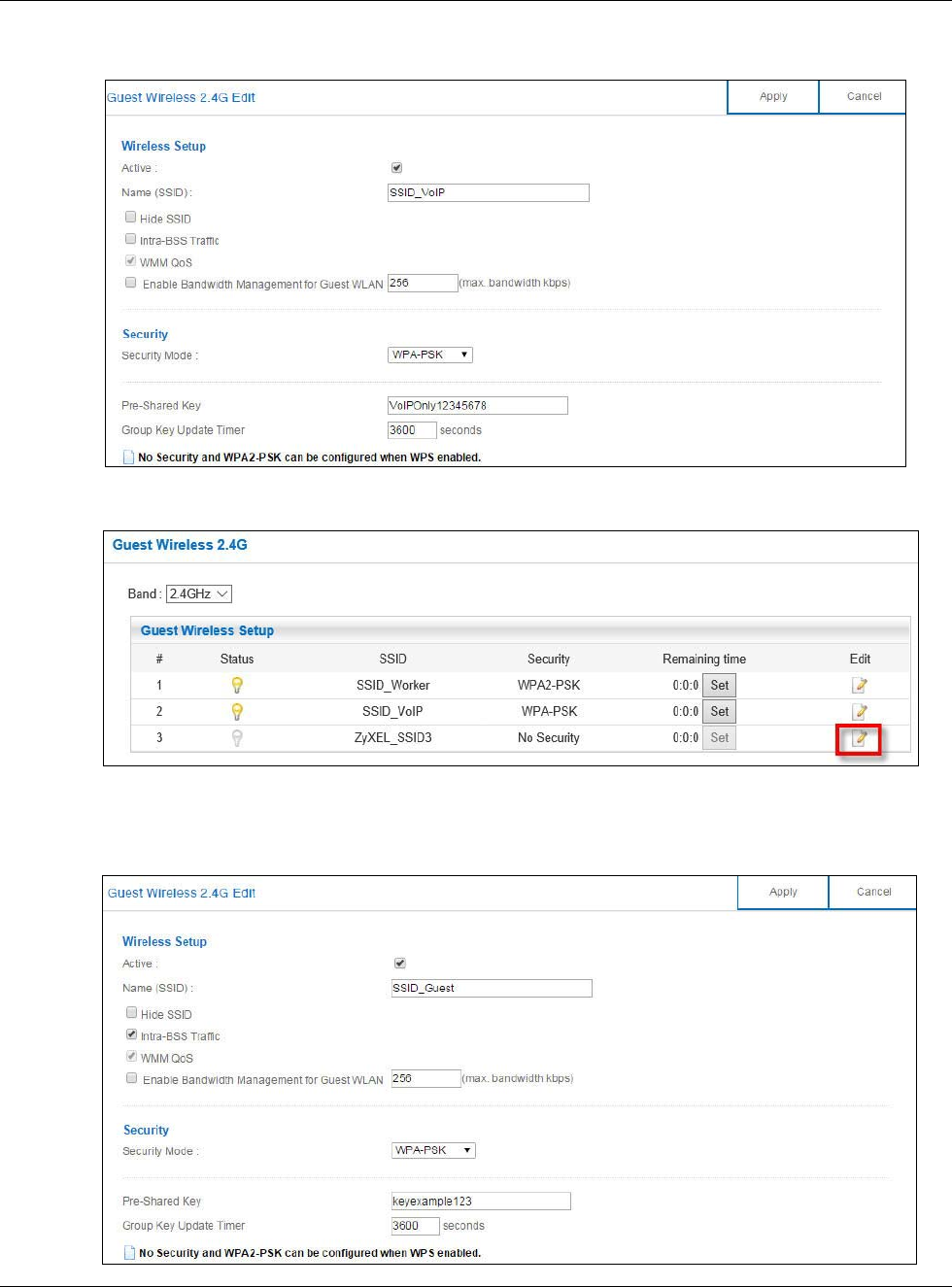
Chapter 8 Tutorials
NBG6617 User’s Guide
58
11 Configure the screen as follows. You do not enable Intra-BSS Traffic for SSID_VoIP. Click Apply.
12 Click the Edit icon of the third entry to configure wireless and security settings for SSID_Guest.
13 Configure the screen as follows. In this example, you enable Intra-BSS Traffic for SSID_Guest to
allow wireless clients in the same wireless network to communicate with each other. Select Enable
Guest WLAN to allow clients to access the Internet only. Click Apply.

59
PART II
Technical Reference
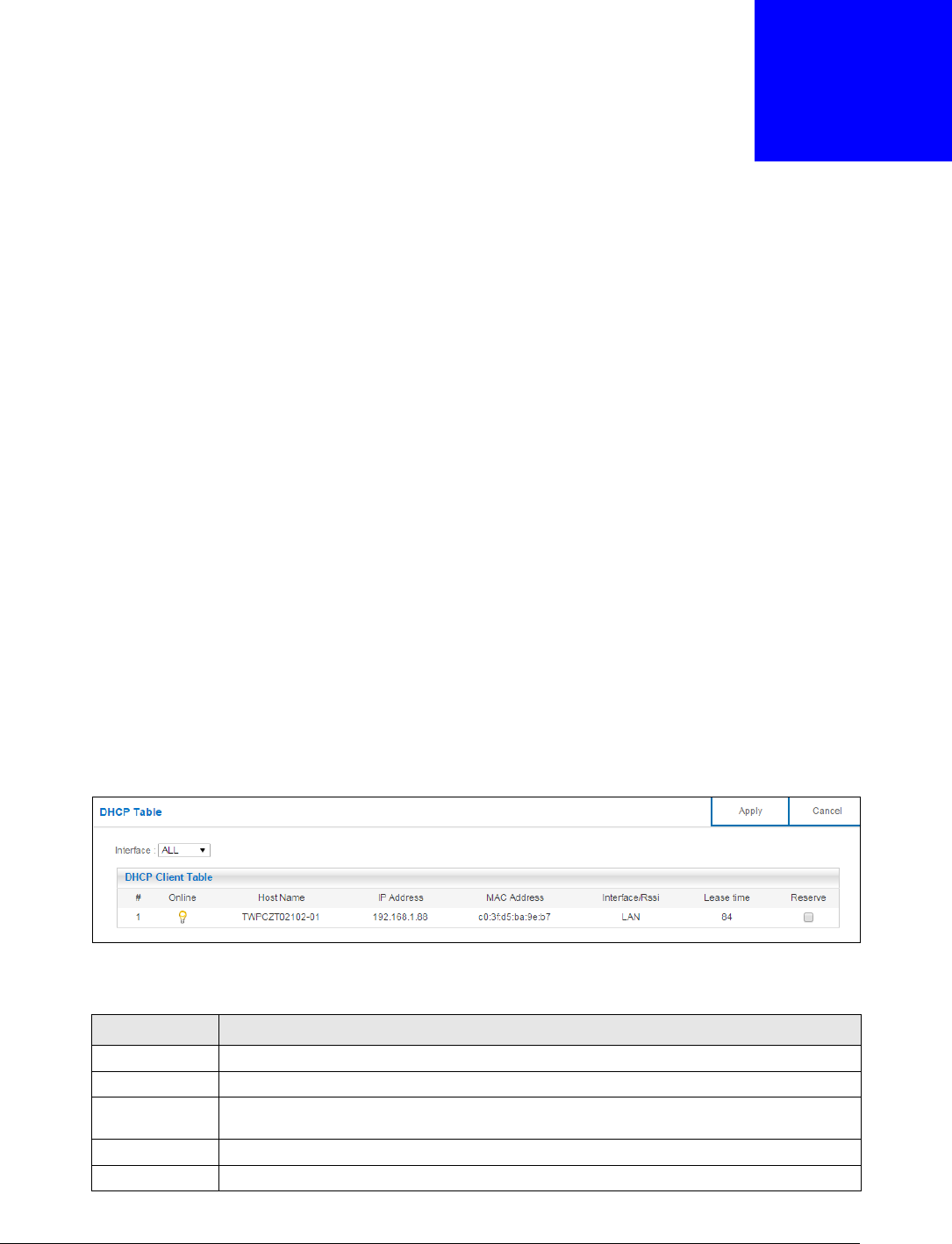
NBG6617 User’s Guide
60
CHAPTER 9
Status
9.1 Overview
This chapter discusses read-only information related to the device state of the NBG6617.
9.1.1 What You Can Do
•Use the Client Tables screen to view the current DHCP client information (Section 9.2 on page
60).
9.2 Client Tables Screen
You can configure the NBG6617’s LAN as a DHCP server or disable it. When configured as a server,
the NBG6617 assigns IP addresses to the clients. If DHCP service is disabled, you must have
another DHCP server on that network, or else the computer must be manually configured.
Use this screen to view current DHCP client information (including MAC Address, and IP Address) of
all network clients using the NBG6617’s DHCP server.
Click Expert Mode > Status > Client Tables to open the Client Tables screen.
Figure 38 Expert Mode > Status > Client Tables
The following table describes the labels in this screen.
Table 19 Expert Mode > Status > Client Tables
LABEL DESCRIPTION
Interface Select the interface from the drop-down list box to display current DHCP client information.
# This is the index number of the host computer.
Online This field displays whether the connection to the host computer is up (a yellow bulb) or
down (a gray bulb).
Host Name This field displays the computer host name.
IP Address This field displays the IP address relative to the # field listed above.

Chapter 9 Status
NBG6617 User’s Guide
61
MAC Address This field shows the MAC address of the computer with the name in the Host Name field.
Every Ethernet device has a unique MAC (Media Access Control) address which uniquely
identifies a device. The MAC address is assigned at the factory and consists of six pairs of
hexadecimal characters, for example, 00:A0:C5:00:00:02.
Interface/Rssi This field displays the device’s interface type or received signal strength indicator (RSSI)
that is currently connected to the NBG6617.
Lease time This field displays the amount of time that the IP address is valid.
Reserve Select this if you want to reserve the IP address for this specific MAC address.
Apply Click Apply to save your changes back to the NBG6617.
Cancel Click Cancel to reload the previous configuration for this screen.
Table 19 Expert Mode > Status > Client Tables
LABEL DESCRIPTION
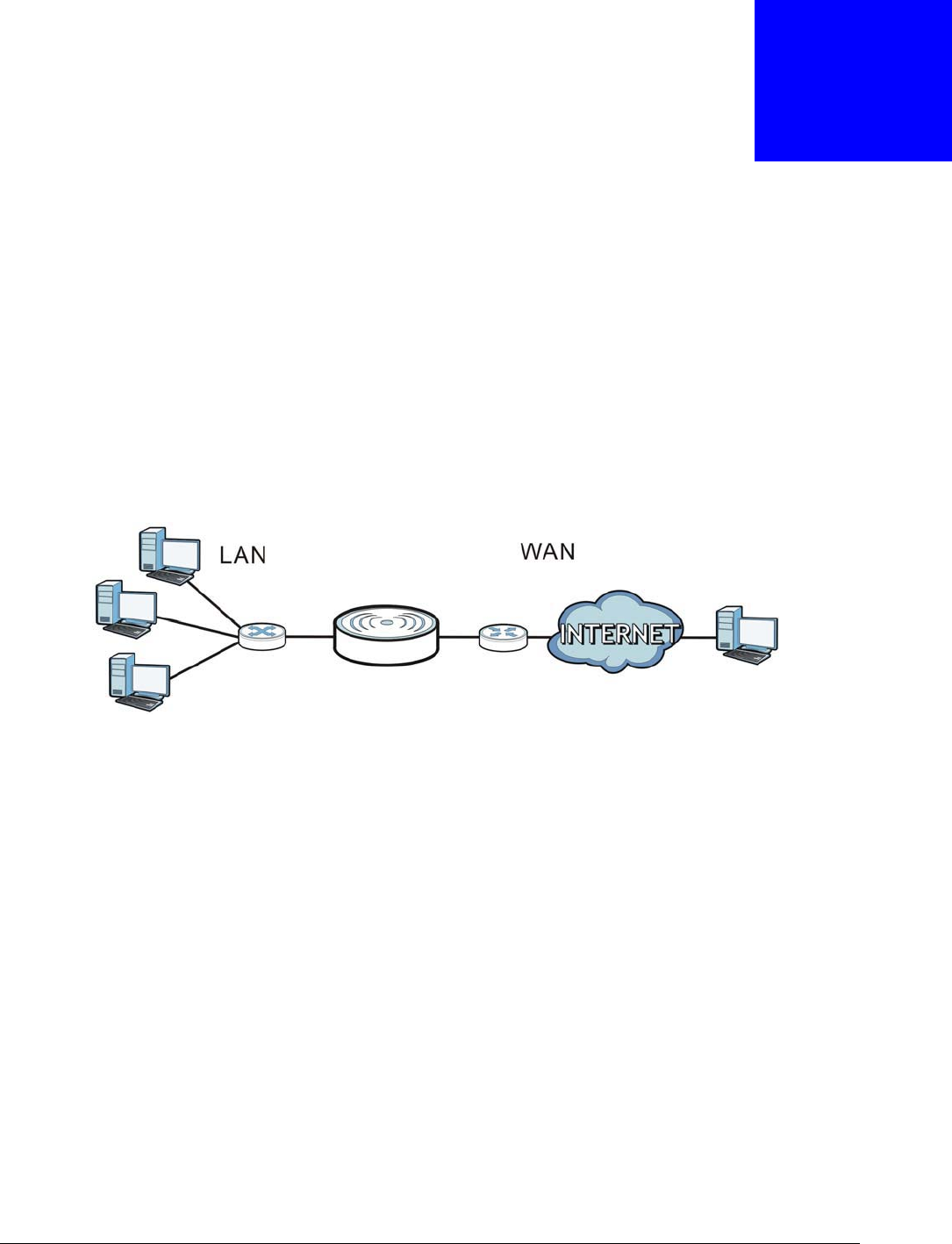
NBG6617 User’s Guide
62
CHAPTER 10
WAN
10.1 Overview
This chapter discusses the NBG6617’s WAN screens. Use these screens to configure your NBG6617
for Internet access.
A WAN (Wide Area Network) connection is an outside connection to another network or the
Internet. It connects your private networks such as a LAN (Local Area Network) and other
networks, so that a computer in one location can communicate with computers in other locations.
Figure 39 LAN and WAN
10.2 What You Can Do
•Use the Internet Connection screen to enter your ISP information and set how the computer
acquires its IP, DNS and WAN MAC addresses (Section 10.4 on page 65).
•
•Use the NAT > General screen to enable NAT, set a default server and change your NBG6617’s
port forwarding settings (Section 10.5.1 on page 74).
•Use the NAT > Port Trigger screen to configure your NBG6617’s trigger port settings (Section
10.5.2 on page 76).
•Use the NAT > Passthrough screen to configure your NBG6617’s ALGs and VPN pass-through
settings (Section 10.5.3 on page 77).
•Use the Dynamic DNS screen to change your NBG6617’s DDNS settings (Section 10.6 on page
78).
10.3 What You Need To Know
The information in this section can help you configure the screens for your WAN connection, as well
as enable/disable some advanced features of your NBG6617.

Chapter 10 WAN
NBG6617 User’s Guide
63
10.3.1 Configuring Your Internet Connection
Encapsulation Method
Encapsulation is used to include data from an upper layer protocol into a lower layer protocol. To set
up a WAN connection to the Internet, you need to use the same encapsulation method used by your
ISP (Internet Service Provider). If your ISP offers a dial-up Internet connection using PPPoE (PPP
over Ethernet) or PPTP (Point-to-Point Tunneling Protocol), they should also provide a username
and password (and service name) for user authentication.
WAN IP Address
The WAN IP address is an IP address for the NBG6617, which makes it accessible from an outside
network. It is used by the NBG6617 to communicate with other devices in other networks. It can be
static (fixed) or dynamically assigned by the ISP each time the NBG6617 tries to access the
Internet.
If your ISP assigns you a static WAN IP address, they should also assign you the subnet mask and
DNS server IP address(es) (and a gateway IP address if you use the Ethernet or ENET ENCAP
encapsulation method).
DNS Server Address Assignment
Use Domain Name System (DNS) to map a domain name to its corresponding IP address and vice
versa, for instance, the IP address of www.zyxel.com is 204.217.0.2. The DNS server is extremely
important because without it, you must know the IP address of a computer before you can access
it.
The NBG6617 can get the DNS server addresses in the following ways.
1The ISP tells you the DNS server addresses, usually in the form of an information sheet, when you
sign up. If your ISP gives you DNS server addresses, manually enter them in the DNS server fields.
2If your ISP dynamically assigns the DNS server IP addresses (along with the NBG6617’s WAN IP
address), set the DNS server fields to get the DNS server address from the ISP.
WAN MAC Address
The MAC address screen allows users to configure the WAN port's MAC address by either using the
factory default or cloning the MAC address from a computer on your LAN. Choose Factory Default
to select the factory assigned default MAC Address.
Otherwise, click Clone the computer's MAC address - IP Address and enter the IP address of
the computer on the LAN whose MAC you are cloning. Once it is successfully configured, the
address will be copied to configuration file. It is recommended that you clone the MAC address prior
to hooking up the WAN Port.
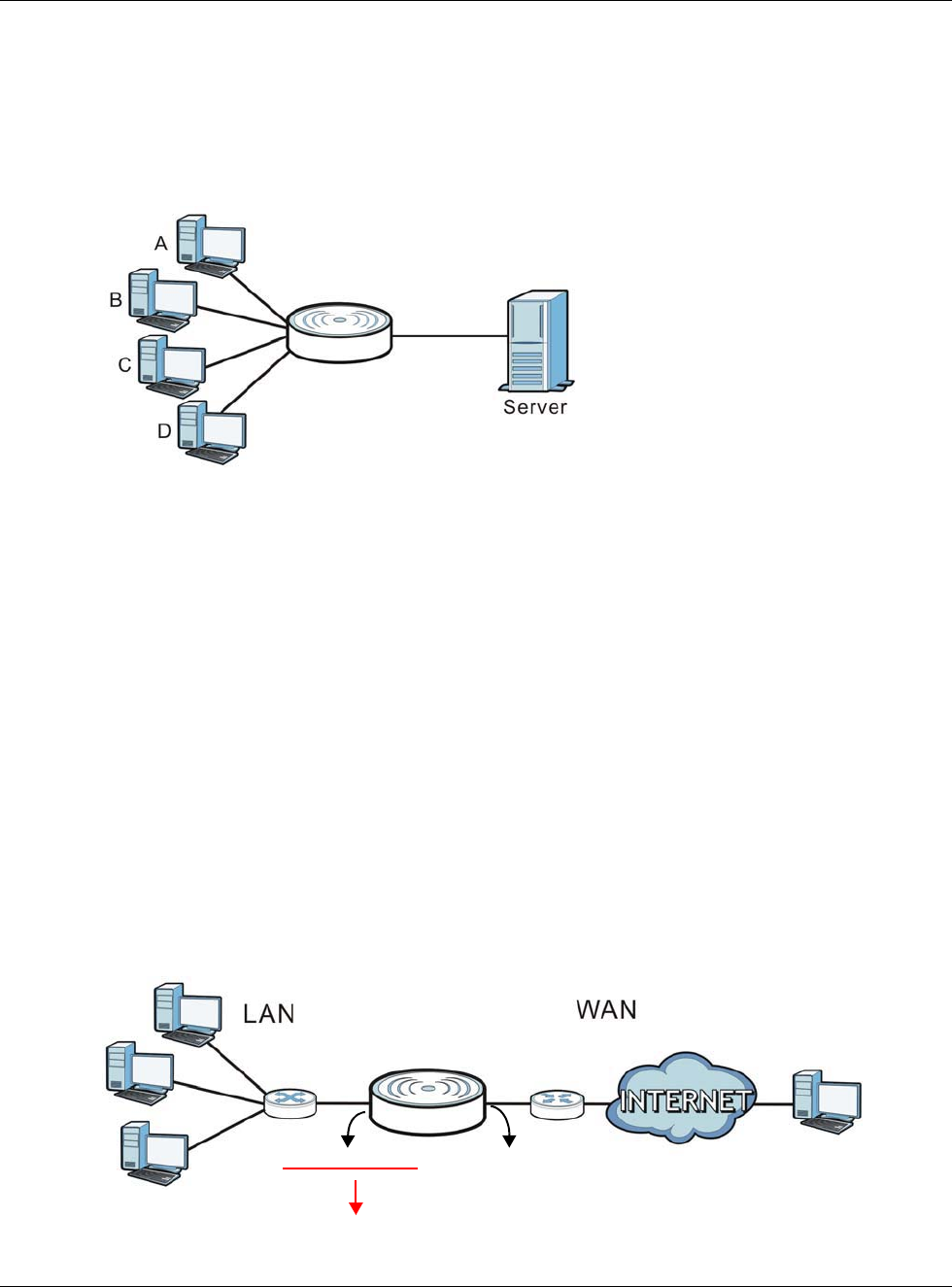
Chapter 10 WAN
NBG6617 User’s Guide
64
Multicast
Traditionally, IP packets are transmitted in one of either two ways - Unicast (1 sender - 1 recipient)
or Broadcast (1 sender - everybody on the network). Multicast delivers IP packets to a group of
hosts on the network - not everybody and not just 1.
Figure 40 Multicast Example
In the multicast example above, systems A and D comprise one multicast group. In multicasting,
the server only needs to send one data stream and this is delivered to systems A and D.
IGMP (Internet Group Multicast Protocol) is a network-layer protocol used to establish membership
in a multicast group - it is not used to carry user data. The NBG6617 supports both IGMP version 1
(IGMP-v1) and IGMP version 2 (IGMP-v2).
At start up, the NBG6617 queries all directly connected networks to gather group membership.
After that, the NBG6617 periodically updates this information. IP multicasting can be enabled/
disabled on the NBG6617 WAN interface in the Web Configurator (WAN). Select None to disable IP
multicasting on these interfaces.
Auto-IP Change
When the NBG6617 gets a WAN IP address or a DNS server IP address which is in the same subnet
as the LAN IP address 192.168.1.1, Auto-IP-Change allows the NBG6617 to change its LAN IP
address to 10.0.0.1 automatically. If the NBG6617’s original LAN IP address is 10.0.0.1 and the
WAN IP address is in the same subnet, such as 10.0.0.3, the NBG6617 switches to use 192.168.1.1
as its LAN IP address.
Figure 41 Auto-IP-Change Example
192.168.1.1 192.168.1.23
10.0.0.1

Chapter 10 WAN
NBG6617 User’s Guide
65
Auto-IP-Change only works under the following conditions:
• The NBG6617 must be in Router Mode (see Section 15.12 on page 146 for more information)
for Auto-IP-Change to become active.
• The NBG6617 is set to receive a dynamic WAN IP address.
10.4 Internet Connection Screen
Use this screen to change your NBG6617’s Internet access settings. Click Expert Mode > WAN >
Internet Connection.
10.4.1 IPoE Encapsulation
This screen displays when you select IPoE encapsulation.
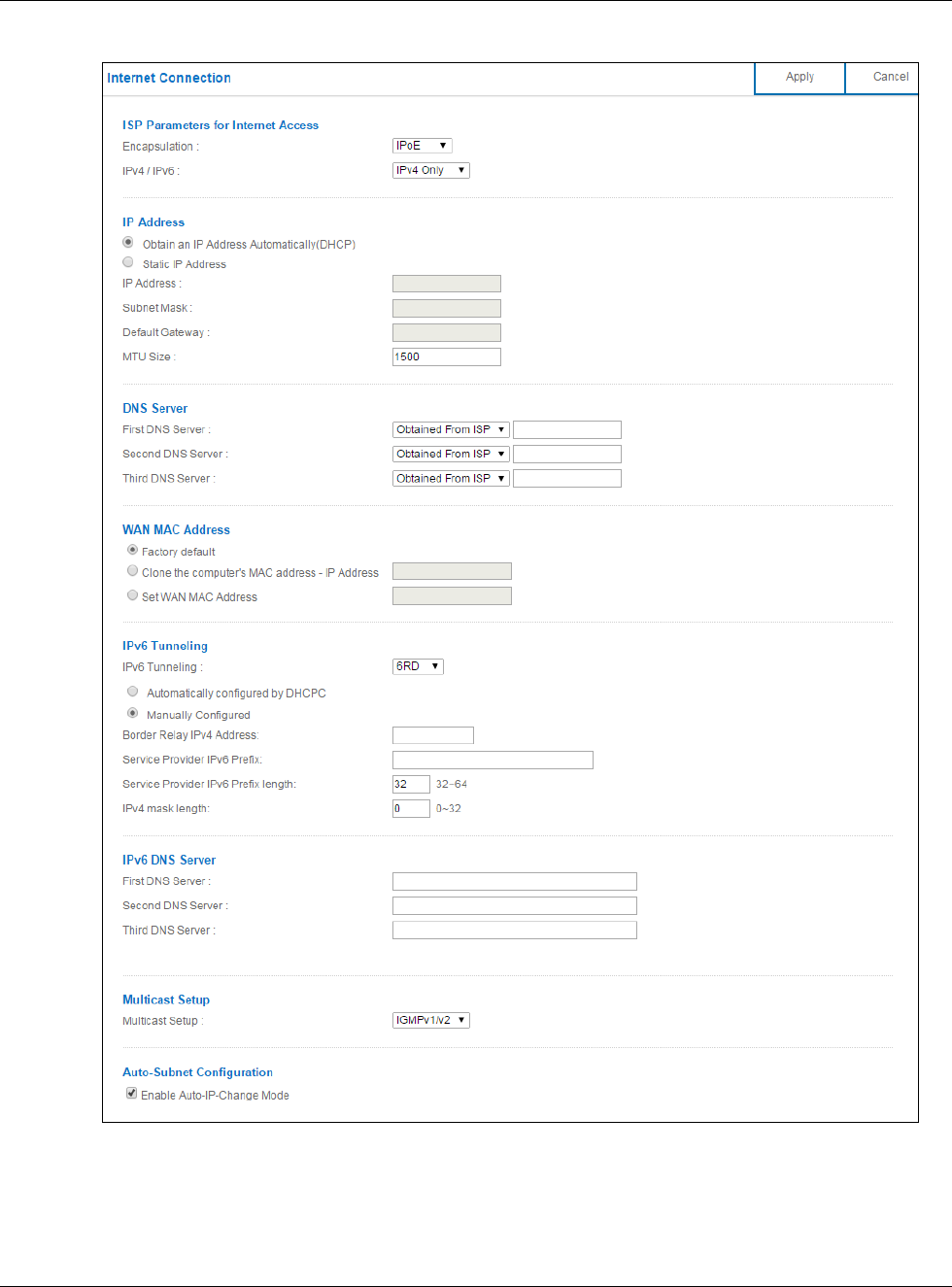
Chapter 10 WAN
NBG6617 User’s Guide
66
Figure 42 Expert Mode > WAN > Internet Connection: IPoE Encapsulation (IPv4 Only)

Chapter 10 WAN
NBG6617 User’s Guide
67
The following table describes the labels in this screen.
Table 20 Network > WAN > Internet Connection: IPoE Encapsulation
LABEL DESCRIPTION
ISP Parameters for Internet Access
Encapsulation You must choose the IPoE option when the WAN port is used as a regular Ethernet.
IPv4 / IPv6 Select IPv4 Only if you want the NBG6617 to run IPv4 only.
Select Dual Stack to allow the NBG6617 to run IPv4 and IPv6 at the same time.
Select IPv6 Only if you want the NBG6617 to run IPv6 only.
IP Address
Obtain an IP
Address
Automatically
(DHCP)
Select this option if your ISP did not assign you a fixed IP address. This is the default
selection.
Static IP Address Select this option if the ISP assigned a fixed IP address.
IP Address Enter your WAN IP address in this field if you selected Static IP Address.
Subnet Mask Enter the Subnet Mask in this field.
Default Gateway Enter a gateway IP address (if your ISP gave you one) in this field.
MTU Size Enter the MTU (Maximum Transmission Unit) size for each packet. If a larger packet
arrives, the NBG6617 divides it into smaller fragments.
DNS Server
First DNS Server
Second DNS Server
Third DNS Server
Select Obtained From ISP if your ISP dynamically assigns DNS server information
(and the NBG6617's WAN IP address). The field to the right displays the (read-only)
DNS server IP address that the ISP assigns.
Select User-Defined if you have the IP address of a DNS server. Enter the DNS
server's IP address in the field to the right.
Select None if you do not want to configure DNS servers. If you do not configure a DNS
server, you must know the IP address of a computer in order to access it.
WAN MAC Address
Once the WAN MAC address is successfully configured, the address will be copied to the configuration file. It
will not change unless you change the setting or upload a different configuration file.
Factory default Select this option to have the WAN interface use the factory assigned default MAC
address. By default, the NBG6617 uses the factory assigned MAC address to identify
itself.
Clone the
computer's MAC
address - IP
Address
Select this option to have the WAN interface use a different MAC address by cloning the
MAC address of another device or computer. Enter the IP address of the device or
computer whose MAC you are cloning.
Set WAN MAC
Address
Select this option to have the WAN interface use a manually specified MAC address.
Enter the MAC address in the fields.
IPv6 Tunneling
Use IPv6 tunneling when the local network uses IPv6 and the ISP has an IPv4 network. When the NBG6617
has an IPv4 WAN address and you set IPv4/IPv6 mode to IPv4 Only, you can enable IPv6 tunneling to
encapsulate IPv6 packets in IPv4 packets to cross the ISP’s IPv4 network.

Chapter 10 WAN
NBG6617 User’s Guide
68
IPv6 Tunneling Select None to not allow IPv6 packets to cross IPv4 networks.
Select 6RD to enable 6RD. IPv6 Rapid Deployment (6RD) is an IPv6 transitioning
process for stateless tunneling of IPv6 over IPv4. Enable 6RD to allow tunneling across
an ISP's IPv4 only access network.
Select 6to4 to transmit IPv6 packets over an IPv4 network. A 6to4 relay router is
required to route 6to4 packets to a native IPv6 network.
Select 6in4 if the NBG6617 has a public IPv4 address and you want to transmit your
IPv6 packets to one and only one remote site whose LAN network is also an IPv6
network. You must know the WAN IP address of the remote gateway.
6RD
The NBG6617 generates a global IPv6 prefix from its IPv4 WAN address and tunnels IPv6 traffic to the ISP’s
Border Relay router to connect to the native IPv6 Internet. The local network can also use IPv4 services. The
NBG6617 uses its configured IPv4 WAN IP to route IPv4 traffic to the IPv4 Internet.
This is available only when you select IPv4 Only in the IPv4/IPv6 field.
Automatically
configured by
DHCPC
Select this to have the NBG6617 detect the relay server’s IP address automatically
through DHCP.
Manually Configured Select this if you have the IPv4 address of the relay server.
Border Relay IPv4
Address
Specify the relay server’s IPv4 address.
Service Provider
IPv6 Prefix
Enter an IPv6 prefix for tunneling IPv6 traffic to the ISP’s Border Relay router and
connecting to the native IPv6 Internet.
Service Provider
IPv6 Prefix length
Enter the IPv6 prefix length.
An IPv6 prefix length specifies how many most significant bits (starting from the left) in
the address compose the network address.
IPv4 mask length Enter the subnet mask number (1~32) for the IPv4 network.
6to4
The NBG6617 should get a public IPv4 address for the WAN. The NBG6617 adds an IPv4 IP header to an IPv6
packet when transmitting the packet to the Internet. In reverse, the NBG6617 removes the IPv4 header from
an IPv6 packet when receiving it from the Internet.
This is available only when you select IPv4 Only in the IPv4/IPv6 field.
Relay Server IPv4
Address
Enter the IPv4 address of a 6to4 relay server which helps forward packets between
6to4 networks and native IPv6 networks.
6in4
The NBG6617 encapsulates IPv6 packets within IPv4 packets across the Internet. You must know the WAN IP
address of the remote gateway device. This mode is normally used for a site-to-site application such as two
branch offices.
This is available only when you select IPv4 Only in the IPv4/IPv6 field.
Remote IPv4
Address
Enter the IPv4 address of the remote gateway to which this interface tunnels traffic.
Remote IPv6
Address
Enter the IPv6 address of the remote gateway to which this interface tunnels traffic.
Local IPv6 Address Enter the IPv6 address assigned by your ISP.
IPv6 Prefix Enter the IPv6 prefix for this interface if you want to use a static IP address.
Table 20 Network > WAN > Internet Connection: IPoE Encapsulation (continued)
LABEL DESCRIPTION

Chapter 10 WAN
NBG6617 User’s Guide
69
IPv6 DNS Server
This is available only when you select IPv4 Only in the IPv4/IPv6 field and set IPv6 Tunneling to 6RD,
6in4 or 6to4.
First DNS Server
Second DNS Server
Third DNS Server
Specify the DNS server IPv6 address assigned by the ISP.
IPv6 Address
This section is NOT available when you select IPv4 Only in the IPv4/IPv6 field.
Obtain an IP
Address
Automatically(DHCP
)
Select this option if you want to obtain an IPv6 address from a DHCPv6 server.
•Select DUID-LL (Default) to have the NBG6617 use DUID-LL (DUID Based on
Link-layer Address) for identification when exchanging DHCPv6 messages.
•Select DUID-LLT to have the NBG6617 use DUID-LLT (DUID Based on Link-layer
Address Plus Time) for identification when exchanging DHCPv6 messages.
Static IP Address Select this option if you have a fixed IPv6 address assigned by your ISP.
IPv6 Address Enter the IPv6 address assigned by your ISP.
Prefix length Enter the address prefix length to specify how many most significant bits in an IPv6
address compose the network address.
IPv6 Default
Gateway Enter the IPv6 address of the next-hop gateway. The gateway helps forward packets to
their destinations.
Link Local Only Select this option to use the link-local address which uniquely identifies a device on the
local network (the LAN).
IPv6 DNS Server
This is available only when you select Dual Stack or IPv6 Only in the IPv4/IPv6 field.
First DNS Server
Second DNS Server
Third DNS Server
Select Obtained From ISP to have the NBG6617 get the IPv6 DNS server addresses
from the ISP automatically.
Select User-Defined and enter the IPv6 DNS server address assigned by the ISP to
have the NBG6617 use the IPv6 DNS server addresses you configure manually.
Select None if you do not want to configure DNS servers. If you do not configure a DNS
server, you must know the IPv6 address of a computer in order to access it.
Multicast Setup
Multicast Setup Select IGMPv1/v2 to enable multicasting. This applies to traffic routed from the WAN
to the LAN.
Select None to disable this feature. This may cause incoming traffic to be dropped or
sent to all connected network devices.
Auto-Subnet Configuration
Enable Auto-IP-
Change Mode
Select this option to have the NBG6617 change its LAN IP address to 10.0.0.1 or
192.168.1.1 accordingly when the NBG6617 gets a dynamic WAN IP address in the
same subnet as the LAN IP address.
Select this option to have the NBG6617 change its LAN IP address to 10.0.0.1 or
192.168.1.1 accordingly when the NBG6617 gets a DNS server IP address in the same
subnet as the LAN IP address.
The NAT, DHCP server and firewall functions on the NBG6617 are still available in this
mode.
Apply Click Apply to save your changes back to the NBG6617.
Cancel Click Cancel to begin configuring this screen afresh.
Table 20 Network > WAN > Internet Connection: IPoE Encapsulation (continued)
LABEL DESCRIPTION

Chapter 10 WAN
NBG6617 User’s Guide
70
10.4.2 PPPoE Encapsulation
The NBG6617 supports PPPoE (Point-to-Point Protocol over Ethernet). PPPoE is an IETF standard
(RFC 2516) specifying how a personal computer (PC) interacts with a broadband modem (DSL,
cable, wireless, etc.) connection. The PPP over Ethernet option is for a dial-up connection using
PPPoE.
For the service provider, PPPoE offers an access and authentication method that works with existing
access control systems (for example Radius).
One of the benefits of PPPoE is the ability to let you access one of multiple network services, a
function known as dynamic service selection. This enables the service provider to easily create and
offer new IP services for individuals.
Operationally, PPPoE saves significant effort for both you and the ISP or carrier, as it requires no
specific configuration of the broadband modem at the customer site.
By implementing PPPoE directly on the NBG6617 (rather than individual computers), the computers
on the LAN do not need PPPoE software installed, since the NBG6617 does that part of the task.
Furthermore, with NAT, all of the LANs’ computers will have access.
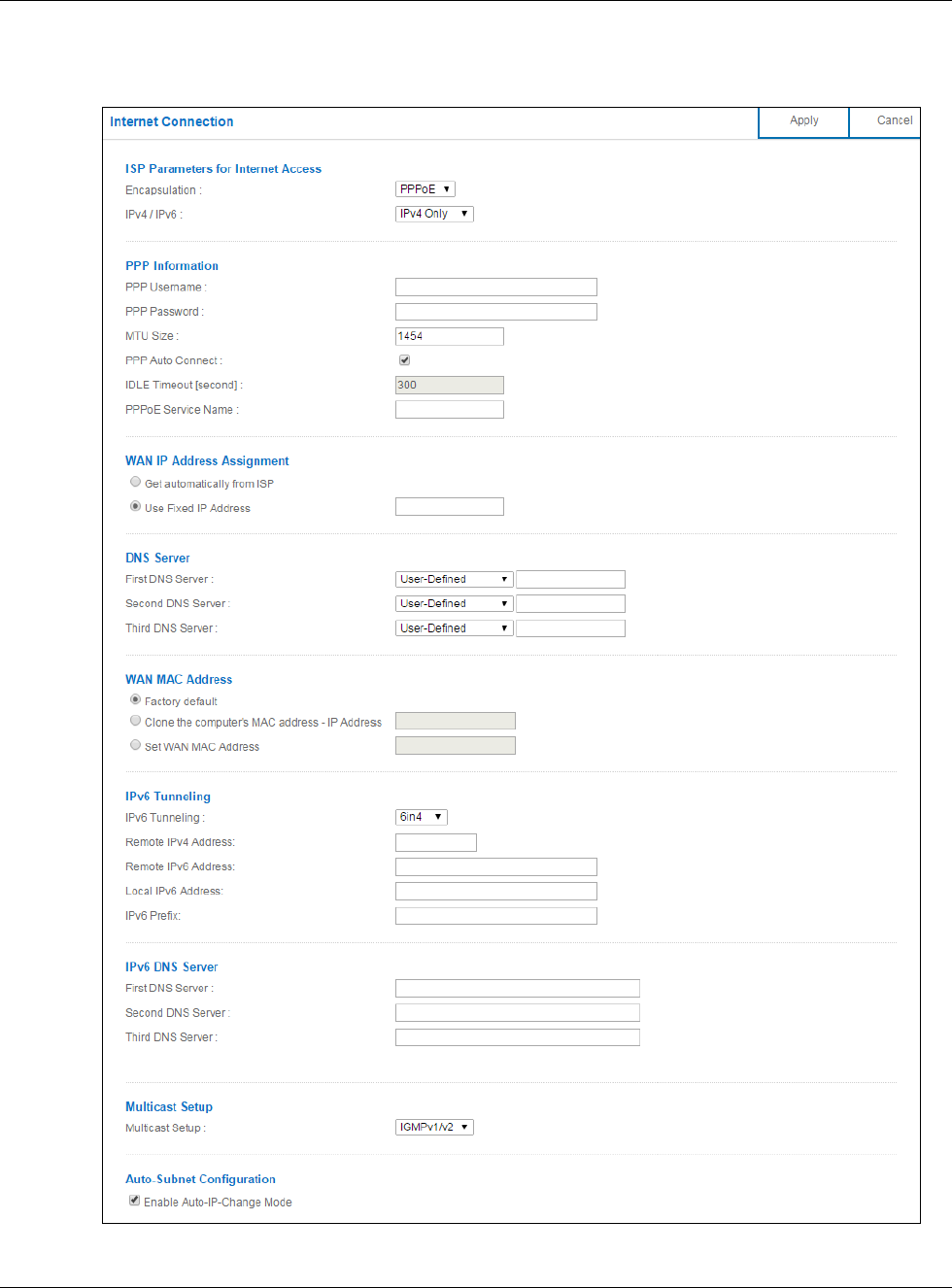
Chapter 10 WAN
NBG6617 User’s Guide
71
This screen displays when you select PPPoE encapsulation.
Figure 43 Network > WAN > Internet Connection: PPPoE Encapsulation (IPv4 Only)

Chapter 10 WAN
NBG6617 User’s Guide
72
The following table describes the labels in this screen.
Table 21 Network > WAN > Internet Connection: PPPoE Encapsulation
LABEL DESCRIPTION
ISP Parameters for Internet Access
Encapsulation Select PPPoE if you connect to your Internet via dial-up.
IPv4 / IPv6 Select IPv4 Only if you want the NBG6617 to run IPv4 only.
Select Dual Stack to allow the NBG6617 to run IPv4 and IPv6 at the same time.
Select IPv6 Only if you want the NBG6617 to run IPv6 only.
PPP Information
PPP Username Type the user name given to you by your ISP.
PPP Password Type the password associated with the user name above.
MTU Size Enter the Maximum Transmission Unit (MTU) or the largest packet size per frame that
your NBG6617 can receive and process.
PPP Auto Connect Select this option if you do not want the connection to time out.
IDLE Timeout
(second)
This value specifies the time in minutes that elapses before the router automatically
disconnects from the PPPoE server.
PPPoE Service
Name
Enter the PPPoE service name specified in the ISP account.
WAN IP Address Assignment
Get automatically
from ISP
Select this option if your ISP did not assign you a fixed IP address. This is the default
selection.
Use Fixed IP
Address
Select this option and enter your WAN IP address if the ISP assigned a fixed IP address.
DNS Server
First DNS Server
Second DNS
Server
Third DNS Server
Select Obtained From ISP if your ISP dynamically assigns DNS server information (and
the NBG6617's WAN IP address). The field to the right displays the (read-only) DNS
server IP address that the ISP assigns.
Select User-Defined if you have the IP address of a DNS server. Enter the DNS server's
IP address in the field to the right.
Select None if you do not want to configure DNS servers. If you do not configure a DNS
server, you must know the IP address of a computer in order to access it.
WAN MAC Address
The MAC address section allows users to configure the WAN port's MAC address by using the NBG6617’s MAC
address, copying the MAC address from a computer on your LAN or manually entering a MAC address.
Factory default Select Factory default to use the factory assigned default MAC Address.
Clone the
computer’s MAC
address - IP
Address
Select Clone the computer's MAC address - IP Address and enter the IP address of
the computer on the LAN whose MAC you are cloning.
Set WAN MAC
Address
Select this option and enter the MAC address you want to use.
IPv6 Tunneling
Use IPv6 tunneling when the local network uses IPv6 and the ISP has an IPv4 network. When the NBG6617
has an IPv4 WAN address and you set IPv4/IPv6 mode to IPv4 Only, you can enable IPv6 tunneling to
encapsulate IPv6 packets in IPv4 packets to cross the ISP’s IPv4 network.

Chapter 10 WAN
NBG6617 User’s Guide
73
IPv6 Tunneling Select None to not allow IPv6 packets to cross IPv4 networks.
Select 6RD to enable 6RD. IPv6 Rapid Deployment (6RD) is an IPv6 transitioning
process for stateless tunneling of IPv6 over IPv4. Enable 6RD to allow tunneling across
an ISP's IPv4 only access network.
Select 6to4 to transmit IPv6 packets over an IPv4 network. A 6to4 relay router is
required to route 6to4 packets to a native IPv6 network.
Select 6in4 if the NBG6617 has a public IPv4 address and you want to transmit your
IPv6 packets to one and only one remote site whose LAN network is also an IPv6
network. You must know the WAN IP address of the remote gateway.
6RD
The NBG6617 generates a global IPv6 prefix from its IPv4 WAN address and tunnels IPv6 traffic to the ISP’s
Border Relay router to connect to the native IPv6 Internet. The local network can also use IPv4 services. The
NBG6617 uses its configured IPv4 WAN IP to route IPv4 traffic to the IPv4 Internet.
This is available only when you select IPv4 Only in the IPv4/IPv6 field.
Automatically
configured by
DHCPC
Select this to have the NBG6617 detect the relay server’s IP address automatically
through DHCP.
Manually
Configured
Select this if you have the IPv4 address of the relay server.
Border Relay IPv4
Address
Specify the relay server’s IPv4 address.
Service Provider
IPv6 Prefix
Enter an IPv6 prefix for tunneling IPv6 traffic to the ISP’s Border Relay router and
connecting to the native IPv6 Internet.
Service Provider
IPv6 Prefix length
Enter the IPv6 prefix length.
An IPv6 prefix length specifies how many most significant bits (starting from the left) in
the address compose the network address.
IPv4 mask length Enter the subnet mask number (1~32) for the IPv4 network.
6to4
The NBG6617 should get a public IPv4 address for the WAN. The NBG6617 adds an IPv4 IP header to an IPv6
packet when transmitting the packet to the Internet. In reverse, the NBG6617 removes the IPv4 header from
an IPv6 packet when receiving it from the Internet.
This is available only when you select IPv4 Only in the IPv4/IPv6 field.
Relay Server IPv4
Address
Enter the IPv4 address of a 6to4 relay server which helps forward packets between 6to4
networks and native IPv6 networks.
6in4
The NBG6617 encapsulates IPv6 packets within IPv4 packets across the Internet. You must know the WAN IP
address of the remote gateway device. This mode is normally used for a site-to-site application such as two
branch offices.
This is available only when you select IPv4 Only in the IPv4/IPv6 field.
Remote IPv4
Address
Enter the IPv4 address of the remote gateway to which this interface tunnels traffic.
Remote IPv6
Address
Enter the IPv6 address of the remote gateway to which this interface tunnels traffic.
Local IPv6 Address Enter the IPv6 address assigned by your ISP.
IPv6 Prefix Enter the IPv6 prefix for this interface if you want to use a static IP address.
Table 21 Network > WAN > Internet Connection: PPPoE Encapsulation (continued)
LABEL DESCRIPTION

Chapter 10 WAN
NBG6617 User’s Guide
74
10.5 NAT
Use this screen to change your NBG6617’s NAT (Network Address Translation) settings. Click
Expert Mode > WAN > NAT.
10.5.1 General Screen
Use this screen to enable NAT, set a default server and configure your NBG6617’s port forwarding
settings to forward incoming service requests to the server(s) on your local network. Click Expert
Mode > WAN > NAT > General.
IPv6 DNS Server
This is available only when you select IPv4 Only in the IPv4/IPv6 field and set IPv6 Tunneling to 6RD,
6in4 or 6to4.
First DNS Server
Second DNS
Server
Third DNS Server
Specify the DNS server IPv6 address assigned by the ISP.
IPv6 DNS Server
This is available only when you select Dual Stack or IPv6 Only in the IPv4/IPv6 field.
First DNS Server
Second DNS
Server
Third DNS Server
Select Obtained From ISP to have the NBG6617 get the IPv6 DNS server addresses
from the ISP automatically.
Select User-Defined and enter the IPv6 DNS server address assigned by the ISP to
have the NBG6617 use the IPv6 DNS server addresses you configure manually.
Select None if you do not want to configure DNS servers. If you do not configure a DNS
server, you must know the IPv6 address of a computer in order to access it.
Multicast Setup
Multicast Setup Select IGMPv1/v2 to enable multicasting. This applies to traffic routed from the WAN to
the LAN.
Select None to disable this feature. This may cause incoming traffic to be dropped or
sent to all connected network devices.
Auto-Subnet Configuration
Enable Auto-IP-
Change Mode
Select this option to have the NBG6617 change its LAN IP address to 10.0.0.1 or
192.168.1.1 accordingly when the NBG6617 gets a dynamic WAN IP address in the same
subnet as the LAN IP address.
Select this option to have the NBG6617 change its LAN IP address to 10.0.0.1 or
192.168.1.1 accordingly when the NBG6617 gets a DNS server IP address in the same
subnet as the LAN IP address.
The NAT, DHCP server and firewall functions on the NBG6617 are still available in this
mode.
Apply Click Apply to save your changes back to the NBG6617.
Cancel Click Cancel to begin configuring this screen afresh.
Table 21 Network > WAN > Internet Connection: PPPoE Encapsulation (continued)
LABEL DESCRIPTION
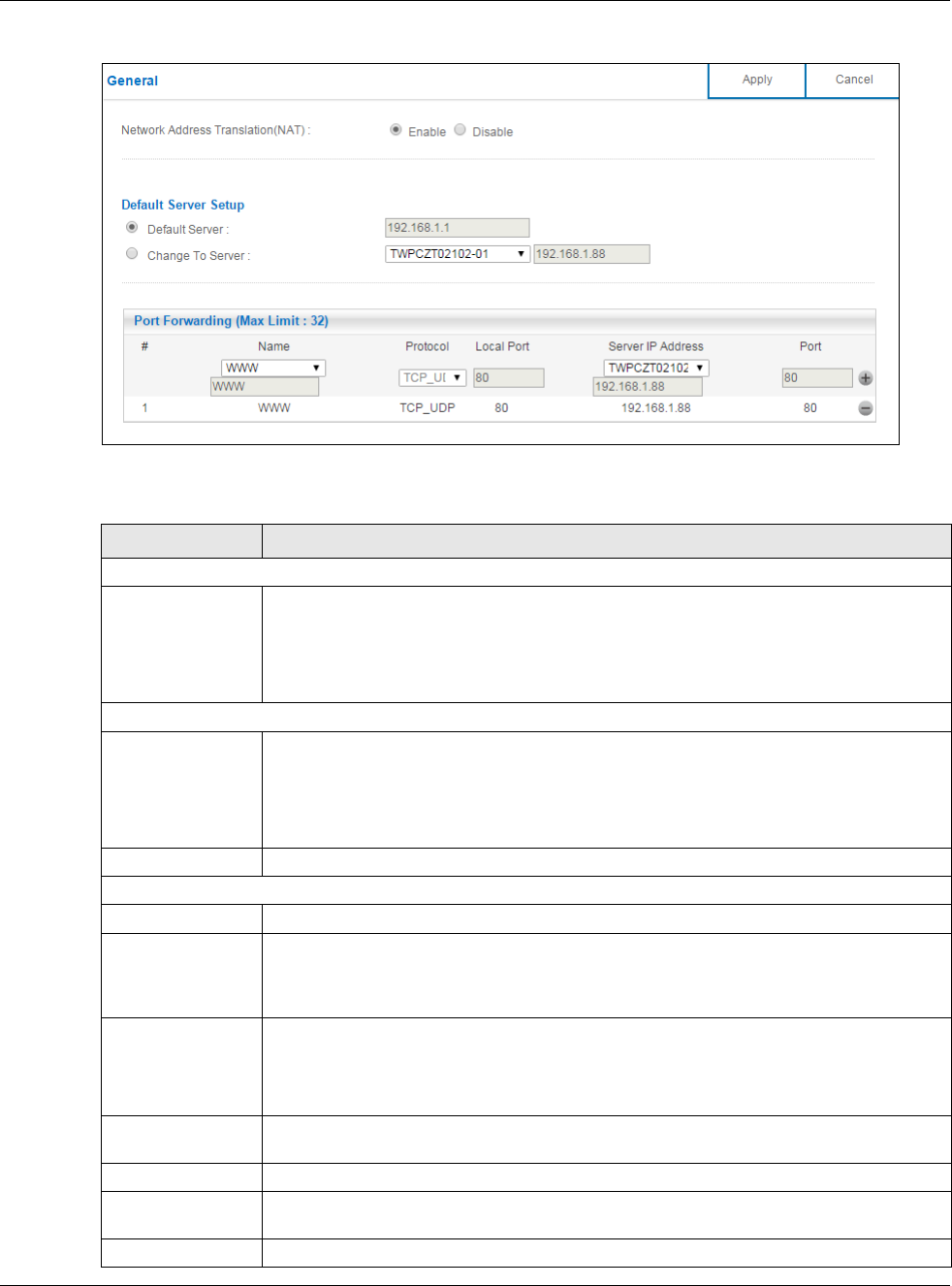
Chapter 10 WAN
NBG6617 User’s Guide
75
Figure 44 Expert Mode > WAN >NAT > General
The following table describes the labels in this screen.
Table 22 Expert Mode > WAN > NAT > General
LABEL DESCRIPTION
General
Network Address
Translation (NAT)
Network Address Translation (NAT) allows the translation of an Internet protocol address
used within one network (for example a private IP address used in a local network) to a
different IP address known within another network (for example a public IP address used
on the Internet).
Select Enable to activate NAT. Select Disable to turn it off.
Default Server Setup
Default Server You can decide whether you want to use the default server or specify a server manually.
In addition to the servers for specified services, NAT supports a default server. A default
server receives packets from ports that are not specified in the port forwarding summary
table below.
Select this to use the default server.
Change To Server Select this and manually enter the server’s IP address.
Port Forwarding (Max Limit : 32)
#This is the number of an individual port forwarding server entry.
Name Select a pre-defined service from the drop-down list box. The pre-defined service port
number(s) and protocol will be displayed in the port forwarding summary table.
Otherwise, select User define to manually enter the Port number(s) and select the
Protocol.
Protocol Select the transport layer protocol supported by this virtual server. Choices are TCP,
UDP, or TCP_UDP.
If you have chosen a pre-defined service in the Name field, the protocol will be
configured automatically.
Local Port This shows the port number(s) that identifies the service if you select a pre-defined
service. If you select User define in the Name field, enter the port number(s) manually.
Server IP Address Select User define to manually enter the inside IP address of the virtual server here.
Port This shows the port number(s) that identifies the service if you select a pre-defined
service. If you select User define in the Name field, enter the port number(s) manually.
Name This field displays a name to identify this rule.
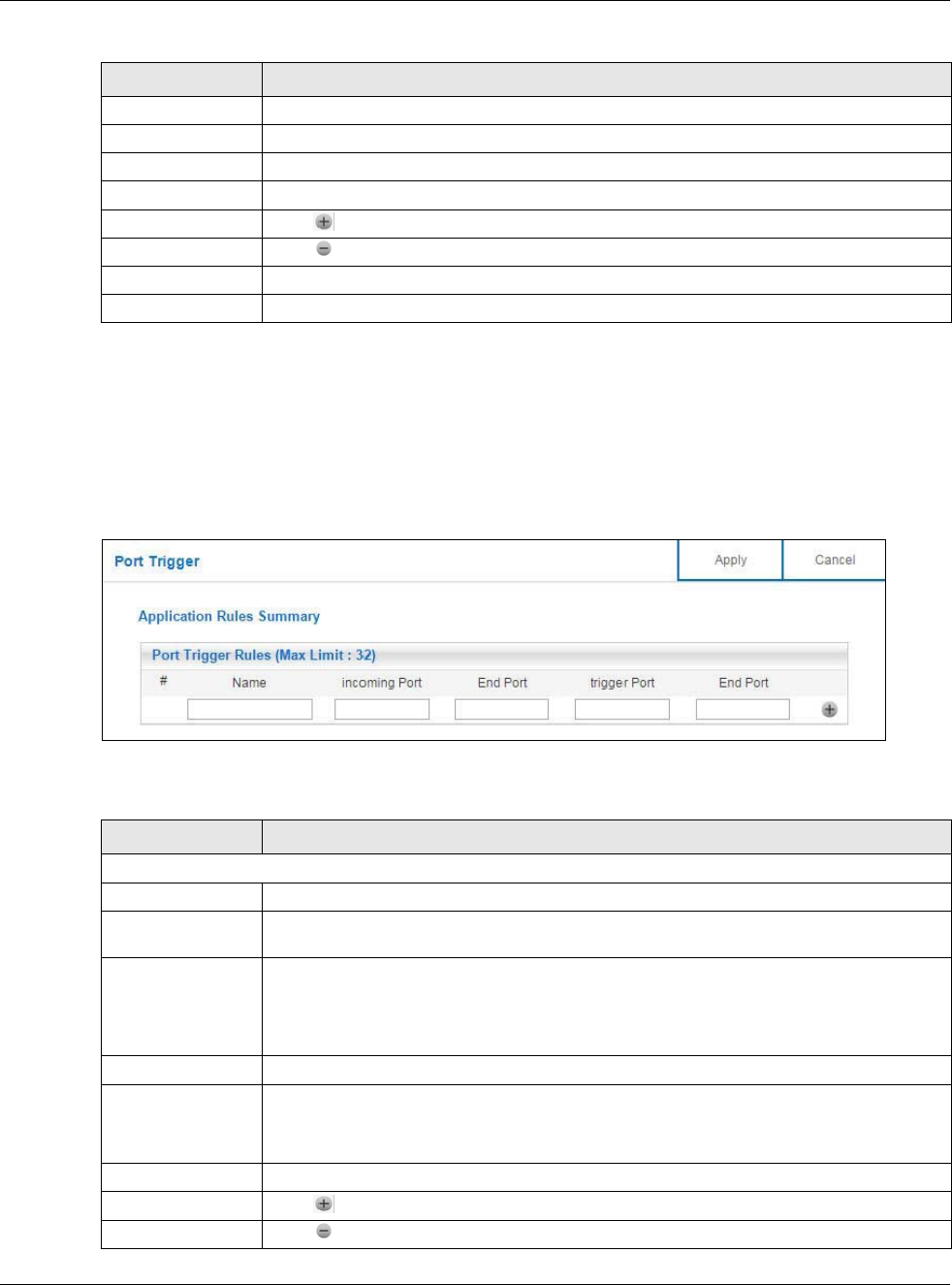
Chapter 10 WAN
NBG6617 User’s Guide
76
10.5.2 Port Trigger Screen
To change your NBG6617’s trigger port settings, click Expert Mode > WAN > NAT > Port
Trigger. The screen appears as shown.
Note: Only one LAN computer can use a trigger port (range) at a time.
Figure 45 Expert Mode > WAN > NAT > Port Trigger
The following table describes the labels in this screen.
Protocol This is the transport layer protocol used for the service.
Local Port This field displays the port number(s).
Server IP Address This field displays the inside IP address of the server.
Port This field displays the port number(s).
Add Click to add the rule in the port forwarding summary table.
Delete Click to remove a rule.
Apply Click Apply to save your changes back to the NBG6617.
Cancel Click Cancel to begin configuring this screen afresh.
Table 22 Expert Mode > WAN > NAT > General (continued)
LABEL DESCRIPTION
Table 23 Expert Mode > WAN > NAT > Port Trigger
LABEL DESCRIPTION
Port Trigger Rules (Max Limit : 32)
#This is the rule index number (read-only).
Name Type a unique name (up to 15 characters) for identification purposes. All characters are
permitted - including spaces.
Incoming Port Incoming is a port (or a range of ports) that a server on the WAN uses when it sends out
a particular service. The NBG6617 forwards the traffic with this port (or range of ports)
to the client computer on the LAN that requested the service.
Type a port number or the starting port number in a range of port numbers.
End Port Type a port number or the ending port number in a range of port numbers.
Trigger Port The trigger port is a port (or a range of ports) that causes (or triggers) the NBG6617 to
record the IP address of the LAN computer that sent the traffic to a server on the WAN.
Type a port number or the starting port number in a range of port numbers.
End Port Type a port number or the ending port number in a range of port numbers.
Add Click to add the rule in the port trigger summary table.
Delete Click to remove a rule.
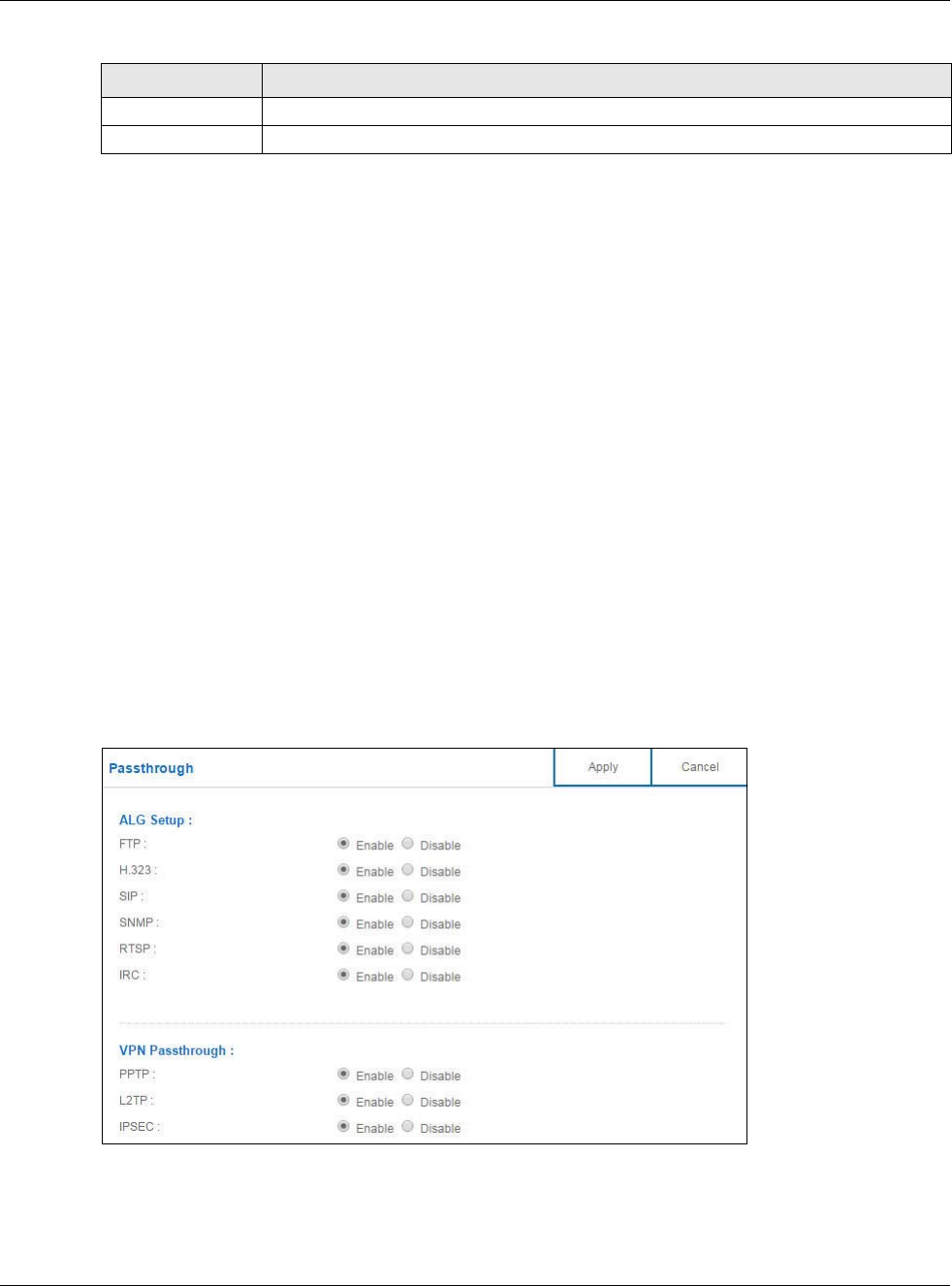
Chapter 10 WAN
NBG6617 User’s Guide
77
10.5.3 Passthrough Screen
ALG Overview
Application Layer Gateway (ALG) allows the following applications to operate properly through the
NBG6617’s NAT.
• SIP - Session Initiation Protocol (SIP) - An application-layer protocol that can be used to create
voice and multimedia sessions over Internet.
• H.323 - A teleconferencing protocol suite that provides audio, data and video conferencing.
• FTP - File Transfer Protocol - an Internet file transfer service.
• SNMP - Simple Network Management Protocol - An application-layer protocol that can be used to
exchange management information between network devices.
• RTSP - Real Time Streaming Protocol - a remote control for multimedia on the Internet.
• IRC - Internet Relay Chat - An application-layer protocol that can be used to communicate in the
form of text.
The ALG feature is only needed for traffic that goes through the NBG6617’s NAT.
To change your NBG6617’s ALGs and VPN pass-through settings, click Expert Mode > WAN >
NAT > Passthrough. The screen appears as shown.
Figure 46 Expert Mode > WAN > NAT > Passthrough
Apply Click Apply to save your changes back to the NBG6617.
Cancel Click Cancel to begin configuring this screen afresh.
Table 23 Expert Mode > WAN > NAT > Port Trigger (continued)
LABEL DESCRIPTION

Chapter 10 WAN
NBG6617 User’s Guide
78
The following table describes the labels in this screen.
10.6 Dynamic DNS Screen
To change your NBG6617’s DDNS, click Expert Mode > WAN > Dynamic DNS. The screen
appears as shown.
Table 24 Expert Mode > WAN > NAT > Passthrough
LABEL DESCRIPTION
ALG Setup
FTP Select Enable to allow TCP packets with a specified port destination to pass through.
H.323 Select Enable to allow peer-to-peer H.323 calls.
SIP Select Enable to make sure SIP (VoIP) works correctly with port-forwarding and
address-mapping rules.
SNMP Select Enable to allow a manager station to manage and monitor the NBG6617 through
the network via SNMP.
RTSP RTSP (Real Time Streaming Protocol) is a protocol used to stop, pause or play video and
audio applications streaming on the Internet.
Select Enable to have the NBG6617 detect RTSP traffic and help build RTSP sessions
through its NAT.
IRC Select Enable to allow clients to communicate in the form of text.
VPN Passthrough
PPTP Select Enable to allow VPN clients to make outbound PPTP connections. It is required in
order to connect to a PPTP VPN account. If PPTP is disabled, then when a client sends a
request to a VPN server, the server will reply to the NBG6617 and the NBG6617 will drop
the request. When PPTP is enabled, the NBG6617 will forward the reply from the VPN
server to the client that initiated the request, and the connection will establish
successfully.
L2TP Select Enable to allow VPN clients to make outbound L2TP connections. It is required in
order to connect to a L2TP VPN account. If L2TP is disabled, then when a client sends a
request to a VPN server, the server will reply to the NBG6617 and the NBG6617 will drop
the request. When L2TP is enabled, the NBG6617 will forward the reply from the VPN
server to the client that initiated the request, and the connection will establish
successfully.
IPSEC Select Enable to allow VPN clients to make outbound IPSec connections. It is required in
order to connect to a IPSec VPN account. If IPSEC is disabled, then when a client sends
a request to a VPN server, the server will reply to the NBG6617 and the NBG6617 will
drop the request. When IPSEC is enabled, the NBG6617 will forward the reply from the
VPN server to the client that initiated the request, and the connection will establish
successfully.
Apply Click Apply to save your changes back to the NBG6617.
Cancel Click Cancel to begin configuring this screen afresh.
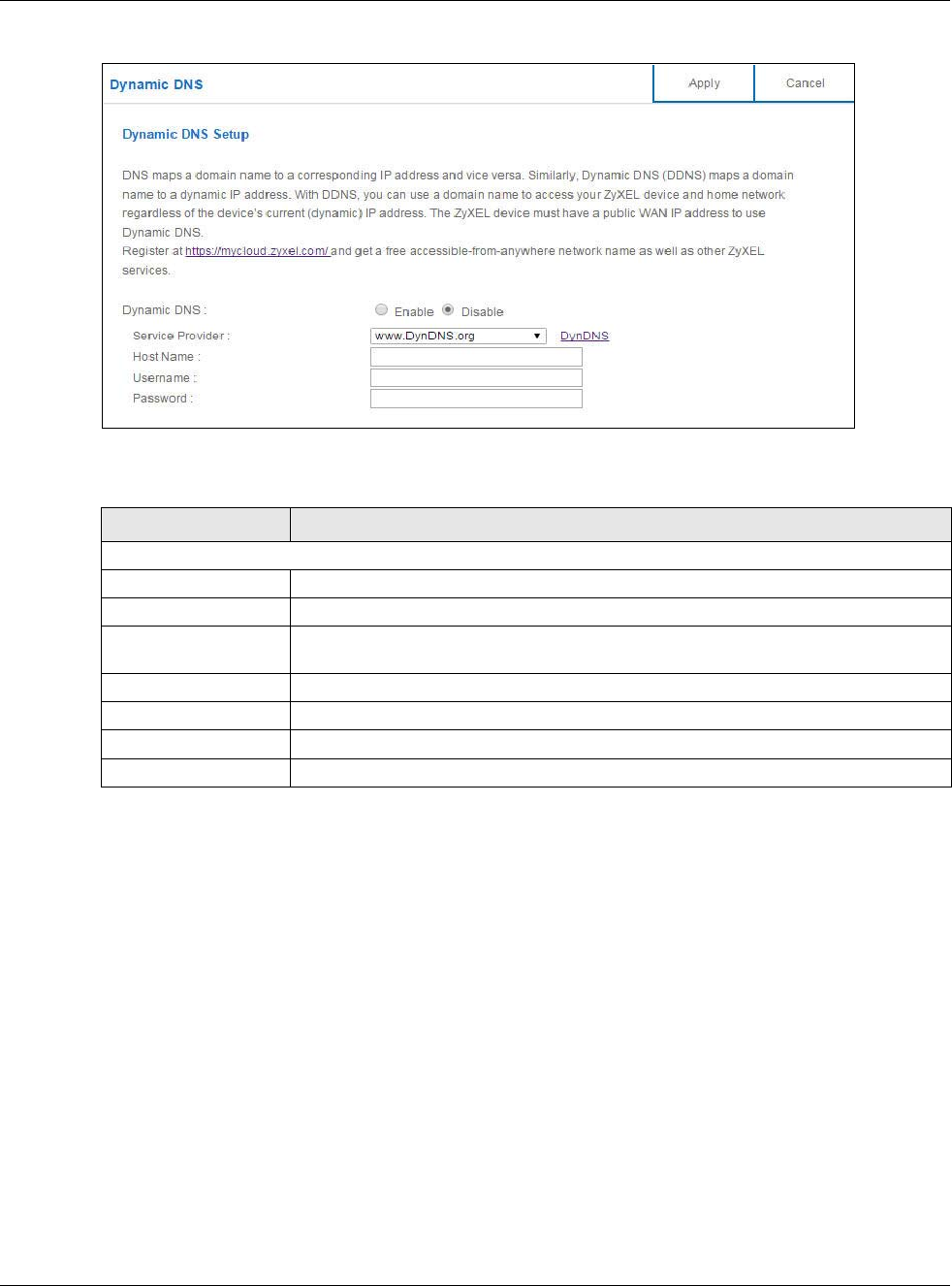
Chapter 10 WAN
NBG6617 User’s Guide
79
Figure 47 Expert Mode > WAN > Dynamic DNS
The following table describes the labels in this screen.
Table 25 Expert Mode > WAN > Dynamic DNS
LABEL DESCRIPTION
Dynamic DNS Setup
Dynamic DNS Select Enable to use dynamic DNS. Select Disable to turn this feature off.
Service Provider Select the name of your Dynamic DNS service provider.
Host Name Enter a host names in the field provided. You can specify up to two host names in the
field separated by a comma (",").
Username Enter your user name.
Password Enter the password assigned to you.
Apply Click Apply to save your changes back to the NBG6617.
Cancel Click Cancel to begin configuring this screen afresh.
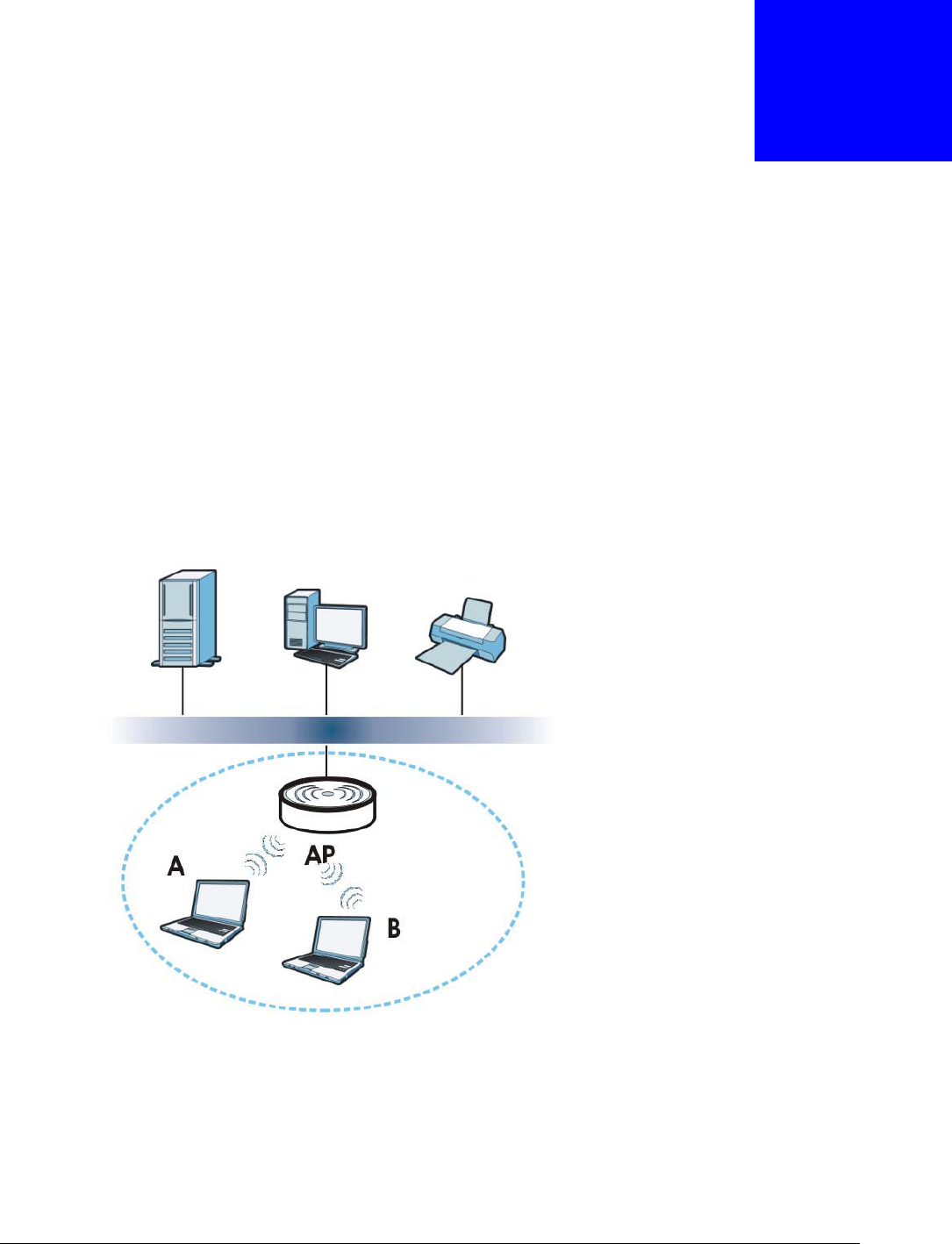
NBG6617 User’s Guide
80
CHAPTER 11
Wireless LAN
11.1 Overview
This chapter discusses how to configure the wireless network settings in your NBG6617. The
NBG6617 is able to function both 2.4GHz and 5GHz network at the same time. You can have
different wireless and wireless security settings for 2.4GHz and 5GHz wireless LANs. Click Expert
Mode > Wireless to configure wireless LAN 2.4G or wireless LAN 5G.
See the appendices for more detailed information about wireless networks.
The following figure provides an example of a wireless network.
Figure 48 Example of a Wireless Network
The wireless network is the part in the blue circle. In this wireless network, devices A and B are
called wireless clients. The wireless clients use the access point (AP) to interact with other devices
(such as the printer) or with the Internet. Your NBG6617 is the AP.

Chapter 11 Wireless LAN
NBG6617 User’s Guide
81
11.1.1 What You Can Do
•Use the Wireless screen to enable or disable the 2.4GHz or 5GHz wireless LAN, set up wireless
security between the NBG6617 and the wireless clients, and make other basic configuration
changes (Section 11.2 on page 85).
•U
se the Guest Wireless screen to set up multiple wireless networks on your NBG6617 (Section
11.4 on page 91).
•Use the MAC Filter screen to allow or deny wireless stations based on their MAC addresses from
connecting to the NBG6617 (Section 11.5 on page 93).
• Use the Advanced screen to allow intra-BSS networking and set the RTS/CTS Threshold (Section
11.6 on page 94).
•Use the WPS screen to quickly set up a wireless network with strong security, without having to
configure security settings manually (Section 11.7 on page 96).
•Use the Scheduling screen to set the times your wireless LAN is turned on and off (Section 11.8
on page 97).
11.1.2 What You Should Know
Every wireless network must follow these basic guidelines.
• Every wireless client in the same wireless network must use the same SSID.
The SSID is the name of the wireless network. It stands for Service Set IDentity.
• If two wireless networks overlap, they should use different channels.
Like radio stations or television channels, each wireless network uses a specific channel, or
frequency, to send and receive information.
• Every wireless client in the same wireless network must use security compatible with the AP.
Security stops unauthorized devices from using the wireless network. It can also protect the
information that is sent in the wireless network.
Wireless Security Overview
The following sections introduce different types of wireless security you can set up in the wireless
network.
SSID
Normally, the AP acts like a beacon and regularly broadcasts the SSID in the area. You can hide the
SSID instead, in which case the AP does not broadcast the SSID. In addition, you should change
the default SSID to something that is difficult to guess.
This type of security is fairly weak, however, because there are ways for unauthorized devices to
get the SSID. In addition, unauthorized devices can still see the information that is sent in the
wireless network.
MAC Address Filter
Every wireless client has a unique identification number, called a MAC address.1 A MAC address is
usually written using twelve hexadecimal characters2; for example, 00A0C5000002 or
00:A0:C5:00:00:02. To get the MAC address for each wireless client, see the appropriate User’s
Guide or other documentation.

Chapter 11 Wireless LAN
NBG6617 User’s Guide
82
You can use the MAC address filter to tell the AP which wireless clients are allowed or not allowed to
use the wireless network. If a wireless client is allowed to use the wireless network, it still has to
have the correct settings (SSID, channel, and security). If a wireless client is not allowed to use the
wireless network, it does not matter if it has the correct settings.
This type of security does not protect the information that is sent in the wireless network.
Furthermore, there are ways for unauthorized devices to get the MAC address of an authorized
wireless client. Then, they can use that MAC address to use the wireless network.
User Authentication
You can make every user log in to the wireless network before they can use it. This is called user
authentication. However, every wireless client in the wireless network has to support IEEE 802.1x
to do this.
For wireless networks, there are two typical places to store the user names and passwords for each
user.
• In the AP: this feature is called a local user database or a local database.
• In a RADIUS server: this is a server used in businesses more than in homes.
If your AP does not provide a local user database and if you do not have a RADIUS server, you
cannot set up user names and passwords for your users.
Unauthorized devices can still see the information that is sent in the wireless network, even if they
cannot use the wireless network. Furthermore, there are ways for unauthorized wireless users to
get a valid user name and password. Then, they can use that user name and password to use the
wireless network.
Local user databases also have an additional limitation that is explained in the next section.
Encryption
Wireless networks can use encryption to protect the information that is sent in the wireless
network. Encryption is like a secret code. If you do not know the secret code, you cannot
understand the message.
The types of encryption you can choose depend on the type of user authentication. (See page 82
for information about this.)
1. Some wireless devices, such as scanners, can detect wireless networks but cannot use wireless networks. These kinds
of wireless devices might not have MAC addresses.
2. Hexadecimal characters are 0, 1, 2, 3, 4, 5, 6, 7, 8, 9, A, B, C, D, E, and F.
Table 26 Types of Encryption for Each Type of Authentication
NO AUTHENTICATION RADIUS SERVER
Weakest No Security WPA
WPA-PSK
Strongest WPA2-PSK WPA2

Chapter 11 Wireless LAN
NBG6617 User’s Guide
83
For example, if the wireless network has a RADIUS server, you can choose WPA or WPA2. If users
do not log in to the wireless network, you can choose no encryption, WPA-PSK, or WPA2-PSK.
Usually, you should set up the strongest encryption that every wireless client in the wireless
network supports. For example, suppose the AP does not have a local user database, and you do
not have a RADIUS server. Therefore, there is no user authentication. Suppose the wireless network
has two wireless clients. Device A only supports WPA, and device B supports WPA and WPA2.
Therefore, you should set up WPA or WPA-PSK in the wireless network.
Note: It is recommended that wireless networks use WPA-PSK, WPA, or stronger
encryption. IEEE 802.1x and WEP encryption are better than none at all, but it is
still possible for unauthorized devices to figure out the original information pretty
quickly.
Note: It is not possible to use WPA-PSK, WPA or stronger encryption with a local user
database. In this case, it is better to set up stronger encryption with no
authentication than to set up weaker encryption with the local user database.
When you select WPA2 or WPA2-PSK in your NBG6617, you can also select an option (WPA/
WPA-PSK Compatible) to support WPA/WPA-PSK as well. In this case, if some wireless clients
support WPA and some support WPA2, you should set up WPA2-PSK or WPA2 (depending on the
type of wireless network login) and select the WPA/WPA-PSK Compatible option in the
NBG6617.
Many types of encryption use a key to protect the information in the wireless network. The longer
the key, the stronger the encryption. Every wireless client in the wireless network must have the
same key.
Guest WLAN
Guest WLAN allows you to set up a wireless network where users can access to Internet via the
NBG6617 (Z), but not other networks connected to the Z. In the following figure, a guest user can
access the Internet from the guest wireless network A via Z but not the home or company network
N.
Note: The home or company network N and Guest WLAN network are independent
networks.
Note: Only Router mode supports guest WLAN.
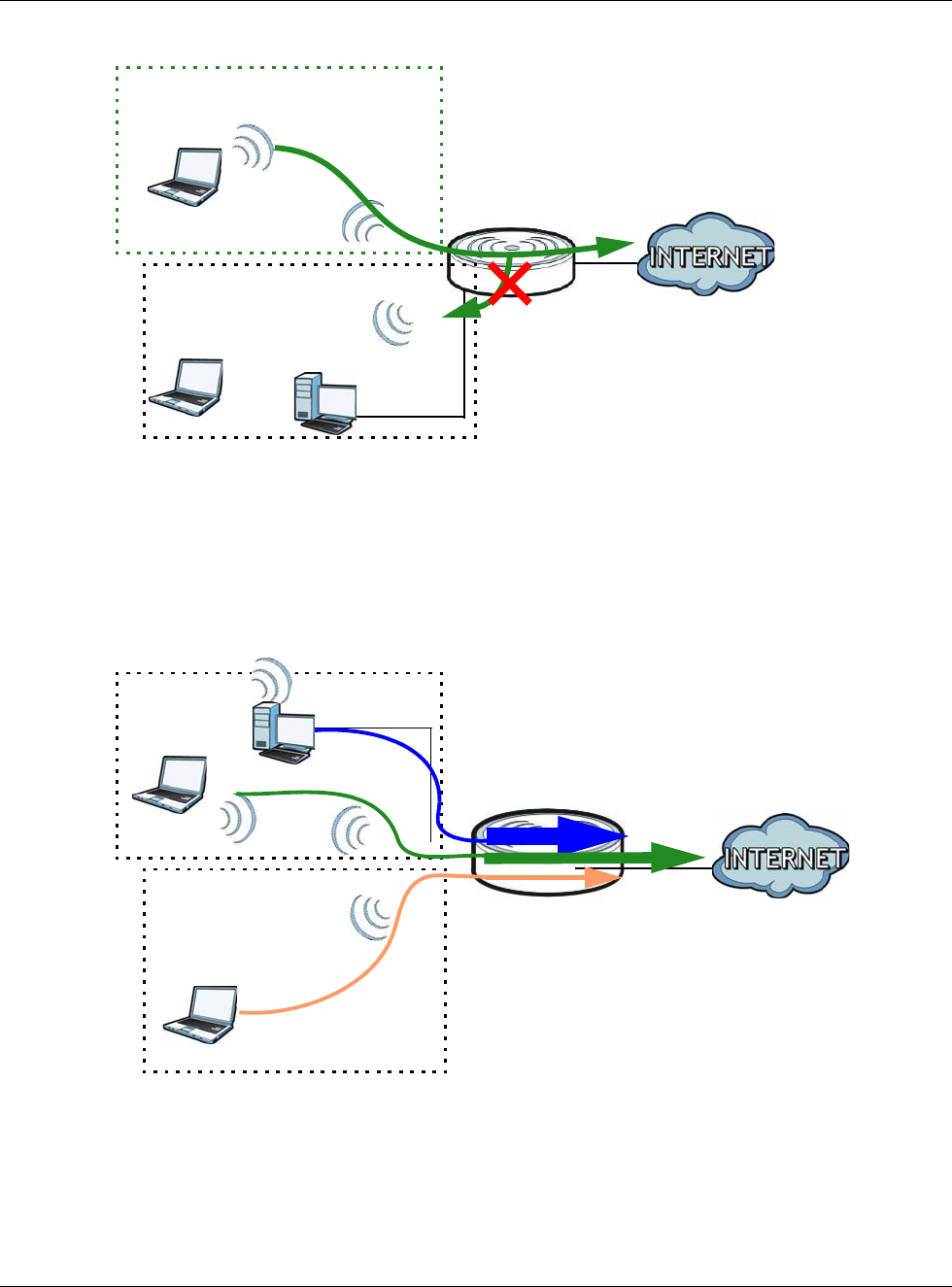
Chapter 11 Wireless LAN
NBG6617 User’s Guide
84
Figure 49 Guest Wireless LAN Network
Guest WLAN Bandwidth
The Guest WLAN Bandwidth function allows you to restrict the maximum bandwidth for the guest
wireless network. Additionally, you can also define bandwidth for your home or office network. An
example is shown next to define maximum bandwidth for your networks (A is Guest WLAN and N is
home or company network.)
Figure 50 Example: Bandwidth for Different Networks
WPS
WiFi Protected Setup (WPS) is an industry standard specification, defined by the WiFi Alliance. WPS
allows you to quickly set up a wireless network with strong security, without having to configure
security settings manually. Depending on the devices in your network, you can either press a
button (on the device itself, or in its configuration utility) or enter a PIN (Personal Identification
N
A
Z
600 kbps
100 kbps
300 kbps
N
A
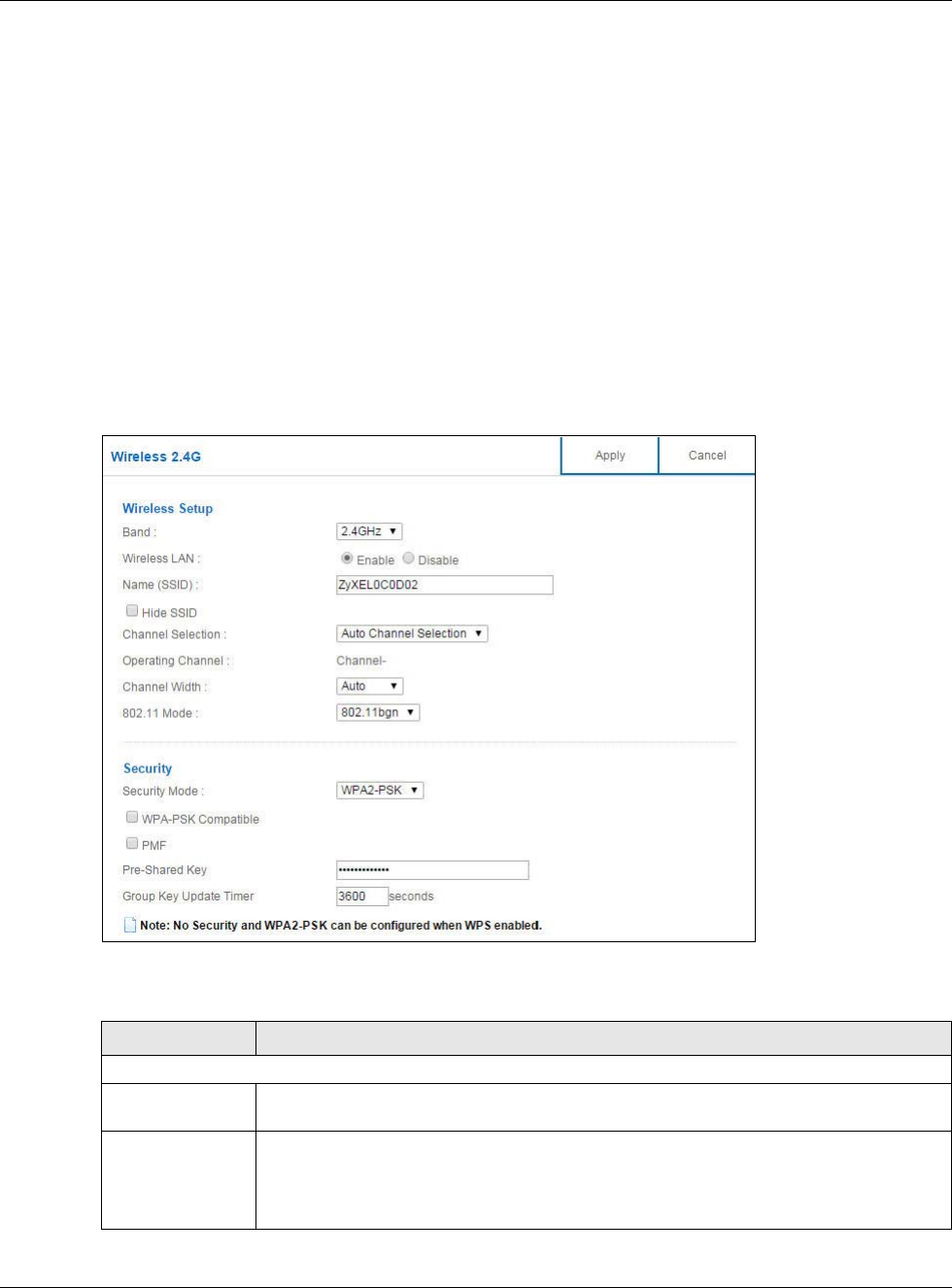
Chapter 11 Wireless LAN
NBG6617 User’s Guide
85
Number) in the devices. Then, they connect and set up a secure network by themselves. See how
to set up a secure wireless network using WPS in the Section 8.2 on page 49.
11.2 Wireless Screen
Use this screen to configure the SSID and wireless security of the NBG6617’s default wireless LAN.
Note: If you are configuring the NBG6617 from a computer connected to the wireless LAN
and you change the NBG6617’s SSID, channel or security settings, you will lose
your wireless connection when you press Apply to confirm. You must then change
the wireless settings of your computer to match the NBG6617’s new settings.
Click Expert Mode > Wireless.
Figure 51 Expert Mode > Wireless
The following table describes the general wireless LAN labels in this screen.
Table 27 Expert Mode > Wireless
LABEL DESCRIPTION
Wireless Setup
Band Select the frequency band to set whether you want to apply the wireless and security
settings to the default 2.4GHz or 5GHz wireless LAN.
Wireless LAN Select Enable to activate the 2.4GHz and/or 5GHz wireless LAN. Select Disable to turn it
off.
You can enable or disable both 2.4GHz and 5GHz wireless LANs by using the WIFI button
located on the rear panel of the NBG6617.

Chapter 11 Wireless LAN
NBG6617 User’s Guide
86
Name (SSID) The SSID (Service Set IDentity) identifies the Service Set with which a wireless client is
associated. Enter a descriptive name (up to 32 printable characters found on a typical
English language keyboard) for the wireless LAN.
Hide SSID Select this check box to hide the SSID in the outgoing beacon frame so a station cannot
obtain the SSID through scanning using a site survey tool.
Channel Selection Select a channel from the drop-down list box. The options vary depending on the
frequency band and the country you are in.
This option is only available if Auto Channel Selection is disabled.
Operating
Channel
This displays the channel the NBG6617 is currently using.
Channel Width Select the wireless channel width used by NBG6617.
A standard 20MHz channel offers transfer speeds of up to 144Mbps (2.4GHz) or 217Mbps
(5GHZ) whereas a 40MHz channel uses two standard channels and offers speeds of up to
300Mbps (2.4GHz) or 450Mbps (5GHZ).
Because not all devices support 40 MHz channels, select Auto 20/40MHz to allow the
NBG6617 to adjust the channel bandwidth automatically.
40MHz (channel bonding or dual channel) bonds two adjacent radio channels to increase
throughput. The wireless clients must also support 40 MHz. It is often better to use the 20
MHz setting in a location where the environment hinders the wireless signal.
Select 20MHz if you want to lessen radio interference with other wireless devices in your
neighborhood or the wireless clients do not support channel bonding.
802.11 Mode If you set Band to 2.4GHz, you can select from the following:
•802.11b: allows either IEEE 802.11b or IEEE 802.11g compliant WLAN devices to
associate with the NBG6617. In this mode, all wireless devices can only transmit at
the data rates supported by IEEE 802.11b.
•802.11g: allows IEEE 802.11g compliant WLAN devices to associate with the Device.
IEEE 802.11b compliant WLAN devices can associate with the NBG6617 only when
they use the short preamble type.
•802.11bg: allows either IEEE 802.11b or IEEE 802.11g compliant WLAN devices to
associate with the NBG6617. The NBG6617 adjusts the transmission rate
automatically according to the wireless standard supported by the wireless devices.
•802.11n: allows IEEE 802.11n compliant WLAN devices to associate with the
NBG6617. This can increase transmission rates, although IEEE 802.11b or IEEE
802.11g clients will not be able to connect to the NBG6617.
•802.11gn: allows either IEEE 802.11g or IEEE 802.11n compliant WLAN devices to
associate with the NBG6617. The transmission rate of your NBG6617 might be
reduced.
•802.11 bgn: allows IEEE802.11b, IEEE802.11g and IEEE802.11n compliant WLAN
devices to associate with the NBG6617. The transmission rate of your NBG6617 might
be reduced.
If you set Band to 5GHz, you can select from the following:
•802.11a: allows only IEEE 802.11a compliant WLAN devices to associate with the
NBG6617.
•802.11a/an: allows both IEEE802.11n and IEEE802.11a compliant WLAN devices to
associate with the NBG6617. The transmission rate of your NBG6617 might be
reduced.
•802.11a/an/ac: allows IEEE802.11n, IEEE802.11a and IEEE 802.11c compliant
WLAN devices to associate with the NBG6617.
Security
Table 27 Expert Mode > Wireless (continued)
LABEL DESCRIPTION
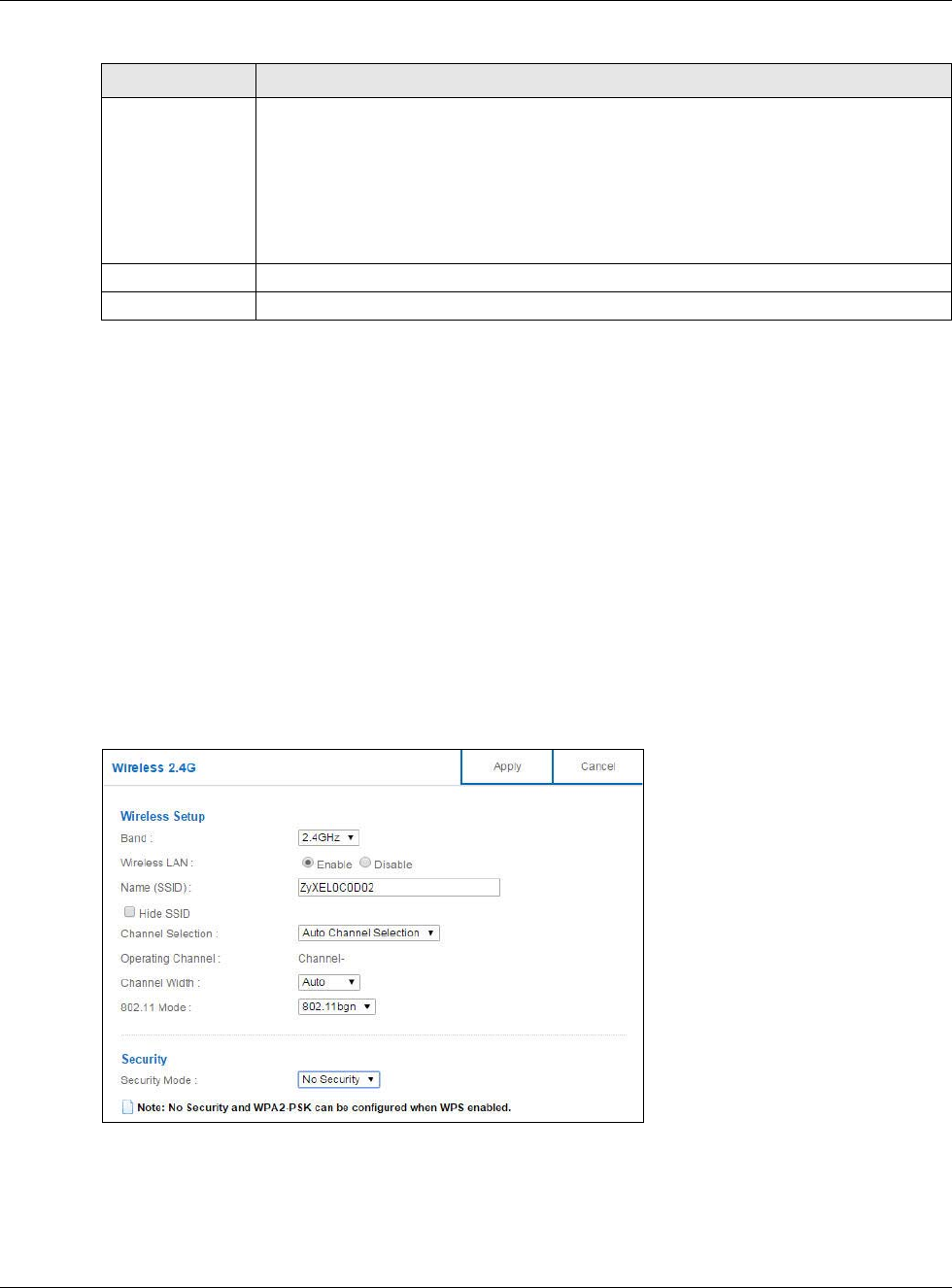
Chapter 11 Wireless LAN
NBG6617 User’s Guide
87
See the rest of this chapter for information on the other labels in this screen.
11.3 Wireless Security
The screen varies depending on what you select in the Security Mode field.
11.3.1 No Security
Select No Security to allow wireless clients to communicate with the access points without any
data encryption.
Note: If you do not enable any wireless security on your NBG6617, your network is
accessible to any wireless networking device that is within range.
Figure 52 Expert Mode > Wireless > Security Mode: No Security
Security Mode Select WPA2-PSK to add security on this wireless network. The wireless clients which
want to associate to this network must have same wireless security settings as this
device. After you select to use a security, additional options appears in this screen. See
Section 11.3 on page 87 for detailed information on different security modes. Or you can
select No Security to allow any client to associate this network without authentication.
Note: If the WPS function is enabled (default), only No Security and WPA2-PSK are
available in this field.
Apply Click Apply to save your changes back to the NBG6617.
Cancel Click Cancel to reload the previous configuration for this screen.
Table 27 Expert Mode > Wireless (continued)
LABEL DESCRIPTION
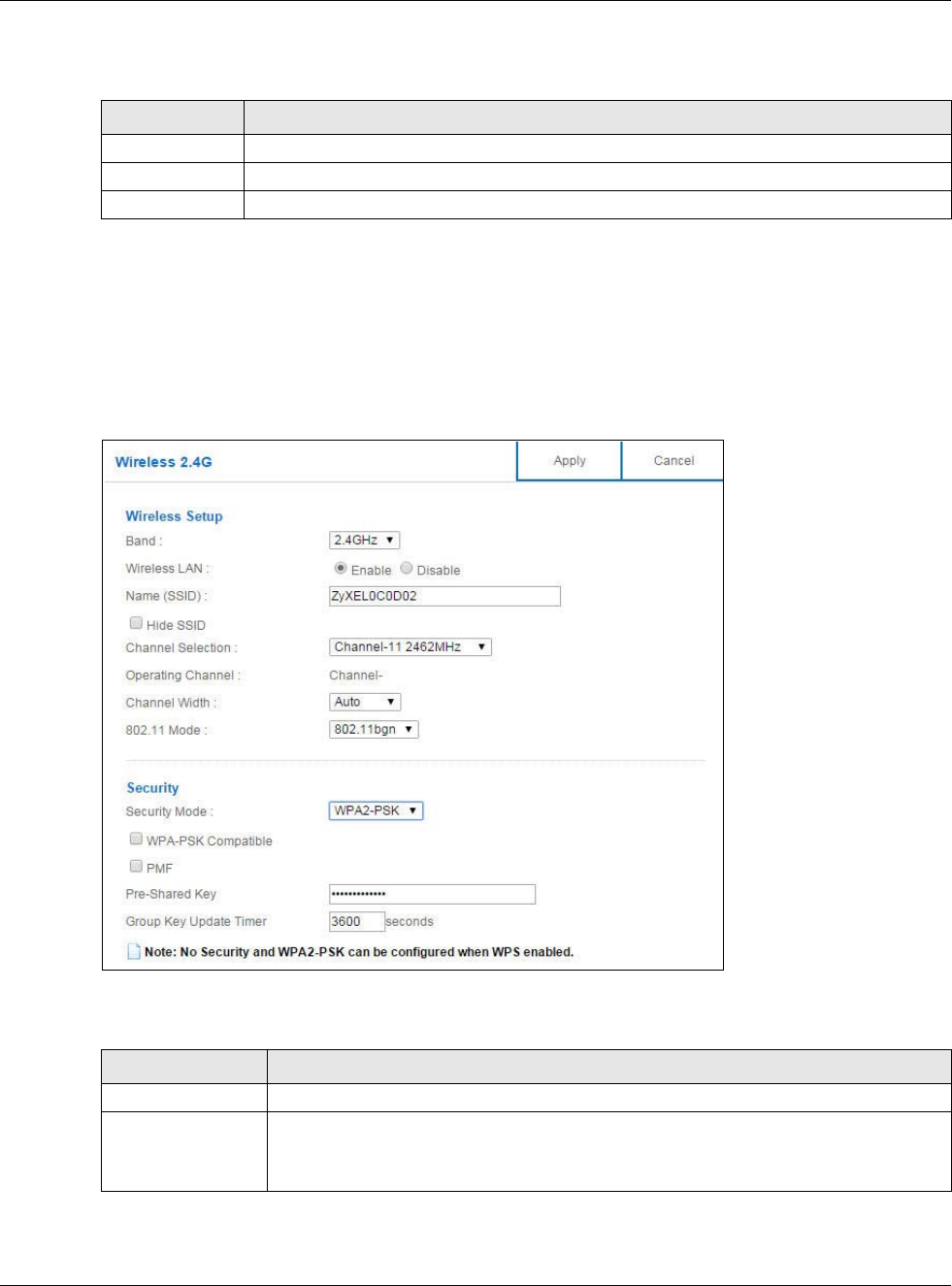
Chapter 11 Wireless LAN
NBG6617 User’s Guide
88
The following table describes the labels in this screen.
11.3.2 WPA-PSK/WPA2-PSK
Select WPA-PSK or WPA2-PSK from the Security Mode list.
Note: WPA-PSK is not available if you enable WPS before you configure WPA-PSK in the
Expert Mode > Wireless > Wireless screen.
Figure 53 Expert Mode > Wireless > Security Mode: WPA-PSK/WPA2-PSK
The following table describes the labels in this screen.
Table 28 Expert Mode > Wireless > Security Mode: No Security
LABEL DESCRIPTION
Security Mode Choose No Security from the drop-down list box.
Apply Click Apply to save your changes back to the NBG6617.
Cancel Click Cancel to reload the previous configuration for this screen.
Table 29 Expert Mode > Wireless > Security Mode: WPA-PSK/WPA2-PSK
LABEL DESCRIPTION
Security Mode Select WPA-PSK or WPA2-PSK to enable data encryption.
WPA-PSK
Compatible
This field appears when you choose WPA2-PSK as the Security Mode.
Check this field to allow wireless devices using WPA-PSK security mode to connect to
your NBG6617.

Chapter 11 Wireless LAN
NBG6617 User’s Guide
89
11.3.3 WPA/WPA2
Select WPA or WPA2 from the Security Mode list.
Note: WPA or WPA2 is not available if you enable WPS before you configure WPA or WPA2
in the Expert Mode > Wireless > Wireless screen.
PMF Protected Management Frames (PMF) is a protection mechanism of action management
frames.
Check this field to allow wireless devices using the PMF protection mechanism to
connect to your NBG6617.
Pre-Shared Key WPA-PSK/WPA2-PSK uses a simple common password for authentication.
Type a pre-shared key from 8 to 63 case-sensitive keyboard characters.
Group Key Update
Timer
The Group Key Update Timer is the rate at which the AP sends a new group key out to
all clients.
The default is 3600 seconds (60 minutes).
Apply Click Apply to save your changes back to the NBG6617.
Cancel Click Cancel to reload the previous configuration for this screen.
Table 29 Expert Mode > Wireless > Security Mode: WPA-PSK/WPA2-PSK (continued)
LABEL DESCRIPTION
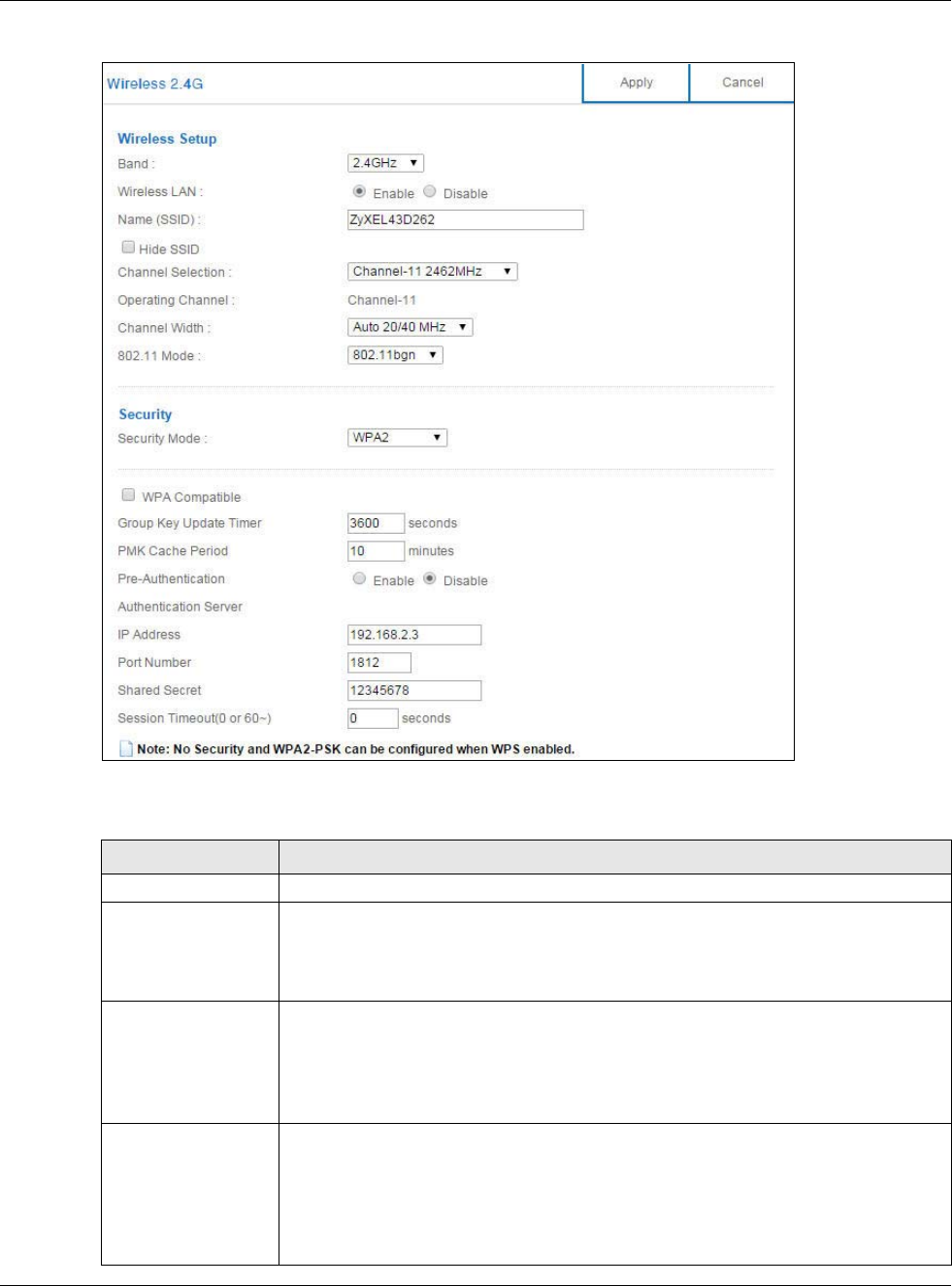
Chapter 11 Wireless LAN
NBG6617 User’s Guide
90
Figure 54 Expert Mode > Wireless > Security Mode: WPA/WPA2
The following table describes the labels in this screen.
Table 30 Expert Mode > Wireless > Security Mode: WPA/WPA2
LABEL DESCRIPTION
Security Mode Select WPA or WPA2 to enable data encryption.
WPA Compatible This check box is available only when you select WPA2-PSK or WPA2 in the Security
Mode field.
Select the check box to have both WPA2 and WPA wireless clients be able to
communicate with the NBG6617 even when the NBG6617 is using WPA2-PSK or WPA2.
Group Key Update
Timer
The Group Key Update Timer is the rate at which the AP (if using WPA-PSK/
WPA2-PSK key management) or RADIUS server (if using WPA/WPA2 key
management) sends a new group key out to all clients. The re-keying process is the
WPA/WPA2 equivalent of automatically changing the WEP key for an AP and all
stations in a WLAN on a periodic basis. Setting of the Group Key Update Timer is
also supported in WPA-PSK/WPA2-PSK mode.
PMK Cache Period This field is available only when you select WPA2.
Specify how often wireless clients have to resend usernames and passwords in order
to stay connected. Enter a time interval between 10 and 999999 minutes.
Note: If wireless client authentication is done using a RADIUS server, the
reauthentication timer on the RADIUS server has priority.

Chapter 11 Wireless LAN
NBG6617 User’s Guide
91
11.4 Guest Wireless Screen
This screen allows you to enable and configure multiple guest wireless network settings on the
NBG6617.
You can configure up to four SSIDs to enable multiple BSSs (Basic Service Sets) on the NBG6617.
This allows you to use one access point to provide several BSSs simultaneously. You can then
assign varying security types to different SSIDs. Wireless clients can use different SSIDs to
associate with the same access point.
Click Expert Mode > Wireless > Guest Wireless. The following screen displays.
Figure 55 Expert Mode > Wireless > Guest Wireless
Pre-Authentication This field is available only when you select WPA2.
Pre-authentication enables fast roaming by allowing the wireless client (already
connecting to an AP) to perform IEEE 802.1x authentication with another AP before
connecting to it. Select Enable to turn on preauthentication in WAP2. Otherwise,
select Disable.
Authentication Server
IP Address Enter the IP address of the external authentication server in dotted decimal notation.
Port Number Enter the port number of the external authentication server.
You need not change this value unless your network administrator instructs you to do
so with additional information.
Shared Secret Enter a password (up to 127 alphanumeric characters) as the key to be shared
between the external authentication server and the NBG6617.
The key must be the same on the external authentication server and your NBG6617.
The key is not sent over the network.
Session Timeout The NBG6617 automatically disconnects a wireless client from the wireless and wired
networks after a period of inactivity. The wireless client needs to send the username
and password again before it can use the wireless and wired networks again. Some
wireless clients may prompt users for a username and password; other clients may
use saved login credentials. In either case, there is usually a short delay while the
wireless client logs in to the wireless network again.
Enter the time in seconds from 0 to 999999.
Apply Click Apply to save your changes back to the NBG6617.
Cancel Click Cancel to reload the previous configuration for this screen.
Table 30 Expert Mode > Wireless > Security Mode: WPA/WPA2 (continued)
LABEL DESCRIPTION
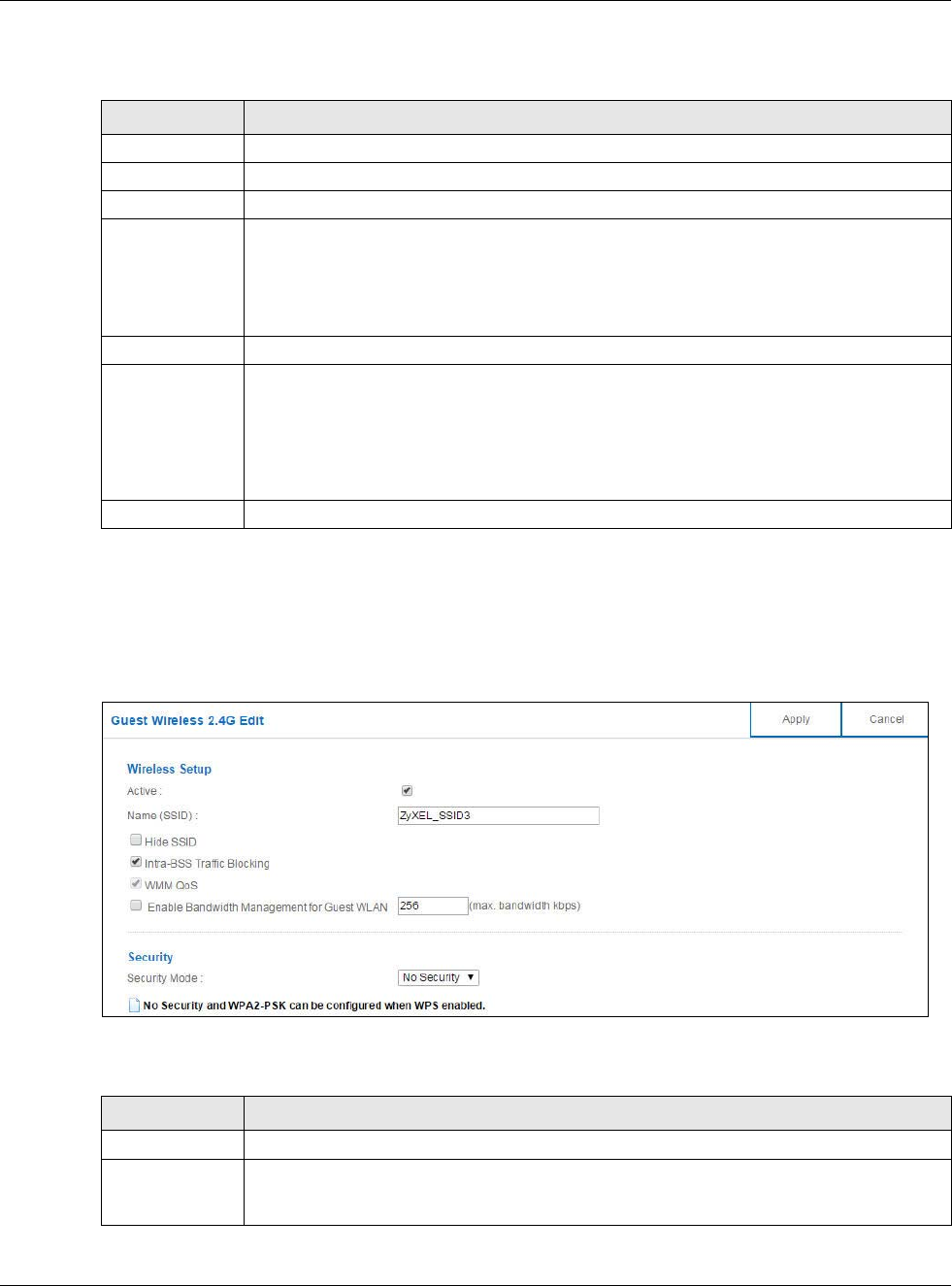
Chapter 11 Wireless LAN
NBG6617 User’s Guide
92
The following table describes the labels in this screen.
11.4.1 Guest Wireless Edit
Use this screen to edit an SSID profile. Click the Edit icon next to an SSID in the Guest Wireless
screen. The following screen displays.
Figure 56 Expert Mode > Wireless > Guest Wireless > Guest Wireless Setup: Edit
The following table describes the labels in this screen.
Table 31 Expert Mode > Wireless > Guest Wireless
LABEL DESCRIPTION
Band Use 2.4GHz or 5GHz to set up the NBG6617’s guest Wi-Fi network.
#This is the index number of each SSID profile.
Status This shows whether the SSID profile is active (a yellow bulb) or not (a gray bulb).
SSID An SSID profile is the set of parameters relating to one of the NBG6617’s BSSs. The SSID
(Service Set IDentifier) identifies the Service Set with which a wireless device is associated.
This field displays the name of the wireless profile on the network. When a wireless client
scans for an AP to associate with, this is the name that is broadcast and seen in the
wireless client utility.
Security This field indicates the security mode of the SSID profile.
Remaining time If the user is currently not permitted to access the Internet, you can click the Set to allow
access for a specified period of time. A screen then displays allowing you to set how long
(in hours) the user is allowed to access the Internet.
This field displays the amount of Internet access time that remains for each user before the
NBG6617 blocks the user from accessing the Internet.0:0:0 means there is no extra
Internet access time.
Edit Click the Edit icon to configure the SSID profile.
Table 32 Expert Mode > Wireless > Guest Wireless > Guest Wireless Setup: Edit
LABEL DESCRIPTION
Active Select this to activate the SSID profile.
Name (SSID) The SSID (Service Set IDentity) identifies the Service Set with which a wireless client is
associated. Enter a descriptive name (up to 32 printable characters found on a typical
English language keyboard) for the wireless LAN.

Chapter 11 Wireless LAN
NBG6617 User’s Guide
93
11.5 MAC Filter Screen
The MAC filter screen allows you to configure the NBG6617 to give exclusive access to devices
(Allow) or exclude devices from accessing the NBG6617 (Deny). Every Ethernet device has a
unique MAC (Media Access Control) address. The MAC address is assigned at the factory and
consists of six pairs of hexadecimal characters, for example, 00:A0:C5:00:00:02. You need to know
the MAC address of the devices to configure this screen.
To change your NBG6617’s MAC filter settings, click Expert Mode > Wireless > MAC Filter. The
screen appears as shown.
Hide SSID Select this check box to hide the SSID in the outgoing beacon frame so a station cannot
obtain the SSID through scanning using a site survey tool.
Intra-BSS Traffic
Blocking
A Basic Service Set (BSS) exists when all communications between wireless clients or
between a wireless client and a wired network client go through one access point (AP).
Intra-BSS traffic is traffic between wireless clients in the BSS. When Intra-BSS is enabled,
wireless clients can access the wired network and communicate with each other. When
Intra-BSS is disabled, wireless clients can still access the wired network but cannot
communicate with each other.
WMM QoS Check this to have the NBG6617 automatically give a service a priority level according to
the ToS value in the IP header of packets it sends.
WMM QoS (Wifi MultiMedia Quality of Service) gives high priority to voice and video, which
makes them run more smoothly.
Enable
Bandwidth
Management for
Guest WLAN
Select this to turn on bandwidth management for the Guest Wi-Fi network.
Maximum
Bandwidth
Enter a number to specify maximum bandwidth the Guest Wi-Fi network can use.
Security Mode Select WPA-PSK or WPA2-PSK to add security on this wireless network. The wireless
clients which want to associate to this network must have same wireless security settings
as this device. After you select to use a security, additional options appears in this screen.
See Section 11.3 on page 87 for detailed information on different security modes. Or you
can select No Security to allow any client to associate this network without authentication.
Note: If the WPS function is enabled (default), only No Security and WPA2-PSK are
available in this field.
Apply Click Apply to save your changes back to the NBG6617.
Cancel Click Cancel to reload the previous configuration for this screen.
Table 32 Expert Mode > Wireless > Guest Wireless > Guest Wireless Setup: Edit (continued)
LABEL DESCRIPTION
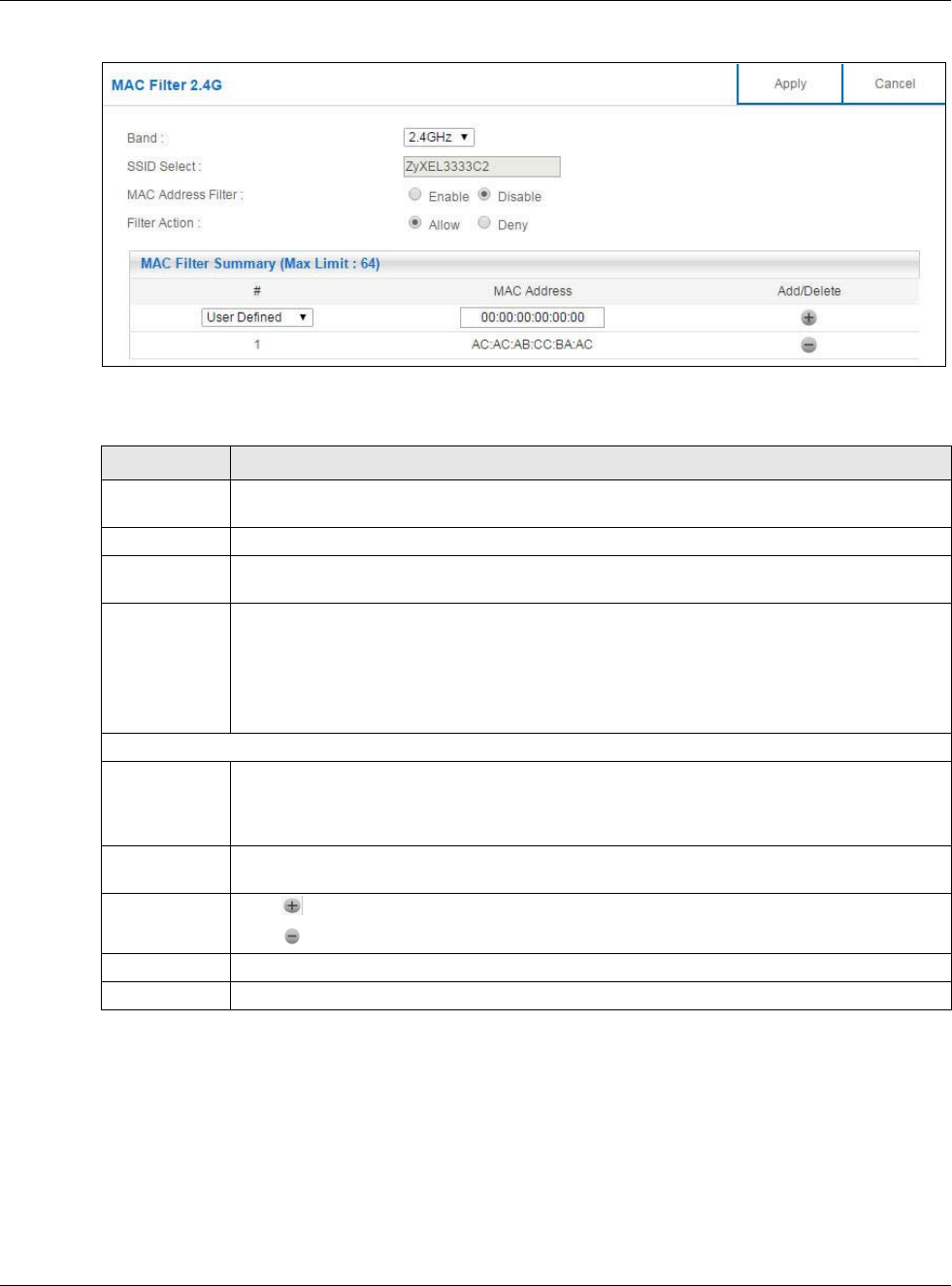
Chapter 11 Wireless LAN
NBG6617 User’s Guide
94
Figure 57 Expert Mode > Wireless > MAC Filter
The following table describes the labels in this menu.
11.6 Advanced Screen
Use this screen to allow wireless advanced features, such as the output power, RTS/CTS Threshold
settings.
Click Expert Mode > Wireless > Advanced. The screen appears as shown.
Table 33 Expert Mode > Wireless > MAC Filter
LABEL DESCRIPTION
Band Select the frequency band to set whether you want to apply the wireless and security
settings to the default 2.4GHz or 5GHz wireless LAN.
SSID Select This shows the SSID for which you are configuring MAC filtering.
MAC Address
Filter
Select to turn on (Enable) or off (Disable) MAC address filtering.
Filter Action Define the filter action for the list of MAC addresses in the MAC Filter Summary table.
Select Allow to permit access to the NBG6617, MAC addresses not listed will be denied
access to the NBG6617.
Select Deny to block access to the NBG6617, MAC addresses not listed will be allowed to
access the NBG6617.
MAC Filter Summary (Max Limit : 64)
#This is the index number of the MAC address. Select Auto Detection to automatically detect
the MAC address of the wireless station that are allowed or denied access to the NBG6617.
Otherwise, select User define to enter the MAC address of the wireless station in the MAC
Address field that are allowed or denied access to the NBG6617.
MAC Address This field displays the MAC address of the wireless station. If you select User define in the #
field, enter the MAC address(es) manually.
Add/Delete Click to add the rule in the MAC filter summary table.
Click to remove a rule.
Apply Click Apply to save your changes back to the NBG6617.
Cancel Click Cancel to reload the previous configuration for this screen.
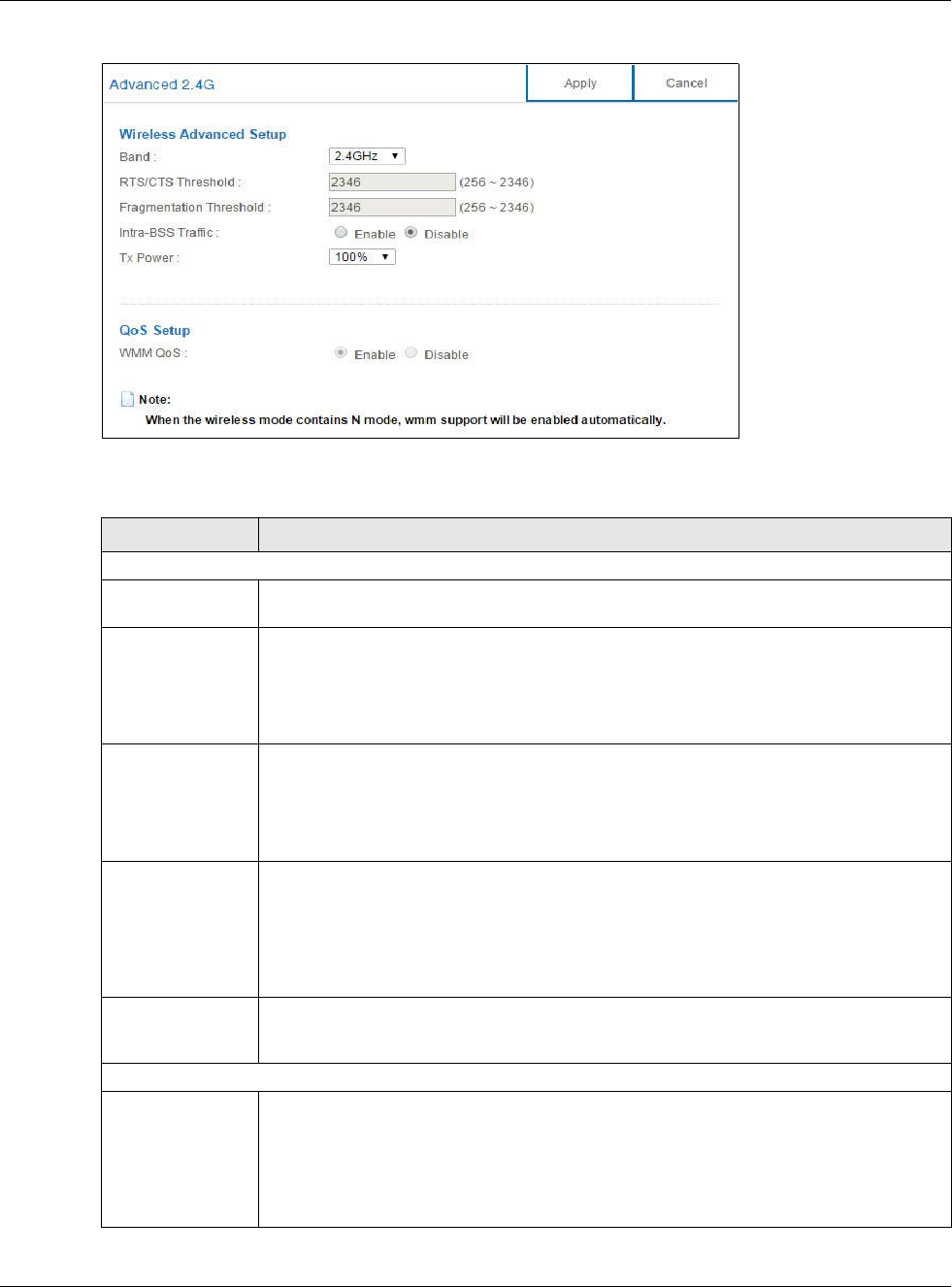
Chapter 11 Wireless LAN
NBG6617 User’s Guide
95
Figure 58 Expert Mode > Wireless > Advanced
The following table describes the labels in this screen.
Table 34 Expert Mode > Wireless > Advanced
LABEL DESCRIPTION
Wireless Advanced Setup
Band Select the frequency band to set whether you want to apply the wireless and security
settings to the default 2.4GHz or 5GHz wireless LAN.
RTS/CTS
Threshold
Data with its frame size larger than this value will perform the RTS (Request To Send)/
CTS (Clear To Send) handshake.
This field is not configurable and the NBG6617 automatically changes to use the
maximum value if you select 802.11n, 802.11an, 802.11gn or 802.11bgn in the
Expert > Wireless screen.
Fragmentation
Threshold
The threshold (number of bytes) for the fragmentation boundary for directed messages.
It is the maximum data fragment size that can be sent.
This field is not configurable and the NBG6617 automatically changes to use the
maximum value if you select 802.11n, 802.11an, 802.11gn or 802.11bgn in the
Expert > Wireless screen.
Intra-BSS Traffic A Basic Service Set (BSS) exists when all communications between wireless clients or
between a wireless client and a wired network client go through one access point (AP).
Intra-BSS traffic is traffic between wireless clients in the BSS. When you Enable Intra-
BSS, wireless clients can access the wired network and communicate with each other.
When you Disable Intra-BSS, wireless clients can still access the wired network but
cannot communicate with each other.
Tx Power Set the output power of the NBG6617 in this field. If there is a high density of APs in an
area, decrease the output power of the NBG6617 to reduce interference with other APs.
Select one of the following 100%, 90%, 75%, 50%, 25% or 10%.
QoS Setup
WMM QoS Select Enable to have the NBG6617 automatically give a service a priority level
according to the ToS value in the IP header of packets it sends. WMM QoS (Wifi
MultiMedia Quality of Service) gives high priority to voice and video, which makes them
run more smoothly.
This field is not configurable and the NBG6617 automatically enables WMM QoS if you
select 802.11n, 802.11an, 802.11gn or 802.11bgn in the Expert > Wireless screen.
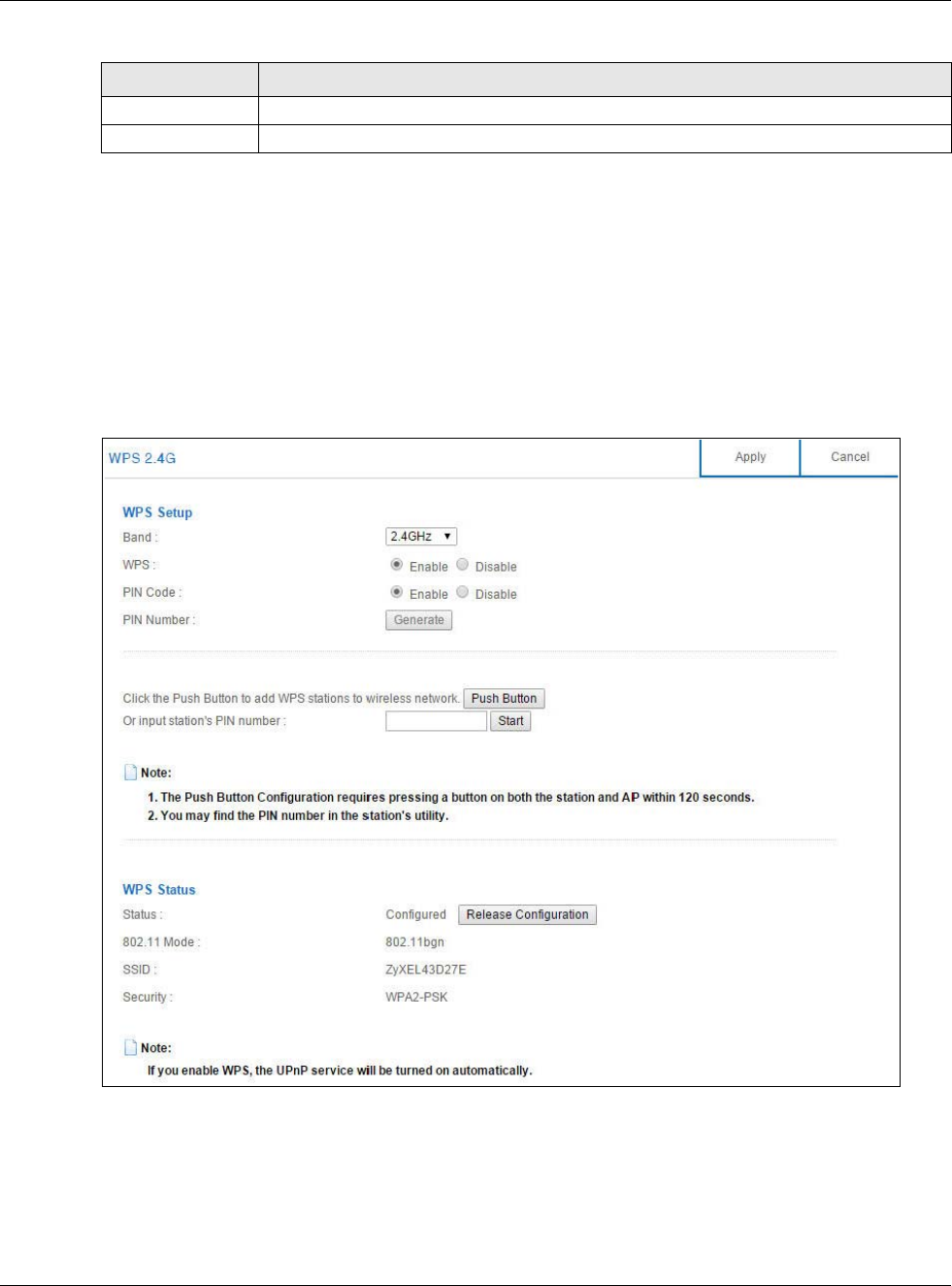
Chapter 11 Wireless LAN
NBG6617 User’s Guide
96
11.7 WPS Screen
Use this screen to enable/disable WPS, view or generate a new PIN number and check current WPS
status. To open this screen, click Expert Mode > Wireless > WPS.
Note: With WPS, wireless clients can only connect to the wireless network using the first
SSID on the NBG6617.
Figure 59 Expert Mode > Wireless > WPS
Apply Click Apply to save your changes back to the NBG6617.
Cancel Click Cancel to reload the previous configuration for this screen.
Table 34 Expert Mode > Wireless > Advanced (continued)
LABEL DESCRIPTION

Chapter 11 Wireless LAN
NBG6617 User’s Guide
97
The following table describes the labels in this screen.
11.8 Scheduling Screen
Use this screen to set the times your wireless LAN is turned on and off. Wireless LAN scheduling is
disabled by default. The wireless LAN can be scheduled to turn on or off on certain days and at
certain times. To open this screen, click Expert Mode > Wireless > Scheduling.
Table 35 Expert Mode > Wireless > WPS
LABEL DESCRIPTION
WPS Setup
Band Select the frequency band to set whether you want to apply the wireless and security
settings to the default 2.4GHz or 5GHz wireless LAN.
WPS Select Enable to turn on the WPS feature. Otherwise, select Disable.
PIN Code Select Enable and click Apply to allow the PIN Configuration method. If you select
Disable, you cannot create a new PIN number.
PIN Number This is the WPS PIN (Personal Identification Number) of the NBG6617. Enter this PIN in
the configuration utility of the device you want to connect to the NBG6617 using WPS.
The PIN is not necessary when you use WPS push-button method.
Click Generate to generate a new PIN number.
Push Button Use this button when you use the PBC (Push Button Configuration) method to configure
wireless stations’s wireless settings.
Click this to start WPS-aware wireless station scanning and the wireless security
information synchronization.
Or input station’s
PIN number
Use this button when you use the PIN Configuration method to configure wireless
station’s wireless settings.
Type the same PIN number generated in the wireless station’s utility. Then click Start to
associate to each other and perform the wireless security information synchronization.
WPS Status
Status This displays Configured when the NBG6617 has connected to a wireless network using
WPS or when WPS Enable is selected and wireless or wireless security settings have
been changed. The current wireless and wireless security settings also appear in the
screen.
This displays Unconfigured if WPS is disabled and there are no wireless or wireless
security changes on the NBG6617 or you click Release Configuration to remove the
configured wireless and wireless security settings.
Release
Configuration
This button is only available when the WPS status displays Configured.
Click this button to remove all configured wireless and wireless security settings for WPS
connections on the NBG6617.
802.11 Mode This is the 802.11 mode used. Only compliant WLAN devices can associate with the
NBG6617.
SSID This is the name of the wireless network (the NBG6617’s first SSID).
Security This is the type of wireless security employed by the network.
Apply Click Apply to save your changes back to the NBG6617.
Cancel Click Cancel to reload the previous configuration for this screen.
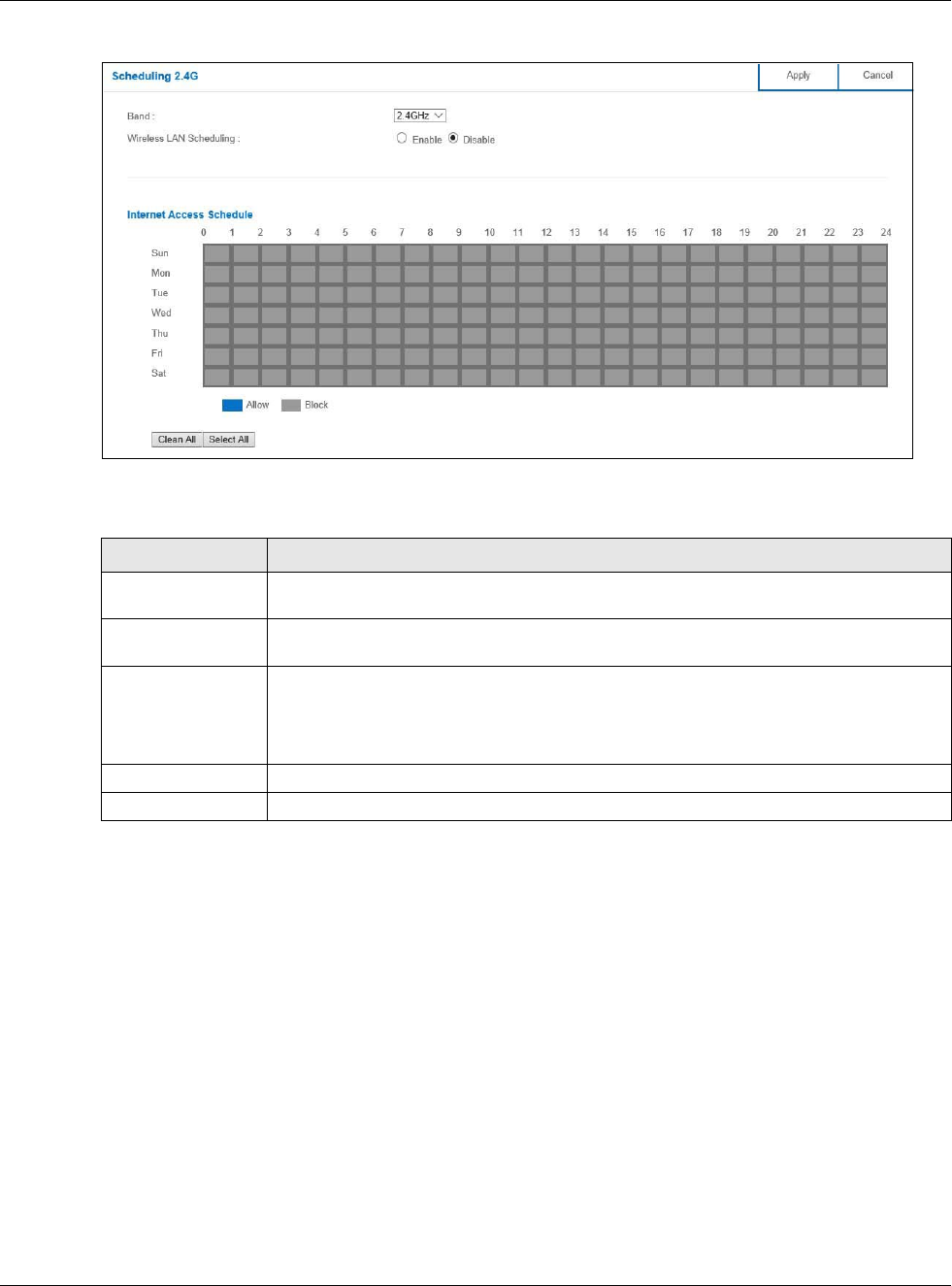
Chapter 11 Wireless LAN
NBG6617 User’s Guide
98
Figure 60 Expert Mode > Wireless > Scheduling
The following table describes the labels in this screen.
Table 36 Expert Mode > Wireless > Scheduling
LABEL DESCRIPTION
Band Select the frequency band to set whether you want to apply the wireless and security
settings to the default 2.4GHz or 5GHz wireless LAN.
Wireless LAN
Scheduling
Select Enable to activate the wireless LAN scheduling feature. Select Disable to turn it
off.
Internet Access
Schedule
The y-axis shows the time period in days. The x-axis shows the time period in hours.
Click Select All or click gray blocks to specify days and times to turn the Wireless LAN
on or off. If you click Select All you can not select any specific days and times. Click
Clean All to remove all the wireless LAN scheduling.
Apply Click Apply to save your changes back to the NBG6617.
Cancel Click Cancel to reload the previous configuration for this screen.